

The Ultimate Guide to Sail Boat Designs: Exploring Sail Shape, Masts and Keel Types in 2023
- June 4, 2023
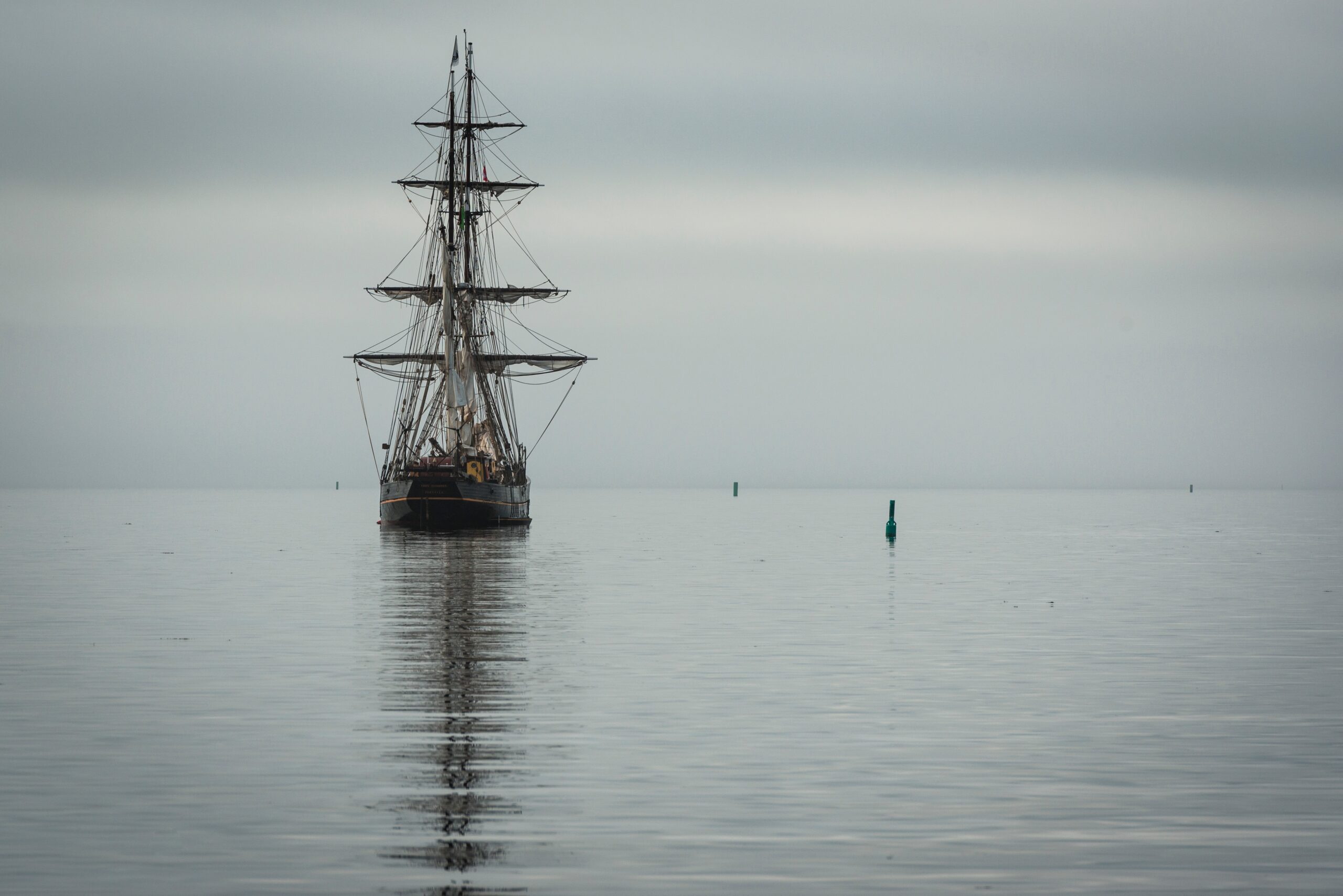
When it comes to sail boat designs, there is a wide array of options available, each with its own unique characteristics and advantages. From the shape of the sails to the number of masts and the type of keel, every aspect plays a crucial role in determining a sailboat’s performance, stability, and manoeuvrability. In this comprehensive guide, we will delve into the fascinating world of sail boat designs, exploring the various elements and their significance.
Table of Contents
The sail shape is a fundamental aspect of sail boat design, directly impacting its speed, windward performance, and maneuverability. There are several types of sail shapes, including:
1. Bermuda Rig:
The Bermuda rig is a widely used sail shape known for its versatility and performance. It features a triangular mainsail and a jib, offering excellent maneuverability and the ability to sail close to the wind. The Bermuda rig’s design allows for efficient use of wind energy, enabling sailboats to achieve higher speeds. The tall, triangular mainsail provides a larger surface area for capturing the wind, while the jib helps to balance the sail plan and optimize performance. This rig is commonly found in modern recreational sailboats and racing yachts. Its sleek and streamlined appearance adds to its aesthetic appeal, making it a popular choice among sailors of all levels of experience.
2. Gaff Rig:
The Gaff rig is a classic sail shape that exudes elegance and nostalgia. It features a four-sided mainsail with a gaff and a topsail, distinguishing it from other sail designs. The gaff, a horizontal spar, extends diagonally from the mast, providing additional area for the mainsail. This configuration allows for a taller and more powerful sail, making the Gaff rig particularly suited for downwind sailing. The Gaff rig offers a traditional aesthetic and is often found in vintage and classic sailboats, evoking a sense of nostalgia for a bygone era of maritime exploration. The distinctive shape of the Gaff rig, with its graceful curves and intricate rigging, adds a touch of timeless charm to any sailboat that dons this rig.
3. Lateen Rig:
The Lateen rig is a unique and versatile sail design that has been used for centuries in various parts of the world. It features a triangular sail that is rigged on a long yard, extending diagonally from the mast. This configuration allows for easy adjustment of the sail’s angle to catch the wind efficiently, making the Lateen rig suitable for a wide range of wind conditions. The Lateen rig is known for its ability to provide both power and maneuverability, making it ideal for small to medium-sized sailboats and traditional vessels like dhow boats. Its versatility allows sailors to navigate narrow waterways and make tight turns with ease. The distinctive silhouette of a sailboat with a Lateen rig, with its sleek triangular sail and graceful curves, evokes a sense of adventure and a connection to seafaring traditions from around the world.
Number of Masts
The number of masts in a sail boat design affects its stability, sail area, and overall performance. Let’s explore a few common configurations:
1. Sloop Rig:
The sloop rig is one of the most popular and versatile sail boat designs, favoured by sailors around the world. It consists of a single mast and two sails—a mainsail and a jib. The sloop rig offers simplicity, ease of handling, and excellent performance across various wind conditions. The mainsail, situated behind the mast, provides the primary driving force, while the jib helps to balance the sail plan and improve manoeuvrability. This configuration allows for efficient upwind sailing, as the sails can be trimmed independently to optimize performance. The sloop rig is commonly found in modern recreational sailboats due to its versatility, enabling sailors to enjoy cruising, racing, or day sailing with ease. Its streamlined design and sleek appearance on the water make it both aesthetically pleasing and efficient, capturing the essence of the sailing experience.
2. Cutter Rig:
The cutter rig is a versatile and robust sail boat design that offers excellent performance, especially in challenging weather conditions. It features a single mast and multiple headsails, typically including a larger headsail forward of the mast, known as the cutter rig’s distinguishing feature. This configuration provides a wide range of sail combinations, enabling sailors to adjust the sail plan to suit varying wind strengths and directions. The larger headsail enhances the boat’s downwind performance, while the smaller headsails offer increased flexibility and improved balance. The cutter rig excels in heavy weather, as it allows for easy reefing and depowering by simply reducing or eliminating the headsails. This design is commonly found in offshore cruising sailboats and has a strong reputation for its reliability and seaworthiness. The cutter rig combines versatility, stability, and the ability to handle adverse conditions, making it a preferred choice for sailors seeking both performance and safety on their voyages.
3. Ketch Rig:
The Ketch rig is a sail boat design characterized by the presence of two masts, with the main mast being taller than the mizzen mast. This configuration offers a divided sail plan, providing sailors with increased flexibility, balance, and versatility. The main advantage of the Ketch rig is the ability to distribute the sail area across multiple sails, allowing for easier handling and reduced stress on each individual sail. The mizzen mast, positioned aft of the main mast, helps to improve the sailboat’s balance, especially in strong winds or when sailing downwind. The Ketch rig is often favoured by cruisers and long-distance sailors as it provides a range of sail combinations suitable for various wind conditions. With its distinctive double-mast appearance, the Ketch rig exudes a classic charm and is well-regarded for its stability, comfort, and suitability for extended journeys on the open seas.
The keel is the part of the sail boat that provides stability and prevents drifting sideways due to the force of the wind. Here are some common keel types:
1. Fin Keel:
The fin keel is a popular keel type in sail boat design known for its excellent upwind performance and stability. It is a long, narrow keel that extends vertically from the sailboat’s hull, providing a substantial amount of ballast to counterbalance the force of the wind. The fin keel’s streamlined shape minimizes drag and enables the sailboat to cut through the water with efficiency. This design enhances the sailboat’s ability to sail close to the wind, making it ideal for racing and performance-oriented sailboats. The fin keel also reduces leeway, which refers to the sideways movement of the boat caused by the wind. This improves the sailboat’s ability to maintain a straight course and enhances overall manoeuvrability. Sailboats with fin keels are commonly found in coastal and offshore racing as well as cruising vessels, where stability and responsiveness are valued. The fin keel’s combination of performance, stability, and reduced leeway makes it a preferred choice for sailors seeking speed and agility on the water.
2. Full Keel:
The full keel is a design known for its exceptional stability and seaworthiness. It extends along the entire length of the sailboat, providing a continuous surface that adds substantial weight and ballast. This configuration offers significant advantages in terms of tracking and resistance to drifting sideways. The full keel’s deep draft helps to prevent leeway and allows the sailboat to maintain a steady course even in adverse conditions. Its robust construction enhances the sailboat’s ability to handle heavy seas and provides a comfortable ride for sailors on extended journeys. While full keel sailboats may sacrifice some manoeuvrability, their stability and predictable handling make them a popular choice for offshore cruising and long-distance voyages. The full keel design has stood the test of time and is often associated with classic and traditional sailboat aesthetics, appealing to sailors seeking reliability, comfort, and the ability to tackle challenging ocean passages with confidence.
3. Wing Keel:
The wing keel is a unique keel design that offers a combination of reduced draft and improved stability. It features a bulbous extension or wings on the bottom of the keel, which effectively increases the keel’s surface area. This design allows sailboats to navigate in shallower waters without sacrificing stability and performance. The wings create additional lift and prevent excessive leeway, enhancing the sailboat’s upwind capabilities. The reduced draft of the wing keel enables sailors to explore coastal areas and anchor in shallower anchorages that would be inaccessible to sailboats with deeper keels. The wing keel is particularly well-suited for sailboats in areas with variable water depths or tidal ranges. This keel design offers the advantages of increased manoeuvrability and improved performance while maintaining stability, making it a popular choice for sailors seeking versatility in a range of sailing environments.
In the vast world of sail boat designs, sail shape, number of masts, and keel types play pivotal roles in determining a boat’s performance and handling characteristics. Whether you’re a recreational sailor, a racer, or a cruiser, understanding these design elements can help you make informed choices when selecting a sailboat.
Remember to consider your specific needs, preferences, and intended use of the boat when choosing a sail boat design. Each design has its strengths and weaknesses, and finding the perfect combination will greatly enhance your sailing experience.
By gaining a deeper understanding of sail boat designs, you can embark on your next sailing adventure with confidence and make the most of the wind’s power.
Related Posts

Sailing Navigation: Exploring Modern Techniques for Navigating the Seas in 2023
- June 10, 2023
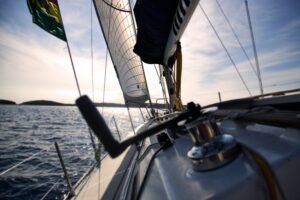
Sailing in Different Directions: Harnessing the Wind’s Power in 2023
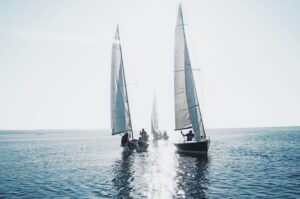
Sailing Terms Demystified: A Comprehensive Guide to 14 Common Sailing Terminology
- May 28, 2023

INTRODUCTION TO SAILBOAT DESIGN: A TECHNICAL EXPLORATION
Sailboat design is a complex and fascinating field that blends engineering, hydrodynamics, and aesthetics to create vessels that harness the power of the wind for propulsion. In this highly technical article, we will delve into the key aspects of sailboat design, from methodology to evaluation.
1) Design Methodology
Designing a sailboat is a meticulous process that begins with defining the vessel’s purpose and performance goals. It involves understanding the intended use, whether it’s racing, cruising, or a combination of both. Sailboat designers must also consider regulatory requirements and safety standards.
Once the design objectives are established, naval architects employ various computational tools and simulations to create a preliminary design. These tools help in predicting the boat’s performance characteristics and optimizing its geometry.
Design methodology also encompasses market research to understand current trends and customer preferences. This information is critical for creating a sailboat that appeals to potential buyers.
2) Hull Design
The hull is the heart of any sailboat. Its shape determines how the boat interacts with the water. Hull design encompasses the choice of hull form, its dimensions, and the material used. The hull’s shape affects its hydrodynamic performance, stability, and overall handling.
For example, a narrow hull design with a deep V-shape is ideal for speed, while a wider, flatter hull provides stability for cruising. The choice of materials, such as fiberglass or aluminum, impacts the boat’s weight and durability.
The hull design is a balance between achieving efficient hydrodynamics and providing interior space for accommodations. As a designer, finding this equilibrium is a constant challenge.
3) Keel & Rudder Design
The keel and rudder are critical components of a sailboat’s underwater structure. The keel provides stability by preventing the boat from tipping over, while the rudder controls its direction. Keel design involves selecting the keel type (fin, bulb, or wing) and optimizing its shape for maximum hydrodynamic efficiency.
Rudder’s design focuses on ensuring precise control and maneuverability. Both components must be carefully integrated into the hull’s design to maintain balance and performance.
Keel and rudder design can be particularly challenging because they influence the boat’s behavior in different ways. A well-designed keel adds stability but also increases draft, limiting where the boat can sail. Rudder design must account for both responsiveness and the risk of stalling at high speeds.
4) Sail & Rig Design
Sail and rig design play a pivotal role in harnessing wind power. Sail choice, size, and shape are tailored to the boat’s intended use and performance goals. Modern sail materials like carbon fiber offer lightweight and durable options.
The rig design involves selecting the type of mast (single or multiple), rigging configuration, and mast height. These choices influence the sailboat’s stability, maneuverability, and ability to handle varying wind conditions.
Balancing the sails and rig for optimal performance is a meticulous task. The sail plan should be designed to efficiently convert wind energy into forward motion while allowing for easy adjustments to adapt to changing conditions.
5) Balance
Balancing a sailboat is crucial for its performance and safety. Achieving the right balance involves a delicate interplay between the hull, keel, rudder, and sail plan. Proper balance ensures the boat remains stable and responds predictably to helm inputs, even in changing wind conditions.
Balance is not a static concept but something that evolves as the boat sails in different wind and sea conditions. Designers must anticipate how changes in load, wind angle, and sail trim will affect the boat’s balance.
Achieving balance is both an art and a science, and it often requires iterative adjustments during the design and testing phases to achieve optimal results.
6) Propulsion
While sailboats primarily rely on wind propulsion, auxiliary propulsion systems like engines are essential for maneuvering in harbors or during calm conditions. Integrating propulsion systems seamlessly into the boat’s design requires careful consideration of engine placement, fuel storage, and exhaust systems.
The choice of propulsion system, whether it’s a traditional diesel engine or a more eco-friendly electric motor, also impacts the boat’s weight distribution and overall performance.
7) Scantling
Scantling refers to the selection of structural components and their dimensions to ensure the boat’s strength and integrity. It involves determining the appropriate thickness of the hull, deck, and other structural elements to withstand the stresses encountered at sea.
Scantling is a critical aspect of sailboat design, as it directly relates to safety. A well-designed boat must be able to withstand the forces exerted on it by waves, wind, and other environmental factors.
8) Stability
Stability is a critical safety factor in sailboat design. Both upright hydrostatics and large-angle stability must be carefully assessed and optimized. This involves evaluating the boat’s center of gravity, ballast, and hull shape.
Achieving the right balance between initial stability, which provides comfort to passengers, and ultimate stability, which ensures safety in adverse conditions, is a delicate task. Designers often use stability curves and computer simulations to fine-tune these characteristics.
9) Layout
The layout of a sailboat’s interior and deck spaces is a blend of functionality and comfort. Designers must consider the ergonomics of living and working aboard the vessel, including cabin layout, galley design, and storage solutions. The deck layout influences crew movements and sail handling.
Layout design also extends to considerations like ventilation, lighting, and noise control. Sailboats are unique in that they must provide both comfortable living spaces and efficient workspaces for handling sails and navigation.
10) Design Evaluation
The final phase of sailboat design involves rigorous evaluation and testing. Computational fluid dynamics (CFD) simulations, tank testing, and real-world sea trials help validate the design’s performance predictions. Any necessary adjustments are made to fine-tune the vessel’s behavior on the water.
The evaluation phase is where the theoretical aspects of design meet the practical realities of the sea. It’s a crucial step in ensuring that the sailboat not only meets but exceeds its performance and safety expectations.
Conclusion:
In conclusion, sailboat design is a highly technical field that requires a deep understanding of hydrodynamics, engineering principles, and materials science. Naval architects and yacht designers meticulously navigate through the intricacies of hull design, keel and rudder configuration, sail and rig design, balance, propulsion, scantling, stability, layout, and design evaluation to create vessels that excel in both form and function. The harmonious integration of these elements results in sailboats that are not just seaworthy but also a joy to sail, and this process is a testament to the art and science of sailboat design.
Click here to read about “ HARNESSING THE POWER OF ARTIFICIAL INTELLIGENCE IN BOAT DESIGN “
Follow my Linkedin Newsletter here: “LinkedIn Newsletter”
0 comments Leave a reply
Save my name, email, and website in this browser for the next time I comment.
Recent Posts
- KEY LESSONS I LEARNED FROM MY FREELANCE JOURNEY IN 2023
- THE FREELANCE ECONOMY: KEY TRENDS AND PREDICTIONS FOR 2024
- THE RISE Of HDPE IN BOAT MANUFACTURING: TRENDS & BENEFITS
- THE CRITICAL ROLE OF FEASIBILITY STUDY IN BOAT DESIGN AND NAVAL ARCHITECTURE
- THE CHALLENGES Of SMALL CRAFT DESIGN COMPARED TO LARGER VESSELS
Recent Comments
- Casey Lim on HDPE BOAT PLANS
- BRYN BONGBONG on HDPE BOAT PLANS
- Keith on HDPE BOAT PLANS
- Daniel Desauriers on WHY HDPE BOATS?
- December 2023
- November 2023
- October 2023
- February 2023
- January 2023
- September 2022
- January 2021
- ARTIFICIAL INTELLIGENCE
- boatbuilder
- BOAT CONSTRUCTION TECHNIQUES
- BOAT DESIGN COST
- boatdesign process
- CAREER PATHWAYS
- COMMERCIAL BOATS
- conventional boats
- custom boat
- DESIGN ADMINISTRATION
- DESIGN SPIRAL
- EXTREME CONDITIONS
- FEASIBILITY STUDY
- Freelance advantage
- freelance boat designer
- FREELANCE ECONOMY
- FREELANCE JOURNEY
- FRP Boat without Mold
- HDPE Collar
- INDIA'S MARITIME
- INVENTORY MANAGEMENT
- ISO STANDARDS
- Mass Production
- Monhull vs Catamaran
- Naval Architect
- Naval Architecture
- PLANING HULL
- Project Management
- Proven Hull
- PSYCHOLOGY OF BOAT DESIGN
- QUALITY CONTROL
- RECREATIONAL BOATS
- RISE OF HDPE
- ROYALTY AGREEMENTS
- SANDWICH VS SINGLE SKIN
- SOLOPRENEUR
- YACHT DESIGN COURSE
The Ultimate Guide to Sail Types and Rigs (with Pictures)
What's that sail for? Generally, I don't know. So I've come up with a system. I'll explain you everything there is to know about sails and rigs in this article.
What are the different types of sails? Most sailboats have one mainsail and one headsail. Typically, the mainsail is a fore-and-aft bermuda rig (triangular shaped). A jib or genoa is used for the headsail. Most sailors use additional sails for different conditions: the spinnaker (a common downwind sail), gennaker, code zero (for upwind use), and stormsail.
Each sail has its own use. Want to go downwind fast? Use a spinnaker. But you can't just raise any sail and go for it. It's important to understand when (and how) to use each sail. Your rigging also impacts what sails you can use.

On this page:
Different sail types, the sail plan of a bermuda sloop, mainsail designs, headsail options, specialty sails, complete overview of sail uses, mast configurations and rig types.
This article is part 1 of my series on sails and rig types. Part 2 is all about the different types of rigging. If you want to learn to identify every boat you see quickly, make sure to read it. It really explains the different sail plans and types of rigging clearly.

Guide to Understanding Sail Rig Types (with Pictures)
First I'll give you a quick and dirty overview of sails in this list below. Then, I'll walk you through the details of each sail type, and the sail plan, which is the godfather of sail type selection so to speak.
Click here if you just want to scroll through a bunch of pictures .
Here's a list of different models of sails: (Don't worry if you don't yet understand some of the words, I'll explain all of them in a bit)
- Jib - triangular staysail
- Genoa - large jib that overlaps the mainsail
- Spinnaker - large balloon-shaped downwind sail for light airs
- Gennaker - crossover between a Genoa and Spinnaker
- Code Zero or Screecher - upwind spinnaker
- Drifter or reacher - a large, powerful, hanked on genoa, but made from lightweight fabric
- Windseeker - tall, narrow, high-clewed, and lightweight jib
- Trysail - smaller front-and-aft mainsail for heavy weather
- Storm jib - small jib for heavy weather
I have a big table below that explains the sail types and uses in detail .
I know, I know ... this list is kind of messy, so to understand each sail, let's place them in a system.
The first important distinction between sail types is the placement . The mainsail is placed aft of the mast, which simply means behind. The headsail is in front of the mast.
Generally, we have three sorts of sails on our boat:
- Mainsail: The large sail behind the mast which is attached to the mast and boom
- Headsail: The small sail in front of the mast, attached to the mast and forestay (ie. jib or genoa)
- Specialty sails: Any special utility sails, like spinnakers - large, balloon-shaped sails for downwind use
The second important distinction we need to make is the functionality . Specialty sails (just a name I came up with) each have different functionalities and are used for very specific conditions. So they're not always up, but most sailors carry one or more of these sails.
They are mostly attached in front of the headsail, or used as a headsail replacement.
The specialty sails can be divided into three different categories:
- downwind sails - like a spinnaker
- light air or reacher sails - like a code zero
- storm sails

The parts of any sail
Whether large or small, each sail consists roughly of the same elements. For clarity's sake I've took an image of a sail from the world wide webs and added the different part names to it:

- Head: Top of the sail
- Tack: Lower front corner of the sail
- Foot: Bottom of the sail
- Luff: Forward edge of the sail
- Leech: Back edge of the sail
- Clew: Bottom back corner of the sail
So now we speak the same language, let's dive into the real nitty gritty.
Basic sail shapes
Roughly speaking, there are actually just two sail shapes, so that's easy enough. You get to choose from:
- square rigged sails
- fore-and-aft rigged sails
I would definitely recommend fore-and-aft rigged sails. Square shaped sails are pretty outdated. The fore-and-aft rig offers unbeatable maneuverability, so that's what most sailing yachts use nowadays.

Square sails were used on Viking longships and are good at sailing downwind. They run from side to side. However, they're pretty useless upwind.
A fore-and-aft sail runs from the front of the mast to the stern. Fore-and-aft literally means 'in front and behind'. Boats with fore-and-aft rigged sails are better at sailing upwind and maneuvering in general. This type of sail was first used on Arabic boats.
As a beginner sailor I confuse the type of sail with rigging all the time. But I should cut myself some slack, because the rigging and sails on a boat are very closely related. They are all part of the sail plan .
A sail plan is made up of:
- Mast configuration - refers to the number of masts and where they are placed
- Sail type - refers to the sail shape and functionality
- Rig type - refers to the way these sails are set up on your boat
There are dozens of sails and hundreds of possible configurations (or sail plans).
For example, depending on your mast configuration, you can have extra headsails (which then are called staysails).
The shape of the sails depends on the rigging, so they overlap a bit. To keep it simple I'll first go over the different sail types based on the most common rig. I'll go over the other rig types later in the article.
Bermuda Sloop: the most common rig
Most modern small and mid-sized sailboats have a Bermuda sloop configuration . The sloop is one-masted and has two sails, which are front-and-aft rigged. This type of rig is also called a Marconi Rig. The Bermuda rig uses a triangular sail, with just one side of the sail attached to the mast.
The mainsail is in use most of the time. It can be reefed down, making it smaller depending on the wind conditions. It can be reefed down completely, which is more common in heavy weather. (If you didn't know already: reefing is skipper terms for rolling or folding down a sail.)
In very strong winds (above 30 knots), most sailors only use the headsail or switch to a trysail.

The headsail powers your bow, the mainsail powers your stern (rear). By having two sails, you can steer by using only your sails (in theory - it requires experience). In any case, two sails gives you better handling than one, but is still easy to operate.
Let's get to the actual sails. The mainsail is attached behind the mast and to the boom, running to the stern. There are multiple designs, but they actually don't differ that much. So the following list is a bit boring. Feel free to skip it or quickly glance over it.
- Square Top racing mainsail - has a high performance profile thanks to the square top, optional reef points
- Racing mainsail - made for speed, optional reef points
- Cruising mainsail - low-maintenance, easy to use, made to last. Generally have one or multiple reef points.
- Full-Batten Cruising mainsail - cruising mainsail with better shape control. Eliminates flogging. Full-length battens means the sail is reinforced over the entire length. Generally have one or multiple reef points.
- High Roach mainsail - crossover between square top racing and cruising mainsail, used mostly on cats and multihulls. Generally have one or multiple reef points.
- Mast Furling mainsail - sails specially made to roll up inside the mast - very convenient but less control; of sail shape. Have no reef points
- Boom Furling mainsail - sails specially made to roll up inside the boom. Have no reef points.
The headsail is the front sail in a front-and-aft rig. The sail is fixed on a stay (rope, wire or rod) which runs forward to the deck or bowsprit. It's almost always triangular (Dutch fishermen are known to use rectangular headsail). A triangular headsail is also called a jib .
Headsails can be attached in two ways:
- using roller furlings - the sail rolls around the headstay
- hank on - fixed attachment
Types of jibs:
Typically a sloop carries a regular jib as its headsail. It can also use a genoa.
- A jib is a triangular staysail set in front of the mast. It's the same size as the fore-triangle.
- A genoa is a large jib that overlaps the mainsail.
What's the purpose of a jib sail? A jib is used to improve handling and to increase sail area on a sailboat. This helps to increase speed. The jib gives control over the bow (front) of the ship, making it easier to maneuver the ship. The mainsail gives control over the stern of the ship. The jib is the headsail (frontsail) on a front-and-aft rig.
The size of the jib is generally indicated by a number - J1, 2, 3, and so on. The number tells us the attachment point. The order of attachment points may differ per sailmaker, so sometimes J1 is the largest jib (on the longest stay) and sometimes it's the smallest (on the shortest stay). Typically the J1 jib is the largest - and the J3 jib the smallest.
Most jibs are roller furling jibs: this means they are attached to a stay and can be reefed down single-handedly. If you have a roller furling you can reef down the jib to all three positions and don't need to carry different sizes.

Originally called the 'overlapping jib', the leech of the genoa extends aft of the mast. This increases speed in light and moderate winds. A genoa is larger than the total size of the fore-triangle. How large exactly is indicated by a percentage.
- A number 1 genoa is typically 155% (it used to be 180%)
- A number 2 genoa is typically 125-140%
Genoas are typically made from 1.5US/oz polyester spinnaker cloth, or very light laminate.

This is where it gets pretty interesting. You can use all kinds of sails to increase speed, handling, and performance for different weather conditions.
Some rules of thumb:
- Large sails are typically good for downwind use, small sails are good for upwind use.
- Large sails are good for weak winds (light air), small sails are good for strong winds (storms).
Downwind sails
Thanks to the front-and-aft rig sailboats are easier to maneuver, but they catch less wind as well. Downwind sails are used to offset this by using a large sail surface, pulling a sailboat downwind. They can be hanked on when needed and are typically balloon shaped.
Here are the most common downwind sails:
- Big gennaker
- Small gennaker
A free-flying sail that fills up with air, giving it a balloon shape. Spinnakers are generally colorful, which is why they look like kites. This downwind sail has the largest sail area, and it's capable of moving a boat with very light wind. They are amazing to use on trade wind routes, where they can help you make quick progress.
Spinnakers require special rigging. You need a special pole and track on your mast. You attach the sail at three points: in the mast head using a halyard, on a pole, and on a sheet.
The spinnaker is symmetrical, meaning the luff is as long as its leech. It's designed for broad reaching.

Gennaker or cruising spinnaker
The Gennaker is a cross between the genoa and the spinnaker. It has less downwind performance than the spinnaker. It is a bit smaller, making it slower, but also easier to handle - while it remains very capable. The cruising spinnaker is designed for broad reaching.
The gennaker is a smaller, asymmetric spinnaker that's doesn't require a pole or track on the mast. Like the spinnaker, and unlike the genoa, the gennaker is set flying. Asymmetric means its luff is longer than its leech.
You can get big and small gennakers (roughly 75% and 50% the size of a true spinnaker).
Also called ...
- the cruising spinnaker
- cruising chute
- pole-less spinnaker
- SpinDrifter
... it's all the same sail.

Light air sails
There's a bit of overlap between the downwind sails and light air sails. Downwind sails can be used as light air sails, but not all light air sails can be used downwind.
Here are the most common light air sails:
- Spinnaker and gennaker
Drifter reacher
Code zero reacher.
A drifter (also called a reacher) is a lightweight, larger genoa for use in light winds. It's roughly 150-170% the size of a genoa. It's made from very lightweight laminated spinnaker fabric (1.5US/oz).
Thanks to the extra sail area the sail offers better downwind performance than a genoa. It's generally made from lightweight nylon. Thanks to it's genoa characteristics the sail is easier to use than a cruising spinnaker.
The code zero reacher is officially a type of spinnaker, but it looks a lot like a large genoa. And that's exactly what it is: a hybrid cross between the genoa and the asymmetrical spinnaker (gennaker). The code zero however is designed for close reaching, making it much flatter than the spinnaker. It's about twice the size of a non-overlapping jib.

A windseeker is a small, free-flying staysail for super light air. It's tall and thin. It's freestanding, so it's not attached to the headstay. The tack attaches to a deck pad-eye. Use your spinnakers' halyard to raise it and tension the luff.
It's made from nylon or polyester spinnaker cloth (0.75 to 1.5US/oz).
It's designed to guide light air onto the lee side of the main sail, ensuring a more even, smooth flow of air.
Stormsails are stronger than regular sails, and are designed to handle winds of over 45 knots. You carry them to spare the mainsail. Sails
A storm jib is a small triangular staysail for use in heavy weather. If you participate in offshore racing you need a mandatory orange storm jib. It's part of ISAF's requirements.
A trysail is a storm replacement for the mainsail. It's small, triangular, and it uses a permanently attached pennant. This allows it to be set above the gooseneck. It's recommended to have a separate track on your mast for it - you don't want to fiddle around when you actually really need it to be raised ... now.

| Sail | Type | Shape | Wind speed | Size | Wind angle |
|---|---|---|---|---|---|
| Bermuda | mainsail | triangular, high sail | < 30 kts | ||
| Jib | headsail | small triangular foresail | < 45 kts | 100% of foretriangle | |
| Genoa | headsail | jib that overlaps mainsail | < 30 kts | 125-155% of foretriangle | |
| Spinnaker | downwind | free-flying, balloon shape | 1-15 kts | 200% or more of mainsail | 90°–180° |
| Gennaker | downwind | free-flying, balloon shape | 1-20 kts | 85% of spinnaker | 75°-165° |
| Code Zero or screecher | light air & upwind | tight luffed, upwind spinnaker | 1-16 kts | 70-75% of spinnaker | |
| Storm Trysail | mainsail | small triangular mainsail replacement | > 45 kts | 17.5% of mainsail | |
| Drifter reacher | light air | large, light-weight genoa | 1-15 kts | 150-170% of genoa | 30°-90° |
| Windseeker | light air | free-flying staysail | 0-6 kts | 85-100% of foretriangle | |
| Storm jib | strong wind headsail | low triangular staysail | > 45 kts | < 65% height foretriangle |
Why Use Different Sails At All?
You could just get the largest furling genoa and use it on all positions. So why would you actually use different types of sails?
The main answer to that is efficiency . Some situations require other characteristics.
Having a deeply reefed genoa isn't as efficient as having a small J3. The reef creates too much draft in the sail, which increases heeling. A reefed down mainsail in strong winds also increases heeling. So having dedicated (storm) sails is probably a good thing, especially if you're planning more demanding passages or crossings.
But it's not just strong winds, but also light winds that can cause problems. Heavy sails will just flap around like laundry in very light air. So you need more lightweight fabrics to get you moving.
What Are Sails Made Of?
The most used materials for sails nowadays are:
- Dacron - woven polyester
- woven nylon
- laminated fabrics - increasingly popular
Sails used to be made of linen. As you can imagine, this is terrible material on open seas. Sails were rotting due to UV and saltwater. In the 19th century linen was replaced by cotton.
It was only in the 20th century that sails were made from synthetic fibers, which were much stronger and durable. Up until the 1980s most sails were made from Dacron. Nowadays, laminates using yellow aramids, Black Technora, carbon fiber and Spectra yarns are more and more used.
Laminates are as strong as Dacron, but a lot lighter - which matters with sails weighing up to 100 kg (220 pounds).
By the way: we think that Viking sails were made from wool and leather, which is quite impressive if you ask me.
In this section of the article I give you a quick and dirty summary of different sail plans or rig types which will help you to identify boats quickly. But if you want to really understand it clearly, I really recommend you read part 2 of this series, which is all about different rig types.
You can't simply count the number of masts to identify rig type But you can identify any rig type if you know what to look for. We've created an entire system for recognizing rig types. Let us walk you through it. Read all about sail rig types
As I've said earlier, there are two major rig types: square rigged and fore-and-aft. We can divide the fore-and-aft rigs into three groups:
- Bermuda rig (we have talked about this one the whole time) - has a three-sided mainsail
- Gaff rig - has a four-sided mainsail, the head of the mainsail is guided by a gaff
- Lateen rig - has a three-sided mainsail on a long yard

There are roughly four types of boats:
- one masted boats - sloop, cutter
- two masted boats - ketch, schooner, brig
- three masted - barque
- fully rigged or ship rigged - tall ship
Everything with four masts is called a (tall) ship. I think it's outside the scope of this article, but I have written a comprehensive guide to rigging. I'll leave the three and four-masted rigs for now. If you want to know more, I encourage you to read part 2 of this series.
One-masted rigs
Boats with one mast can have either one sail, two sails, or three or more sails.
The 3 most common one-masted rigs are:
- Cat - one mast, one sail
- Sloop - one mast, two sails
- Cutter - one mast, three or more sails
1. Gaff Cat

2. Gaff Sloop

Two-masted rigs
Two-masted boats can have an extra mast in front or behind the main mast. Behind (aft of) the main mast is called a mizzen mast . In front of the main mast is called a foremast .
The 5 most common two-masted rigs are:
- Lugger - two masts (mizzen), with lugsail (cross between gaff rig and lateen rig) on both masts
- Yawl - two masts (mizzen), fore-and-aft rigged on both masts. Main mast much taller than mizzen. Mizzen without mainsail.
- Ketch - two masts (mizzen), fore-and-aft rigged on both masts. Main mast with only slightly smaller mizzen. Mizzen has mainsail.
- Schooner - two masts (foremast), generally gaff rig on both masts. Main mast with only slightly smaller foremast. Sometimes build with three masts, up to seven in the age of sail.
- Brig - two masts (foremast), partially square-rigged. Main mast carries small lateen rigged sail.

4. Schooner

5. Brigantine

This article is part 1 of a series about sails and rig types If you want to read on and learn to identify any sail plans and rig type, we've found a series of questions that will help you do that quickly. Read all about recognizing rig types
Related Questions
What is the difference between a gennaker & spinnaker? Typically, a gennaker is smaller than a spinnaker. Unlike a spinnaker, a gennaker isn't symmetric. It's asymmetric like a genoa. It is however rigged like a spinnaker; it's not attached to the forestay (like a jib or a genoa). It's a downwind sail, and a cross between the genoa and the spinnaker (hence the name).
What is a Yankee sail? A Yankee sail is a jib with a high-cut clew of about 3' above the boom. A higher-clewed jib is good for reaching and is better in high waves, preventing the waves crash into the jibs foot. Yankee jibs are mostly used on traditional sailboats.
How much does a sail weigh? Sails weigh anywhere between 4.5-155 lbs (2-70 kg). The reason is that weight goes up exponentially with size. Small boats carry smaller sails (100 sq. ft.) made from thinner cloth (3.5 oz). Large racing yachts can carry sails of up to 400 sq. ft., made from heavy fabric (14 oz), totaling at 155 lbs (70 kg).
What's the difference between a headsail and a staysail? The headsail is the most forward of the staysails. A boat can only have one headsail, but it can have multiple staysails. Every staysail is attached to a forward running stay. However, not every staysail is located at the bow. A stay can run from the mizzen mast to the main mast as well.
What is a mizzenmast? A mizzenmast is the mast aft of the main mast (behind; at the stern) in a two or three-masted sailing rig. The mizzenmast is shorter than the main mast. It may carry a mainsail, for example with a ketch or lugger. It sometimes doesn't carry a mainsail, for example with a yawl, allowing it to be much shorter.
Special thanks to the following people for letting me use their quality photos: Bill Abbott - True Spinnaker with pole - CC BY-SA 2.0 lotsemann - Volvo Ocean Race Alvimedica and the Code Zero versus SCA and the J1 - CC BY-SA 2.0 Lisa Bat - US Naval Academy Trysail and Storm Jib dry fit - CC BY-SA 2.0 Mike Powell - White gaff cat - CC BY-SA 2.0 Anne Burgess - Lugger The Reaper at Scottish Traditional Boat Festival
Hi, I stumbled upon your page and couldn’t help but notice some mistakes in your description of spinnakers and gennakers. First of all, in the main photo on top of this page the small yacht is sailing a spinnaker, not a gennaker. If you look closely you can see the spinnaker pole standing on the mast, visible between the main and headsail. Further down, the discription of the picture with the two German dinghies is incorrect. They are sailing spinnakers, on a spinnaker pole. In the farthest boat, you can see a small piece of the pole. If needed I can give you the details on the difference between gennakers and spinnakers correctly?
Hi Shawn, I am living in Utrecht I have an old gulf 32 and I am sailing in merkmeer I find your articles very helpful Thanks
Thank you for helping me under stand all the sails there names and what there functions were and how to use them. I am planning to build a trimaran 30’ what would be the best sails to have I plan to be coastal sailing with it. Thank you
Hey Comrade!
Well done with your master piece blogging. Just a small feedback. “The jib gives control over the bow of the ship, making it easier to maneuver the ship. The mainsail gives control over the stern of the ship.” Can you please first tell the different part of a sail boat earlier and then talk about bow and stern later in the paragraph. A reader has no clue on the newly introduced terms. It helps to keep laser focused and not forget main concepts.
Shawn, I am currently reading How to sail around the World” by Hal Roth. Yes, I want to sail around the world. His book is truly grounded in real world experience but like a lot of very knowledgable people discussing their area of expertise, Hal uses a lot of terms that I probably should have known but didn’t, until now. I am now off to read your second article. Thank You for this very enlightening article on Sail types and their uses.
Shawn Buckles
HI CVB, that’s a cool plan. Thanks, I really love to hear that. I’m happy that it was helpful to you and I hope you are of to a great start for your new adventure!
Hi GOWTHAM, thanks for the tip, I sometimes forget I haven’t specified the new term. I’ve added it to the article.
Nice article and video; however, you’re mixing up the spinnaker and the gennaker.
A started out with a question. What distinguishes a brig from a schooner? Which in turn led to follow-up questions: I know there are Bermuda rigs and Latin rig, are there more? Which in turn led to further questions, and further, and further… This site answers them all. Wonderful work. Thank you.
Great post and video! One thing was I was surprised how little you mentioned the Ketch here and not at all in the video or chart, and your sample image is a large ship with many sails. Some may think Ketch’s are uncommon, old fashioned or only for large boats. Actually Ketch’s are quite common for cruisers and live-aboards, especially since they often result in a center cockpit layout which makes for a very nice aft stateroom inside. These are almost exclusively the boats we are looking at, so I was surprised you glossed over them.
Love the article and am finding it quite informative.
While I know it may seem obvious to 99% of your readers, I wish you had defined the terms “upwind” and “downwind.” I’m in the 1% that isn’t sure which one means “with the wind” (or in the direction the wind is blowing) and which one means “against the wind” (or opposite to the way the wind is blowing.)
paul adriaan kleimeer
like in all fields of syntax and terminology the terms are colouual meaning local and then spead as the technology spread so an history lesson gives a floral bouque its colour and in the case of notical terms span culture and history adds an detail that bring reverence to the study simply more memorable.
Hi, I have a small yacht sail which was left in my lock-up over 30 years ago I basically know nothing about sails and wondered if you could spread any light as to the make and use of said sail. Someone said it was probably originally from a Wayfayer wooden yacht but wasn’t sure. Any info would be must appreciated and indeed if would be of any use to your followers? I can provide pics but don’t see how to include them at present
kind regards
Leave a comment
You may also like, 17 sailboat types explained: how to recognize them.
Ever wondered what type of sailboat you're looking at? Identifying sailboats isn't hard, you just have to know what to look for. In this article, I'll help you.

How Much Sailboats Cost On Average (380+ Prices Compared)
Yachting Monthly
- Digital edition

25 of the best small sailing boat designs
- Nic Compton
- August 10, 2022
Nic Compton looks at the 25 yachts under 40ft which have had the biggest impact on UK sailing

There’s nothing like a list of best small sailing boat designs to get the blood pumping.
Everyone has their favourites, and everyone has their pet hates.
This is my list of the 25 best small sailing boat designs, honed down from the list of 55 yachts I started with.
I’ve tried to be objective and have included several boats I don’t particularly like but which have undeniably had an impact on sailing in the UK – and yes, it would be quite a different list if I was writing about another country.
If your favourite isn’t on the best small sailing boat designs list, then send an email to [email protected] to argue the case for your best-loved boat.
Ready? Take a deep breath…

Credit: Bob Aylott
Laurent Giles is best known for designing wholesome wooden cruising boats such as the Vertue and Wanderer III , yet his most successful design was the 26ft Centaur he designed for Westerly, of which a remarkable 2,444 were built between 1969 and 1980.
It might not be the prettiest boat on the water, but it sure packs a lot of accommodation.
The Westerly Centaur was one of the first production boats to be tank tested, so it sails surprisingly well too. Jack L Giles knew what he was doing.
Colin Archer

Credit: Nic Compton
Only 32 Colin Archer lifeboats were built during their designer’s lifetime, starting with Colin Archer in 1893 and finishing with Johan Bruusgaard in 1924.
Yet their reputation for safety spawned hundreds of copycat designs, the most famous of which was Sir Robin Knox-Johnston ’s Suhaili , which he sailed around the world singlehanded in 1968-9.
The term Colin Archer has become so generic it is often used to describe any double-ender – so beware!
Contessa 32
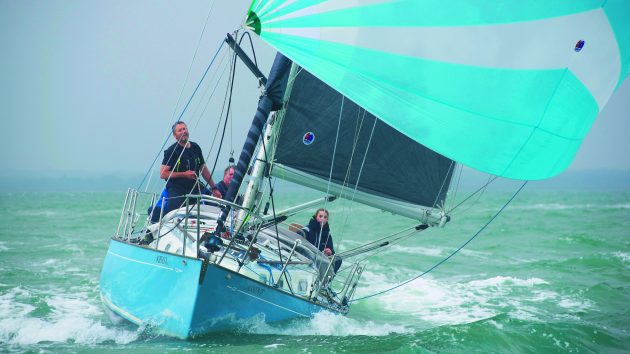
Assent ‘s performance in the 1979 Fastnet Race makes the Contessa 32 a worth entry in the 25 best small sailing boat designs list. Credit: Nic Compton
Designed by David Sadler as a bigger alternative to the popular Contessa 26, the Contessa 32 was built by Jeremy Rogers in Lymington from 1970.
The yacht’s credentials were established when Assent , the Contessa 32 owned by Willy Kerr and skippered by his son Alan, became the only yacht in her class to complete the deadly 1979 Fastnet Race .
When UK production ceased in 1983, more than 700 had been built, and another 20 have been built since 1996.
Cornish Crabber 24

It seemed a daft idea to build a gaff-rigged boat in 1974, just when everyone else had embraced the ‘modern’ Bermudan rig.
Yet the first Cornish Crabber 24, designed by Roger Dongray, tapped into a feeling that would grow and grow and eventually become a movement.
The 24 was followed in 1979 by the even more successful Shrimper 19 – now ubiquitous in almost every harbour in England – and the rest is history.
Drascombe Lugger
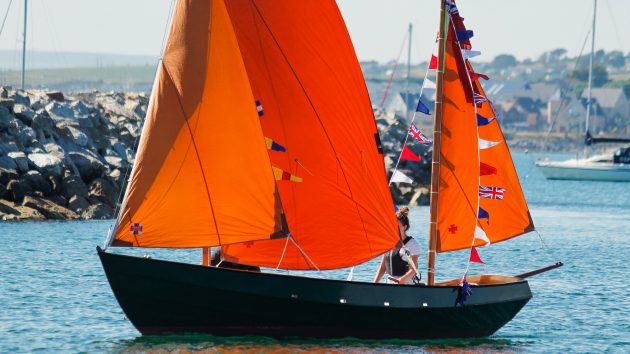
Credit: David Harding
There are faster, lighter and more comfortable boats than a Drascombe Lugger.
And yet, 57 years after John Watkinson designed the first ‘lugger’ (soon changed to gunter rig), more than 2,000 have been built and the design is still going strong.
More than any other boat, the Drascombe Lugger opened up dinghy cruising, exemplified by Ken Duxbury’s Greek voyages in the 1970s and Webb Chiles’s near-circumnavigation on Chidiock Tichbourne I and II .

The 26ft Eventide. Credit: David Harding
It’s been described as the Morris Minor of the boating world – except that the majority of the 1,000 Eventides built were lovingly assembled by their owners, not on a production line.
After you’d tested your skills building the Mirror dinghy, you could progress to building a yacht.
And at 24ft long, the Eventide packed a surprising amount of living space.
It was Maurice Griffiths’ most successful design and helped bring yachting to a wider audience.

You either love ’em or you hate ’em – motorsailers, that is.
The Fisher 30 was brought into production in 1971 and was one of the first out-and-out motorsailers.
With its long keel , heavy displacement and high bulwarks, it was intended to evoke the spirit of North Sea fishing boats.
It might not sail brilliantly but it provided an exceptional level of comfort for its size and it would look after you when things turned nasty.
Significantly, it was also fitted with a large engine.

Credit: Rupert Holmes
It should have been a disaster.
In 1941, when the Scandinavian Sailing Federation couldn’t choose a winner for their competition to design an affordable sailing boat, they gave six designs to naval architect Tord Sundén and asked him to combine the best features from each.
The result was a sweet-lined 25ft sloop which was very seaworthy and fast.
The design has been built in GRP since the 1970s and now numbers more than 4,000, with fleets all over the world.

Credit: Kevin Barber
There’s something disconcerting about a boat with two unstayed masts and no foresails, and certainly the Freedom range has its detractors.
Yet as Garry Hoyt proved, first with the Freedom 40, designed in collaboration with Halsey Herreshoff, and then the Freedom 33 , designed with Jay Paris, the boats are simple to sail (none of those clattering jib sheets every time you tack) and surprisingly fast – at least off the wind .
Other ‘cat ketch’ designs followed but the Freedoms developed their own cult following.
Hillyard 12-tonner

The old joke about Hillyards is that you won’t drown on one but you might starve to death getting there.
And yet this religious boatbuilder from Littlehampton built up to 800 yachts which travelled around the world – you can find them cruising far-flung destinations.
Sizes ranged from 2.5 to 20 tons, though the 9- and 12-ton are best for long cruises.

The innovations on Jester means she is one of the best small sailing boat designs in the last 100 years. Credit: Ewen Southby-Tailyour
Blondie Hasler was one of the great sailing innovators and Jester was his testing ground.
She was enclosed, carvel planked and had an unstayed junk rig.
Steering was via a windvane system Hasler created.
Hasler came second in the first OSTAR , proving small boats can achieve great things.

Moody kicked off the era of comfort-oriented boats with its very first design.
The Moody 33, designed by Angus Primrose, had a wide beam and high topside to produce a voluminous hull .
The centre cockpit allowed for an aft cabin, resulting in a 33-footer with two sleeping cabins – an almost unheard of concept in 1973 –full-beam heads and spacious galley.
What’s more, her performance under sail was more than adequate for cruising.
Finally, here was a yacht that all the family could enjoy.
Continues below…

What makes a boat seaworthy?
What characteristics make a yacht fit for purpose? Duncan Kent explores the meaning of 'seaworthy' and how hull design and…

How boat design is evolving
Will Bruton looks at the latest trends and innovations shaping the boats we sail

How keel type affects performance
James Jermain looks at the main keel types, their typical performance and the pros and cons of each

Boat handling: How to use your yacht’s hull shape to your advantage
Whether you have a long keel or twin keel rudders, there will be pros and cons when it comes to…
Nicholson 32

Credit: Genevieve Leaper
Charles Nicholson was a giant of the wooden boat era but one of his last designs – created with his son Peter – was a pioneering fibreglass boat that would become an enduring classic.
With its long keel and heavy displacement, the Nicholson 32 is in many ways a wooden boat built in fibreglass – and indeed the design was based on Nicholson’s South Coast One Design.
From 1966 to 1977, the ‘Nic 32’ went through 11 variations.

Credit: Hallberg-Rassy
In the beginning there was… the Rasmus 35. This was the first yacht built by the company that would become Hallberg-Rassy and which would eventually build more than 9,000 boats.
The Rasmus 35, designed by Olle Enderlein, was a conservative design, featuring a centre cockpit, long keel and well-appointed accommodation.
Some 760 boats were built between 1967 and 1978.

Credit: Larry & Lin Pardey
Lyle Hess was ahead of his time when he designed Renegade in 1949.
Despite winning the Newport to Ensenada race, the 25ft wooden cutter went largely unnoticed.
Hess had to build bridges for 15 years before Larry Pardey asked him to design the 24ft Seraffyn , closely based on Renegade ’s lines but with a Bermudan rig.
Pardey’s subsequent voyages around the world cemented Hess’s reputation and success of the Renegade design.

Would the Rustler 36 make it on your best small sailing boat list? Credit: Rustler Yachts
Six out of 18 entries for the 2018 Golden Globe Race (GGR) were Rustler 36s, with the top three places all going to Rustler 36 skippers.
It was a fantastic endorsement for a long-keel yacht designed by Holman & Pye 40 years before.
Expect to see more Rustler 36s in the 2022 edition of the GGR!

It was Ted Heath who first brought the S&S 34 to prominence with his boat Morning Cloud .
In 1969 the yacht won the Sydney to Hobart Race, despite being one of the smallest boats in the race.
Other epic S&S 34 voyages include the first ever single-handed double circumnavigation by Jon Sanders in 1981

Credit: Colin Work
The Contessa 32 might seem an impossible boat to improve upon, but that’s what her designer David Sadler attempted to do in 1979 with the launch of the Sadler 32 .
That was followed two years later by the Sadler 29 , a tidy little boat that managed to pack in six berths in a comfortable open-plan interior.
The boat was billed as ‘unsinkable’, with a double-skinned hull separated by closed cell foam buoyancy.
What’s more, it was fast, notching up to 12 knots.

Credit: Dick Durham/Yachting Monthly
Another modern take on the Contessa theme was the Sigma 33, designed by David Thomas in 1979.
A modern underwater body combined with greater beam and higher freeboard produced a faster boat with greater accommodation.
And, like the Contessa, the Sigma 33 earned its stripes at the 1979 Fastnet, when two of the boats survived to tell the tale.
A lively one-design fleet soon developed on the Solent which is still active to this day.

A replica of Joshua Slocum’s Spray . Credit: Alamy Stock Photo
The boat Joshua Slocum used for his first singlehanded circumnavigation of the world wasn’t intended to sail much further than the Chesapeake Bay.
The 37ft Spray was a rotten old oyster sloop which a friend gave him and which he had to spend 13 months fixing up.
Yet this boxy little tub, with its over-optimistic clipper bow, not only took Slocum safely around the world but has spawned dozens of modern copies that have undertaken long ocean passages.

Credit: James Wharram Designs
What are boats for if not for dreaming? And James Wharram had big dreams.
First he sailed across the Atlantic on the 23ft 6in catamaran Tangaroa .
He then built the 40ft Rongo on the beach in Trinidad (with a little help from French legend Bernard Moitessier) and sailed back to the UK.
Then he drew the 34ft Tangaroa (based on Rongo ) for others to follow in his wake and sold 500 plans in 10 years.

Credit: Graham Snook/Yachting Monthly
The Twister was designed in a hurry.
Kim Holman wanted a boat at short notice for the 1963 season and, having had some success with his Stella design (based on the Folkboat), he rushed out a ‘knockabout cruising boat for the summer with some racing for fun’.
The result was a Bermudan sloop that proved nigh on unbeatable on the East Anglian circuit.
It proved to be Holman’s most popular design with more than 200 built.

Credit: Alamy Stock Photo
Laurent Giles’s design No15 was drawn in 1935 for a Guernsey solicitor who wanted ‘a boat that would spin on a sixpence and I could sail single-handed ’.
What the young Jack Giles gave him was a pretty transom-sterned cutter, with a nicely raked stem.
Despite being moderate in every way, the boat proved extremely able and was soon racking up long distances, including Humphrey Barton’s famous transatlantic crossing on Vertue XXXV in 1950.
Wanderer II and III

Credit: Thies Matzen
Eric and Susan Hiscock couldn’t afford a Vertue, so Laurent Giles designed a smaller, 21ft version for them which they named Wanderer II .
They were back a few years later, this time wanting a bigger version: the 30ft Wanderer III .
It was this boat they sailed around the world between 1952-55, writing articles and sailing books along the way.
In doing so, they introduced a whole generation of amateur sailors to the possibilities of long-distance cruising.
Westerly 22

The origins of Westerly Marine were incredibly modest.
Commander Denys Rayner started building plywood dinghies in the 1950s which morphed into a 22ft pocket cruiser called the Westcoaster.
Realising the potential of fibreglass, in 1963 he adapted the design to create the Westerly 22, an affordable cruising boat with bilge keels and a reverse sheer coachroof.
Some 332 boats were built to the design before it was relaunched as the Nomad (267 built).
Enjoyed reading 25 of the best small sailing boat designs?
A subscription to Yachting Monthly magazine costs around 40% less than the cover price .
Print and digital editions are available through Magazines Direct – where you can also find the latest deals .
YM is packed with information to help you get the most from your time on the water.
- Take your seamanship to the next level with tips, advice and skills from our experts
- Impartial in-depth reviews of the latest yachts and equipment
- Cruising guides to help you reach those dream destinations
Follow us on Facebook , Twitter and Instagram.

My Cruiser Life Magazine
Basics of Sailboat Hull Design – EXPLAINED For Owners
There are a lot of different sailboats in the world. In fact, they’ve been making sailboats for thousands of years. And over that time, mankind and naval architects (okay, mostly the naval architects!) have learned a thing or two.
If you’re wondering what makes one sailboat different from another, consider this article a primer. It certainly doesn’t contain everything you’d need to know to build a sailboat, but it gives the novice boater some ideas of what goes on behind the curtain. It will also provide some tips to help you compare different boats on the water, and hopefully, it will guide you towards the sort of boat you could call home one day.
Table of Contents
Displacement hulls, semi displacement hulls, planing hulls, history of sailboat hull design, greater waterline length, distinctive hull shape and fin keel designs, ratios in hull design, the hull truth and nothing but the truth, sail boat hull design faqs.

Basics of Hull Design
When you think about a sailboat hull and how it is built, you might start thinking about the shape of a keel. This has certainly spurred a lot of different designs over the years, but the hull of a sailboat today is designed almost independently of the keel.
In fact, if you look at a particular make and model of sailboat, you’ll notice that the makers often offer it with a variety of keel options. For example, this new Jeanneau Sun Odyssey comes with either a full fin bulb keel, shallow draft bulb fin, or very shallow draft swing keel. Where older long keel designs had the keel included in the hull mold, today’s bolt-on fin keel designs allow the manufacturers more leeway in customizing a yacht to your specifications.
What you’re left with is a hull, and boat hulls take three basic forms.
- Displacement hull
- Semi-displacement hulls
- Planing hulls
Most times, the hull of a sailboat will be a displacement hull. To float, a boat must displace a volume of water equal in weight to that of the yacht. This is Archimedes Principle , and it’s how displacement hulled boats get their name.
The displacement hull sailboat has dominated the Maritimes for thousands of years. It has only been in the last century that other designs have caught on, thanks to advances in engine technologies. In short, sailboats and sail-powered ships are nearly always displacement cruisers because they lack the power to do anything else.
A displacement hull rides low in the water and continuously displaces its weight in water. That means that all of that water must be pushed out of the vessel’s way, and this creates some operating limitations. As it pushes the water, water is built up ahead of the boat in a bow wave. This wave creates a trough along the side of the boat, and the wave goes up again at the stern. The distance between the two waves is a limiting factor because the wave trough between them creates a suction.
This suction pulls the boat down and creates drag as the vessel moves through the water. So in effect, no matter how much power is applied to a displacement hulled vessel, it cannot go faster than a certain speed. That speed is referred to as the hull speed, and it’s a factor of a boat’s length and width.
For an average 38 foot sailboat, the hull speed is around 8.3 knots. This is why shipping companies competed to have the fastest ship for many years by building larger and larger ships.
While they might sound old-school and boring, displacement hulls are very efficient because they require very little power—and therefore very little fuel—to get them up to hull speed. This is one reason enormous container ships operate so efficiently.
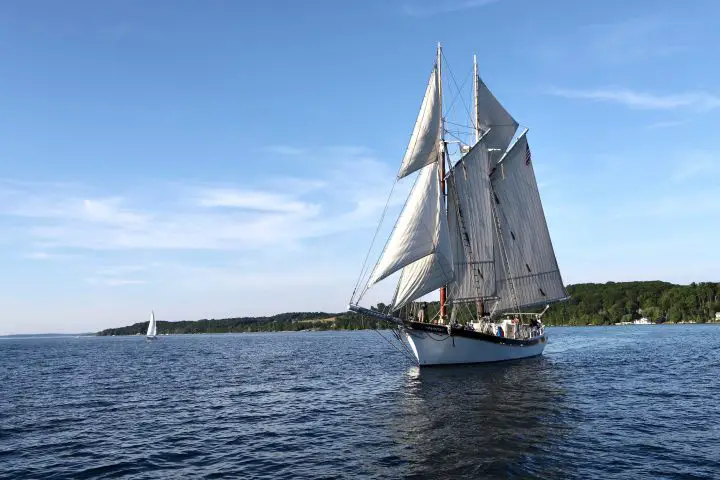
Of course, living in the 21st century, you undoubtedly have seen boats go faster than their hull speed. Going faster is simply a matter of defeating the bow wave in one way or another.
One way is to build the boat so that it can step up onto and ride the bow wave like a surfer. This is basically what a semi-displacement hull does. With enough power, this type of boat can surf its bow wave, break the suction it creates and beat its displacement hull speed.
With even more power, a boat can leave its bow wave in the dust and zoom past it. This requires the boat’s bottom to channel water away and sit on the surface. Once it is out of the water, any speed is achievable with enough power.
But it takes enormous amounts of power to get a boat on plane, so planing hulls are hardly efficient. But they are fast. Speedboats are planing hulls, so if you require speed, go ahead and research the cost of a speedboat .
The most stable and forgiving planing hull designs have a deep v hull. A very shallow draft, flat bottomed boat can plane too, but it provides an unforgiving and rough ride in any sort of chop.
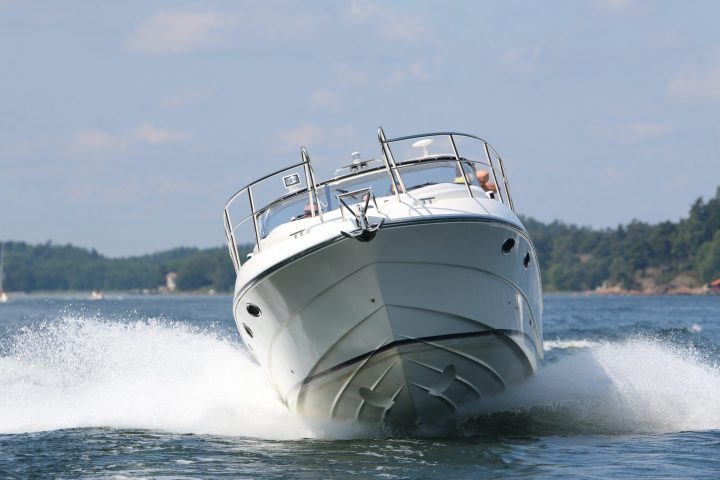
If you compare the shapes of the sailboats of today with the cruising boat designs of the 1960s and 70s, you’ll notice that quite a lot has changed in the last 50-plus years. Of course, the old designs are still popular among sailors, but it’s not easy to find a boat like that being built today.
Today’s boats are sleeker. They have wide transoms and flat bottoms. They’re more likely to support fin keels and spade rudders. Rigs have also changed, with the fractional sloop being the preferred setup for most modern production boats.
Why have boats changed so much? And why did boats look so different back then?
One reason was the racing standards of the day. Boats in the 1960s were built to the IOR (International Offshore Rule). Since many owners raced their boats, the IOR handicaps standardized things to make fair play between different makes and models on the racecourse.
The IOR rule book was dense and complicated. But as manufacturers started building yachts, or as they looked at the competition and tried to do better, they all took a basic form. The IOR rule wasn’t the only one around . There were also the Universal Rule, International Rule, Yacht Racing Association Rul, Bermuda Rule, and a slew of others.
Part of this similarity was the rule, and part of it was simply the collective knowledge and tradition of yacht building. But at that time, there was much less distance between the yachts you could buy from the manufacturers and those setting off on long-distance races.
Today, those wishing to compete in serious racing a building boat’s purpose-built for the task. As a result, one-design racing is now more popular. And similarly, pleasure boats designed for leisurely coastal and offshore hops are likewise built for the task at hand. No longer are the lines blurred between the two, and no longer are one set of sailors “making do” with the requirements set by the other set.
Modern Features of Sailboat Hull Design
So, what exactly sets today’s cruising and liveaboard boats apart from those built-in decades past?
Today’s designs usually feature plumb bows and the maximum beam carried to the aft end. The broad transom allows for a walk-through swim platform and sometimes even storage for the dinghy in a “garage.”
The other significant advantage of this layout is that it maximizes waterline length, which makes a faster boat. Unfortunately, while the boats of yesteryear might have had lovely graceful overhangs, their waterline lengths are generally no match for newer boats.
The wide beam carried aft also provides an enormous amount of living space. The surface area of modern cockpits is nothing short of astounding when it comes to living and entertaining.
If you look at the hull lines or can catch a glimpse of these boats out of the water, you’ll notice their underwater profiles are radically different too. It’s hard to find a full keel design boat today. Instead, fin keels dominate, along with high aspect ratio spade rudders.
The flat bottom boats of today mean a more stable boat that rides flatter. These boats can really move without heeling over like past designs. Additionally, their designs make it possible in some cases for these boats to surf their bow waves, meaning that with enough power, they can easily achieve and sometimes exceed—at least for short bursts—their hull speeds. Many of these features have been found on race boats for decades.
There are downsides to these designs, of course. The flat bottom boats often tend to pound when sailing upwind , but most sailors like the extra speed when heading downwind.
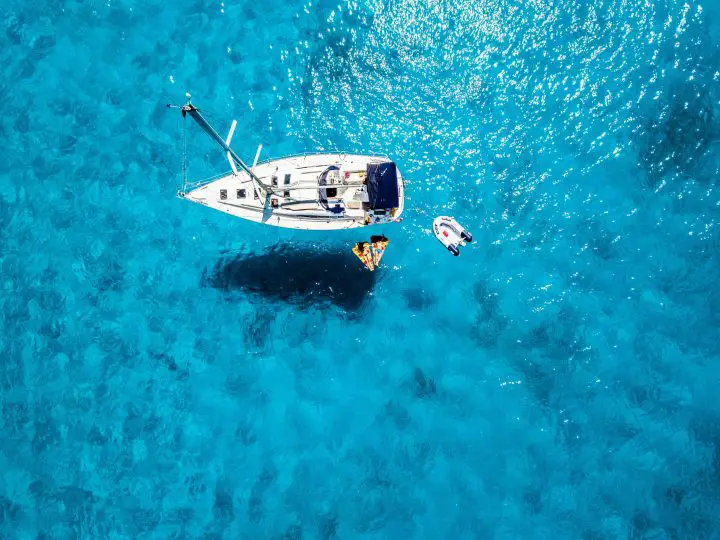
How Do You Make a Stable Hull
Ultimately, the job of a sailboat hull is to keep the boat afloat and create stability. These are the fundamentals of a seaworthy vessel.
There are two types of stability that a design addresses . The first is the initial stability, which is how resistant to heeling the design is. For example, compare a classic, narrow-beamed monohull and a wide catamaran for a moment. The monohull has very little initial stability because it heels over in even light winds. That doesn’t mean it tips over, but it is relatively easy to make heel.
A catamaran, on the other hand, has very high initial stability. It resists the heel and remains level. Designers call this type of stability form stability.
There is also secondary stability, or ultimate stability. This is how resistant the boat is to a total capsize. Monohull sailboats have an immense amount of ballast low in their keels, which means they have very high ultimate stability. A narrow monohull has low form stability but very high ultimate stability. A sailor would likely describe this boat as “tender,” but they would never doubt its ability to right itself after a knock-down or capsize.
On the other hand, the catamaran has extremely high form stability, but once the boat heels, it has little ultimate stability. In other words, beyond a certain point, there is nothing to prevent it from capsizing.
Both catamarans and modern monohulls’ hull shapes use their beams to reduce the amount of ballast and weight . A lighter boat can sail fast, but to make it more stable, naval architects increase the beam to increase the form stability.
If you’d like to know more about how stable a hull is, you’ll want to learn about the Gz Curve , which is the mathematical calculation you can make based on a hull’s form and ultimate stabilities.
How does a lowly sailor make heads or tails out of this? You don’t have to be a naval architect when comparing different designs to understand the basics. Two ratios can help you predict how stable a design will be .
The first is the displacement to length ratio . The formula to calculate it is D / (0.01L)^3 , where D is displacement in tons and L is waterline length in feet. But most sailboat specifications, like those found on sailboatdata.com , list the D/L Ratio.
This ratio helps understand how heavy a boat is for its length. Heavier boats must move more water to make way, so a heavy boat is more likely to be slower. But, for the ocean-going cruiser, a heavy boat means a stable boat that requires much force to jostle or toss about. A light displacement boat might pound in a seaway, and a heavy one is likely to provide a softer ride.
The second ratio of interest is the sail area to displacement ratio. To calculate, take SA / (D)^0.67 , where SA is the sail area in square feet and D is displacement in cubic feet. Again, many online sites provide the ratio calculated for specific makes and models.
This ratio tells you how much power a boat has. A lower ratio means that the boat doesn’t have much power to move its weight, while a bigger number means it has more “get up and go.” Of course, if you really want to sail fast, you’d want the boat to have a low displacement/length and a high sail area/displacement.
Multihull Sailboat Hulls
Multihull sailboats are more popular than ever before. While many people quote catamaran speed as their primary interest, the fact is that multihulls have a lot to offer cruising and traveling boaters. These vessels are not limited to coastal cruising, as was once believed. Most sizable cats and trimarans are ocean certified.
Both catamarans and trimaran hull designs allow for fast sailing. Their wide beam allows them to sail flat while having extreme form stability.
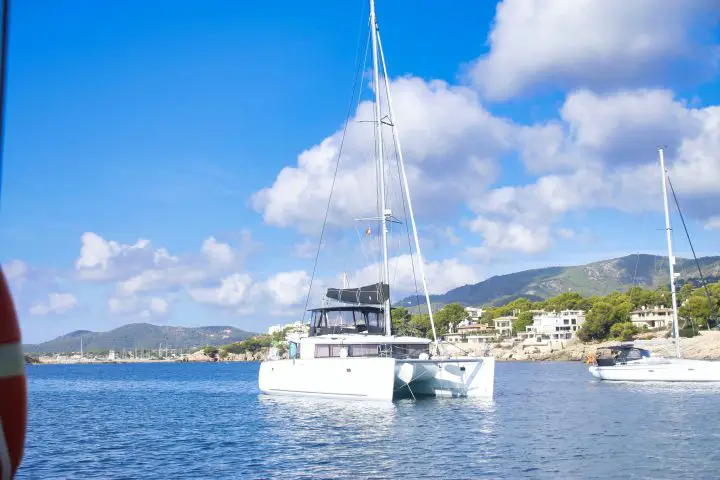
Catamarans have two hulls connected by a large bridge deck. The best part for cruisers is that their big surface area is full of living space. The bridge deck usually features large, open cockpits with connecting salons. Wrap around windows let in tons of light and fresh air.
Trimarans are basically monohulls with an outrigger hull on each side. Their designs are generally less spacious than catamarans, but they sail even faster. In addition, the outer hulls eliminate the need for heavy ballast, significantly reducing the wetted area of the hulls.
Boaters and cruising sailors don’t need to be experts in yacht design, but having a rough understanding of the basics can help you pick the right boat. Boat design is a series of compromises, and knowing the ones that designers and builders take will help you understand what the boat is for and how it should be used.
What is the most efficient boat hull design?
The most efficient hull design is the displacement hull. This type of boat sits low in the water and pushes the water out of its way. It is limited to its designed hull speed, a factor of its length. But cruising at hull speed or less requires very little energy and can be done very efficiently.
By way of example, most sailboats have very small engines. A typical 40-foot sailboat has a 50 horsepower motor that burns around one gallon of diesel every hour. In contrast, a 40-foot planing speedboat may have 1,000 horsepower (or more). Its multiple motors would likely be consuming more than 100 gallons per hour (or more). Using these rough numbers, the sailboat achieves about 8 miles per gallon, while the speedboat gets around 2 mpg.
What are sail boat hulls made of?
Nearly all modern sailboats are made of fiberglass.
Traditionally, boats were made of wood, and many traditional vessels still are today. There are also metal boats made of steel or aluminum, but these designs are less common. Metal boats are more common in expedition yachts or those used in high-latitude sailing.
Matt has been boating around Florida for over 25 years in everything from small powerboats to large cruising catamarans. He currently lives aboard a 38-foot Cabo Rico sailboat with his wife Lucy and adventure dog Chelsea. Together, they cruise between winters in The Bahamas and summers in the Chesapeake Bay.
- Types of Sailboats
- Parts of a Sailboat
- Cruising Boats
- Small Sailboats
- Design Basics
- Sailboats under 30'
- Sailboats 30'-35
- Sailboats 35'-40'
- Sailboats 40'-45'
- Sailboats 45'-50'
- Sailboats 50'-55'
- Sailboats over 55'
- Masts & Spars
- Knots, Bends & Hitches
- The 12v Energy Equation
- Electronics & Instrumentation
- Build Your Own Boat
- Buying a Used Boat
- Choosing Accessories
- Living on a Boat
- Cruising Offshore
- Sailing in the Caribbean
- Anchoring Skills
- Sailing Authors & Their Writings
- Mary's Journal
- Nautical Terms
- Cruising Sailboats for Sale
- List your Boat for Sale Here!
- Used Sailing Equipment for Sale
- Sell Your Unwanted Gear
- Sailing eBooks: Download them here!
- Your Sailboats
- Your Sailing Stories
- Your Fishing Stories
- Advertising
- What's New?
- Chartering a Sailboat
Sailboat Design: Stability, Buoyancy and Performance
Simply stated, the first requirement of sailboat design is that the yacht designer's creation is seaworthy; particularly in that it stays afloat and is highly resistant to capsize - but of course we expect rather more than that...
Good sailing performance, particularly to windward, will be high on the list of most sailors' requirements. As will the availability of sufficient space below decks to accommodate the crew and the stores, and all the other sailing paraphernalia.
And the boat must be easy to handle, both under sail at sea and under power in the marina. It must be comfortable, for it's not always just a sailing machine - at times it has to function as a home too.
So a design that successfully incorporates all these requirements won't just happen by accident - but however accomplished your yacht designer, you'll not be able to have everything...
We sailors recognise the stability element of sailboat design as the difference between a 'stiff' boat and a 'tender' one. And whether it's one or the other depends on the relationship between the righting moment applied by the hull and the heeling moment applied by the wind-loaded sails.
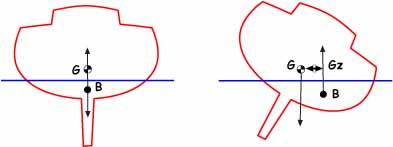
As can be seen in the sketch, the righting moment (Gz) is the horizontal distance between the boat's Centre of Gravity (G) and its Centre of Buoyancy (B).
The righting moment increases as the boat heels until a point is reached at which the heeling moment becomes equal to the righting moment, following which any further increase in heeling moment will cause the boat to capsize.
This is best expressed graphically by way of a Gz Curve, which plots Righting Moment against Heel Angle.
This curve establishes the Angle of Vanishing Stability , effectively the point of no return for a sailboat about to capsize, and which is a major factor in allocating any sailboat to one of the four recognised sailboat design categories - Ocean, Offshore, Inland and Sheltered Waters .
If you're planning to buy or charter a sailboat, you should always check its Design Category to make sure that it's suitable for your purposes.
Displacement, Freeboard and the Centre of Gravity
Heavy displacement boats sit lower in the water than light displacement craft, so their cabin soles are deeper below the water line. Lighter displacement boats with their higher cabin soles have to have greater freeboard to provide their occupants with sufficient headroom.
And freeboard has an impact on stability in that it raises the centre of gravity, thereby reducing the righting moment.
To compensate this, any ballast carried by a light displacement boat should always be as low as possible, ideally in a bulb at the foot of the keel - the lower the centre of gravity the better, as it improves the righting moment by maximising the righting lever Gz.
In our medium-to-light sailboat Alacazam, we have gone one stage further by building in a water ballast system .
Performance
Generally light displacement brings performance benefits due to the higher power to weight ratio and reduced hull drag through having a smaller wetted area.
This is borne out by two important design ratios, the Displacement/Length Ratio and the Sail Area/Displacement Ratio.
Length too has an impact on performance, as can be shown by another sailboat design ratio, the Speed/Length Ratio.
It will also come as no surprise that performance is also influenced by the hull shape below the waterline; a slim arrow-like hull offering less resistance that a squat, dumpy one. But what isn't so widely known is that the ideal shape for hullspeed is not the most efficient shape when sailing at less than hullspeed; which is why sailboat designers ponder long and hard over another sailboat design ratio - the Prismatic Coefficient.
Read more about these and other Design Ratios used by today's Yacht Designers...
Recent Articles
Amel Kirk 36 Sailboat Specs & Key Performance Indicators
Sep 07, 24 03:38 PM
Pearson 33 for sale
Sep 04, 24 03:29 PM
Apla 42 Sailboat Specs & Key Performance Indicators
Aug 30, 24 02:51 AM

Here's where to:
- Find Used Sailboats for Sale...
- Find Used Sailing Gear for Sale...
- List your Sailboat for Sale...
- List your Used Sailing Gear...
Our eBooks...

A few of our Most Popular Pages...

Copyright © 2024 Dick McClary Sailboat-Cruising.com
- BOAT OF THE YEAR
- Newsletters
- Sailboat Reviews
- Boating Safety
- Sails and Rigging
- Maintenance
- Sailing Totem
- Sailor & Galley
- Living Aboard
- Destinations
- Gear & Electronics
- Charter Resources
- Ultimate Boating Giveaway

Sailboat Design Evolution
- By Dan Spurr
- Updated: June 10, 2020
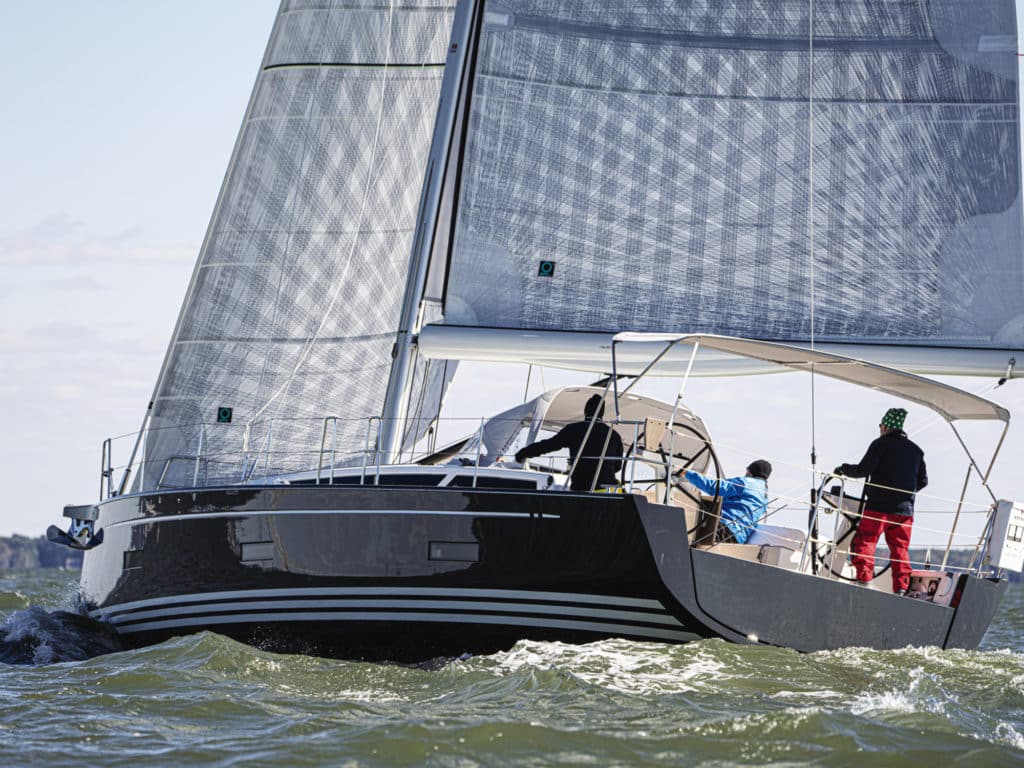
You know the old saying, “The more things change, the more they stay the same”? As a judge for the 2020 Boat of the Year (BOTY) competition at this past fall’s US Sailboat Show in Annapolis, Maryland, I helped inspect and test-sail 22 brand-new current-model sailboats. And I came away thinking, Man, these aren’t the boats I grew up on. In the case of new boats, the saying is wrong: “Nothing stays the same.”
OK, sure, today’s boats still have masts and sails, and the monohulls still have keels. But comparing the Hinckley Bermuda 40, considered by many to be one of the most beautiful and seaworthy boats of the 1960s, ’70s and even ’80s, with, say, the Beneteau First Yacht 53, which debuted at the show, is pretty much apples and oranges.
To get a better sense of what has happened to yacht design, boatbuilding and equipment over the past three, four or even six decades, let’s take a closer look.
Design Dilemmas
At the risk of oversimplification, since the fiberglass era began in the late 1940s and ’50s, the design of midsize and full-size yachts has transitioned from the Cruising Club of America rules, which favored all-around boats (racers had to have comfortable interiors) with moderate beam and long overhangs, to a succession of racing rules such as the IOR, IMS and IRC. All of them dictated proportions, and each required a measurer to determine its rating.
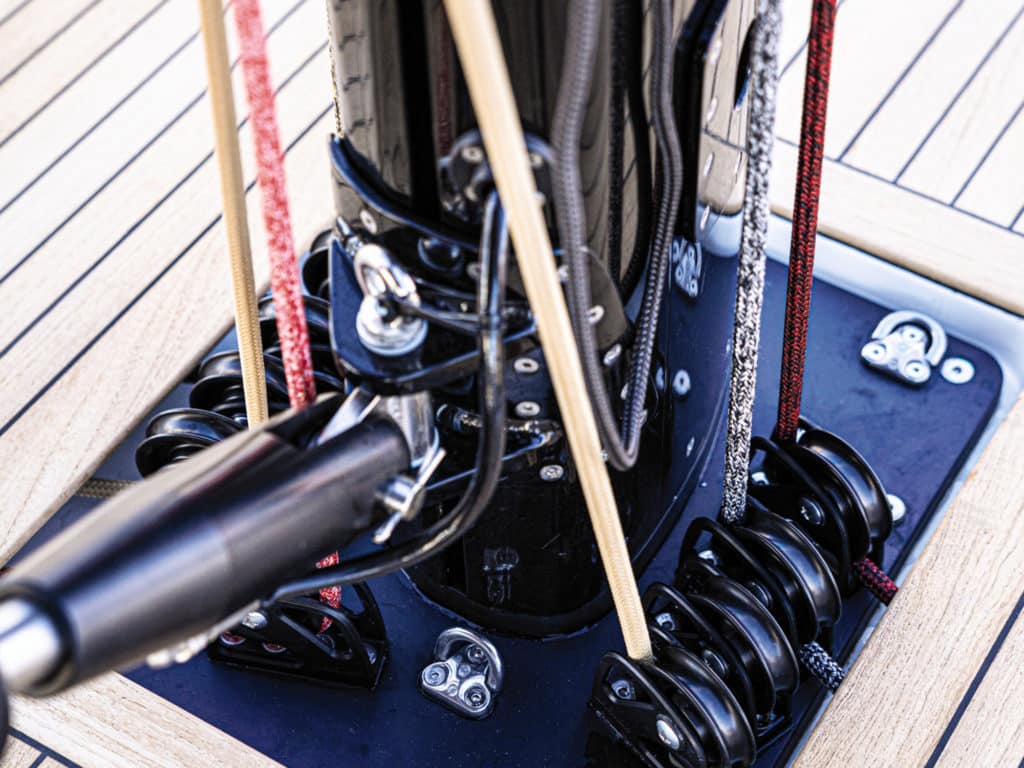
As frustration grew with each (no handicap rule is perfect), alternatives arose, such as the Performance Handicap Racing Fleet, which essentially based one’s handicap on past performance of the same boats in the same fleet. Also, one-design racing became more popular, which spread beyond identical small boats to full-size yachts, popularized in part by builders such as J/Boats and Carroll Marine. The ethos there was: Who cares about intricate rating rules? Let’s just go out and sail fast and have fun!
And that might best sum up the design briefs for the monohulls in this year’s BOTY competition: good all-around performance with comfortable, even luxurious accommodations. Gone are interiors that noted naval architect Robert Perry called “the boy’s cabin in the woods,” deeply influenced by stodgy British designers of the past century and their now-old-fashioned (though sea-friendly, one should note) concepts of a proper yacht, drawn and spec’d by the same guy who designed the hull, deck and rig. Today, dedicated European interior designers are specially commissioned to inject modernity, home fashion colors and textures, amenities, and more light—even dubiously large port lights in the topsides.
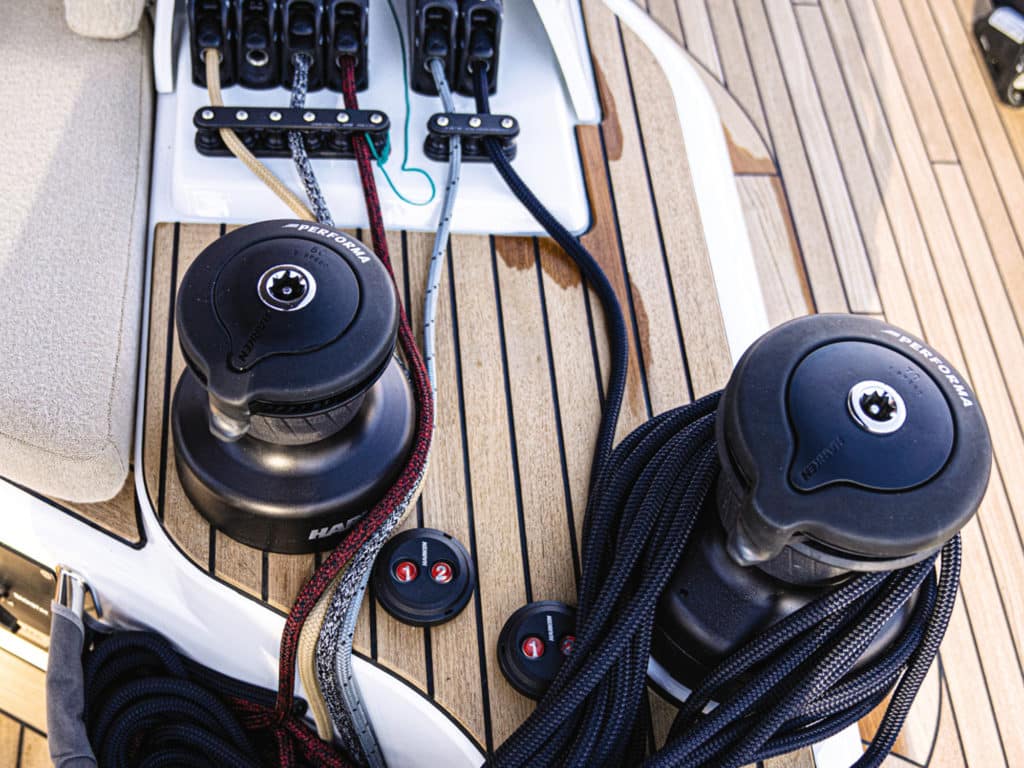
Overhangs, bow and stern, have virtually disappeared. Why? It seems largely a matter of style. Plus, the bonus of increased usable space below, not to mention a longer waterline length for a given length overall, which translates to more speed. Former naval architect for C&C Yachts and Hunter Marine, Rob Mazza, recalls that 19th-century pilot cutters and fishing schooners operating in offshore conditions generally had plumb bows, so in a sense, bow forms have come full circle.
Today’s boats are carrying their wide beam farther aft. Gone are the days of the cod’s head and mackerel tail. Wide, flat canoe bodies are decidedly fast off the wind, and might even surf, but they pay a comfort penalty upwind.
These boats have lighter displacement/length (D/L) ratios, which means flatter bottoms and less stowage and space for tanks. The Beneteau 53 has a D/L of 118, compared with the aforementioned Bermuda 40 of 373. Among entries in this year’s BOTY, the heaviest D/L belonged to the Elan Impression 45.1, with a D/L of 195. Recall that when Perry’s extremely popular Valiant 40 was introduced in 1975, the cruising establishment howled that its D/L of 267 was unsuitable for offshore sailing. My, how times have changed!
Perhaps more important, one must ask: “Have the requirements for a good, safe bluewater cruiser actually changed? Or are the majority of today’s production sailboats really best-suited for coastal cruising?”
The ramifications of lighter displacement don’t end there; designers must consider two types of stability: form and ultimate. As weight is taken out of the boat, beam is increased to improve form stability. And with tanks and machinery sometimes raised, ballast might have to be added and/or lowered to improve ultimate stability.
What else to do? Make the boat bigger all around, which also improves stability and stowage. Certainly the average cruising boat today is longer than those of the earlier decades, both wood and fiberglass. And the necessarily shallower bilges mean pumps must be in good shape and of adequate size. That’s not as immediate an issue with a deep or full keel boat with internal ballast and a deep sump; for instance, I couldn’t reach the bottom of the sump in our 1977 Pearson 365.
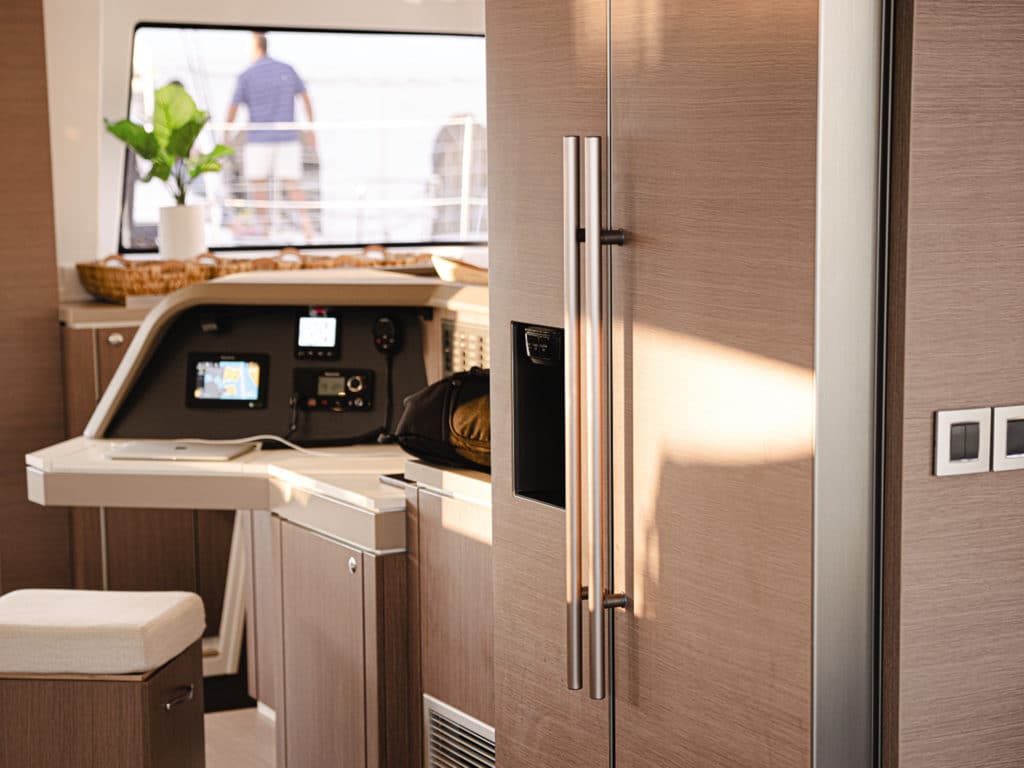
And how do these wide, shallow, lighter boats handle under sail? Like a witch when cracked off the wind. We saw this trend beginning with shorthanded offshore racers like those of the BOC Challenge round-the-world race in the early 1980s. As CW executive editor Herb McCormick, who has some experience in these boats, says, “They’ll knock your teeth out upwind.” But route planning allows designers to minimize time upwind, and cruisers can too…if you have enough room and distance in front of you. Coastal sailors, on the other hand, will inevitably find even moderate displacement boats more comfortable as they punch into head seas trying to make port.
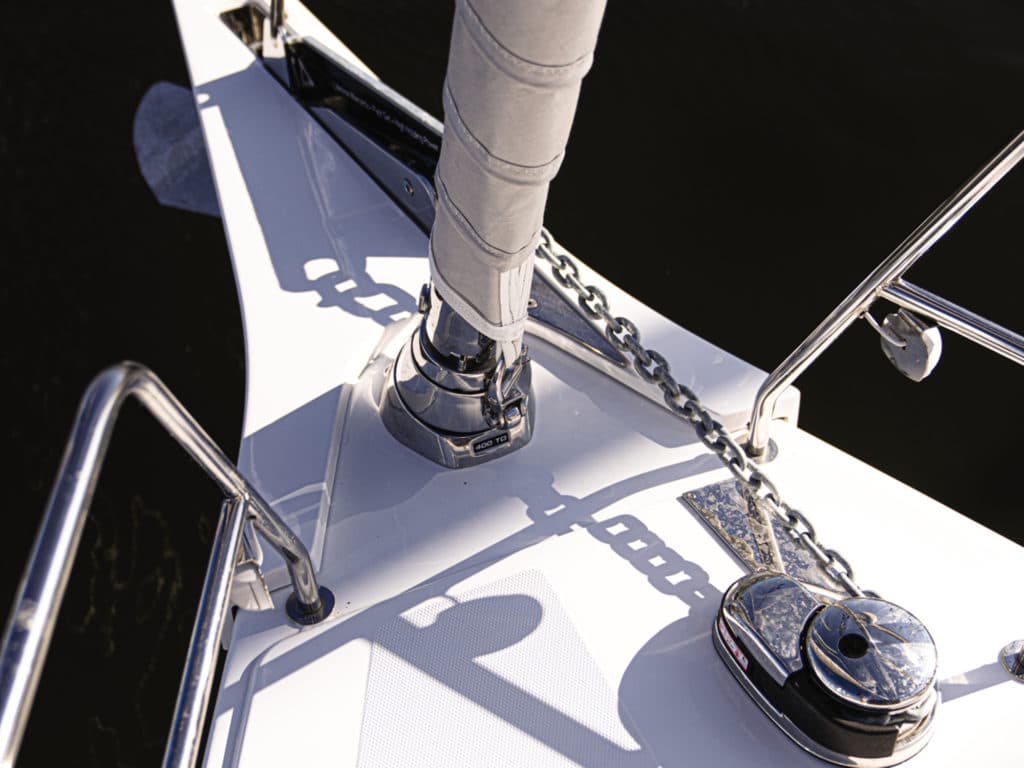
A wide beam carried aft permits a number of useful advantages: the possibility of a dinghy garage under the cockpit on larger boats; easy access to a swim platform and a launched dinghy; and twin helms, which are almost a necessity for good sightlines port and starboard. Of course, two of anything always costs twice as much as one.
Some multihulls now have reverse bows. This retro styling now looks space-age. Very cool. But not everyone is sold on them. Canadian designer Laurie McGowan wrote in a Professional BoatBuilder opinion piece, “I saw through the fog of faddishness and realized that reverse bows are designed to fail—that is, to cause vessels to plunge when lift is required.” Mazza concurs: “Modern multihulls often have reverse stems with negative reserve buoyancy, and those are boats that really can’t afford to bury their bows.”
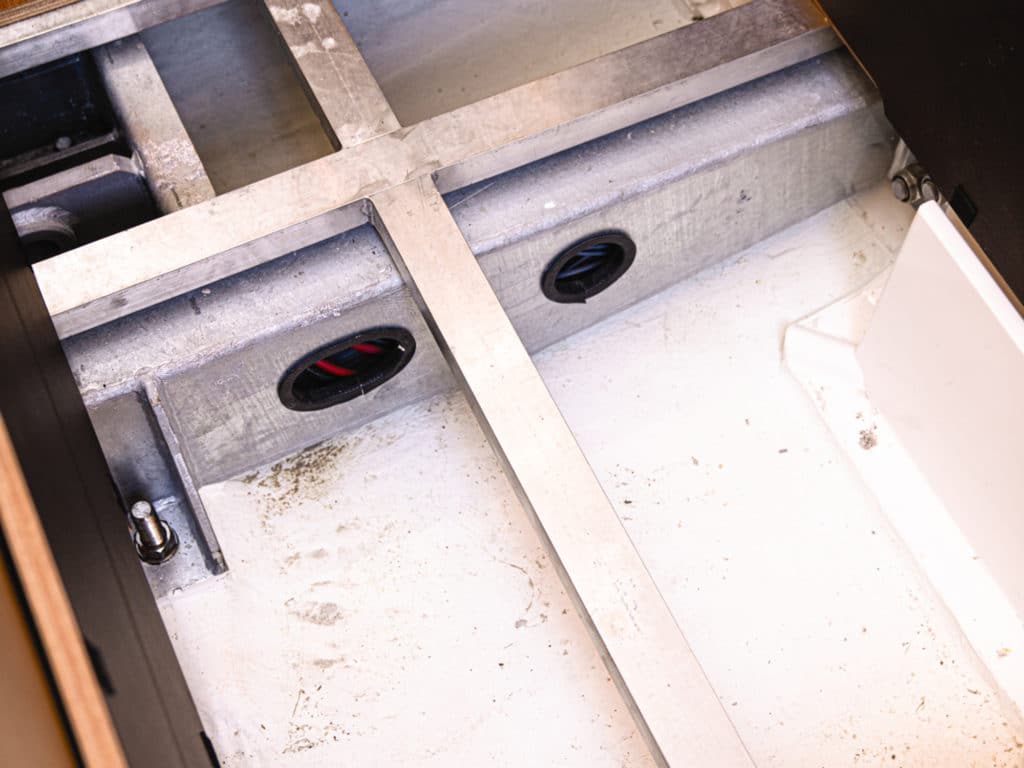
McGowan also cites another designer critiquing reverse bows for being noticeably wet and requiring alternative ground-tackle arrangements. The latter also is problematic on plumb bows, strongly suggesting a platform or sprit to keep the anchor away from the stem.
Rigging Redux
If there was a boat in Annapolis with double lower shrouds, single uppers, and spreaders perpendicular to the boat’s centerline, I must have missed it. I believe every boat we sailed had swept-back spreaders and single lowers. An early criticism of extreme swept-back spreaders, as seen on some B&R rigs installed on Hunter sailboats, was that they prevented fully winging out the mainsail. The counter argument was that so many average sailors never go dead downwind in any case, and broad reaching might get them to their destinations faster anyway—and with their lunch sandwiches still in their stomachs.
That issue aside, the current rigging configuration may allow for better mainsail shape. But as Mazza points out, it’s not necessarily simple: “By sweeping the spreaders, the ‘transverse’ rigging starts to add fore-and-aft support to the midsection of the mast as well, reducing the need for the forward lowers. However, spreader sweep really does complicate rig tuning, especially if you are using the fixed backstay to induce headstay tension. Swept spreaders do make it easier to sheet non-overlapping headsails, and do better support the top of the forestay on fractional rigs.”
Certainly, the days of 150 percent genoas are over, replaced by 100 percent jibs that fit perfectly in the foretriangle, often as a self-tacker.
Another notable piece of rigging the judges found common was some form of lazy jacks or mainsail containment, from traditional, multiple lines secured at the mast and boom; to the Dutchman system with monofilament run through cringles sewn into the sail like a window blind; to sailmaker solutions like the Doyle StackPak. This is good news for all sailors, especially those who sail shorthanded on larger boats.
Construction Codas
Improvements in tooling—that is, the making of molds—are easily evident in today’s boats, particularly with deck details, and in fairness. That’s because many of today’s tools are designed with computer software that is extraordinarily accurate, and that accuracy is transferred flawlessly to big five-axis routers that sculpt from giant blocks of foam the desired shape to within thousandths of an inch. Gone are the days of lofting lines on a plywood floor, taken from a table of offsets, and then building a male plug with wood planks and frames. I once owned a 1960s-era sailboat, built by a reputable company, where the centerline of the cockpit was 7 degrees off the centerline of the deck—and they were one piece!
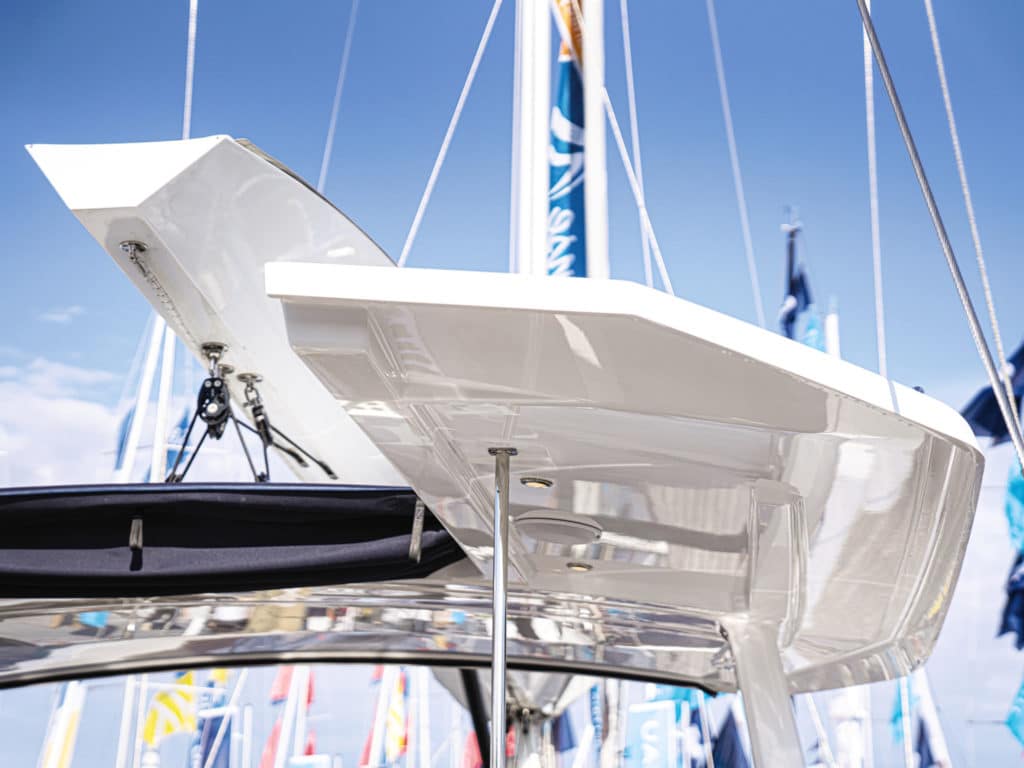
Additive processes, such as 3D printing, are quickly complementing subtractive processes like the milling described above. Already, a company in California has made a multipart mold for a 34-foot sailboat. Advantages include less waste materials.
Job training also has had an impact on the quality of fiberglass boats. There are now numerous schools across the country offering basic-skills training in composites that include spraying molds with gelcoat, lamination, and an introduction to vacuum bagging and infusion.
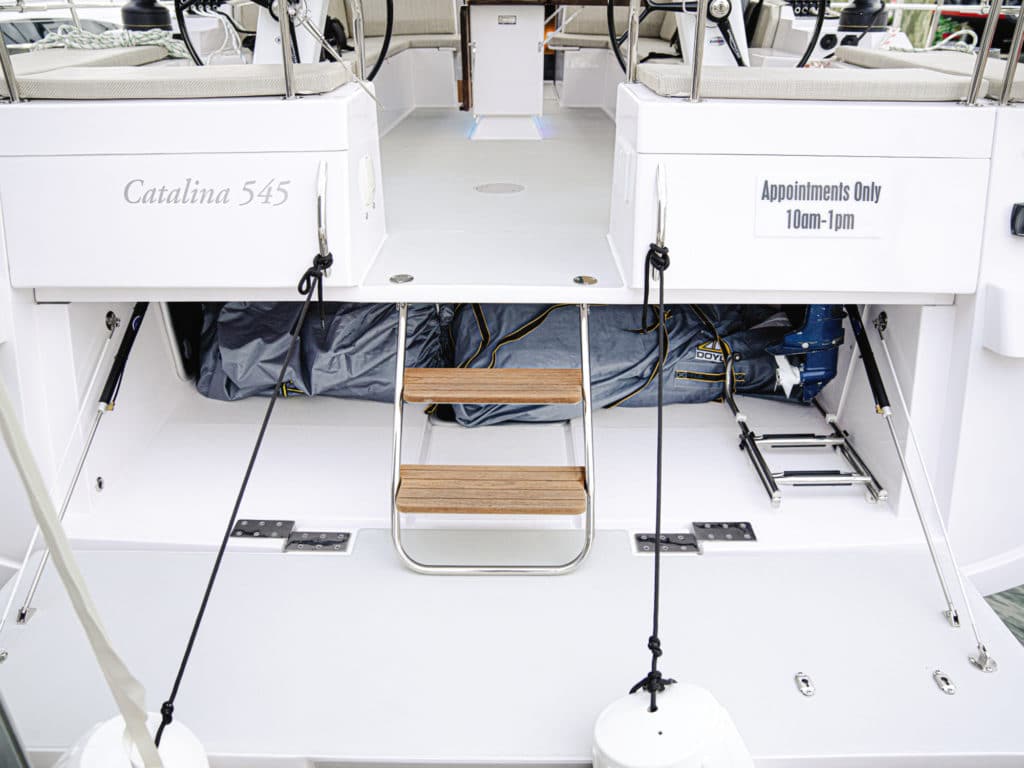
The patent on SCRIMP—perhaps the first widely employed infusion process—has long ago expired, but many builders have adopted it or a similar process whereby layers of fiberglass are placed in the mold dry along with a network of tubes that will carry resin under vacuum pressure to each area of the hull. After careful placement, the entire mold is covered with a bag, a vacuum is drawn by a pump, and lines to the pot of resin are opened. If done correctly, the result is a more uniform fiberglass part with a more controlled glass-to-resin ratio than is achievable with hand lay-up. And as a huge bonus, there are no volatile organic compounds released into the workplace, and no need for expensive exhaust fans and ductwork. OSHA likes that, and so do the workers.
However, sloppy processes and glasswork can still be found on some new boats. Surveyor Jonathan Klopman—who is based in Marblehead, Massachusetts, but has inspected dozens, if not hundreds, of boats damaged by hurricanes in the Caribbean—tells me that he is appalled by some of the shoddy work he sees, such as balsa cores not vacuum-bagged to the fiberglass skins, resulting in delamination. But overall, I believe workmanship has improved, which is evident when you look behind backrests, inside lockers and into bilges, where the tidiness of glasswork (or lack thereof) is often exposed. Mechanical and electrical systems also have improved, in part due to the promulgation of standards by the American Boat & Yacht Council, and informal enforcement by insurance companies and surveyors.
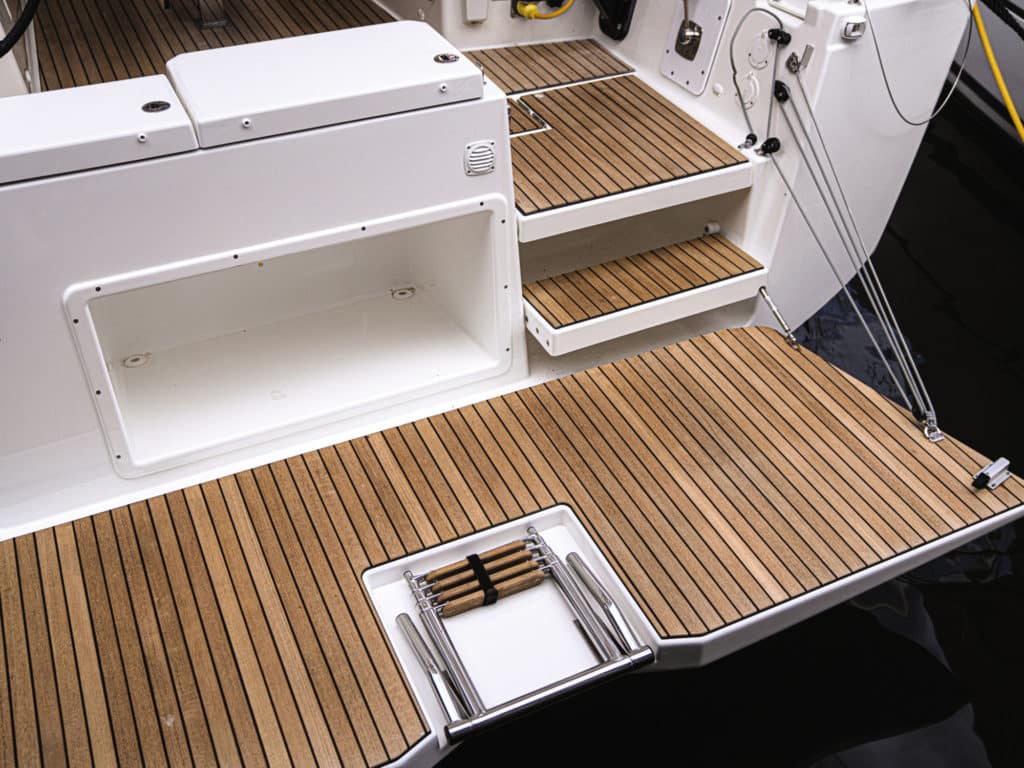
We all know stainless steel isn’t entirely stainless, and that penetrations in the deck are potentially troublesome; allowing moisture to enter a core material, such as end-grain balsa, can have serious consequences. The core and fiberglass skins must be properly bonded and the kerfs not filled with resin. Beginning in the mid-1990s, some builders such as TPI, which built the early Lagoon cruising catamarans, began using structural adhesives, like Plexus, to bond the hull/deck joint rather than using dozens of metal fasteners. These methacrylate resins are now commonly used for this application and others. Klopman says it basically should be considered a permanent bond, that the two parts, in effect, become one. If you think a through-bolted hull/deck joint makes more sense because one could theoretically separate them for repairs, consider how likely that would ever be: not highly.
Fit-and-Finish
Wide transoms spawned an unexpected bonus; besides the possibility of a dinghy “garage” under the cockpit on larger boats, swim platforms are also possible. In more than one BOTY yacht, the aft end of the cockpit rotated down hydraulically to form the swim platform—pretty slick.
Teak decks are still around, despite their spurning for many years by owners who didn’t want the upkeep. In the 1960s and ’70s, they were considered a sign of a classy boat but fell from favor for a variety of reasons: maintenance, weight and threat of damaging the deck core (the bung sealant wears out and water travels down the fastener through the top fiberglass skin into the core). Specialty companies that supply builders, like Teakdecking Systems in Florida, use epoxy resin to bond their product to decks rather than metal fasteners. And the BOTY judges saw several synthetic faux-teak products that are difficult to distinguish from real teak—the Esthec installed on the Bavaria C50 being one example.
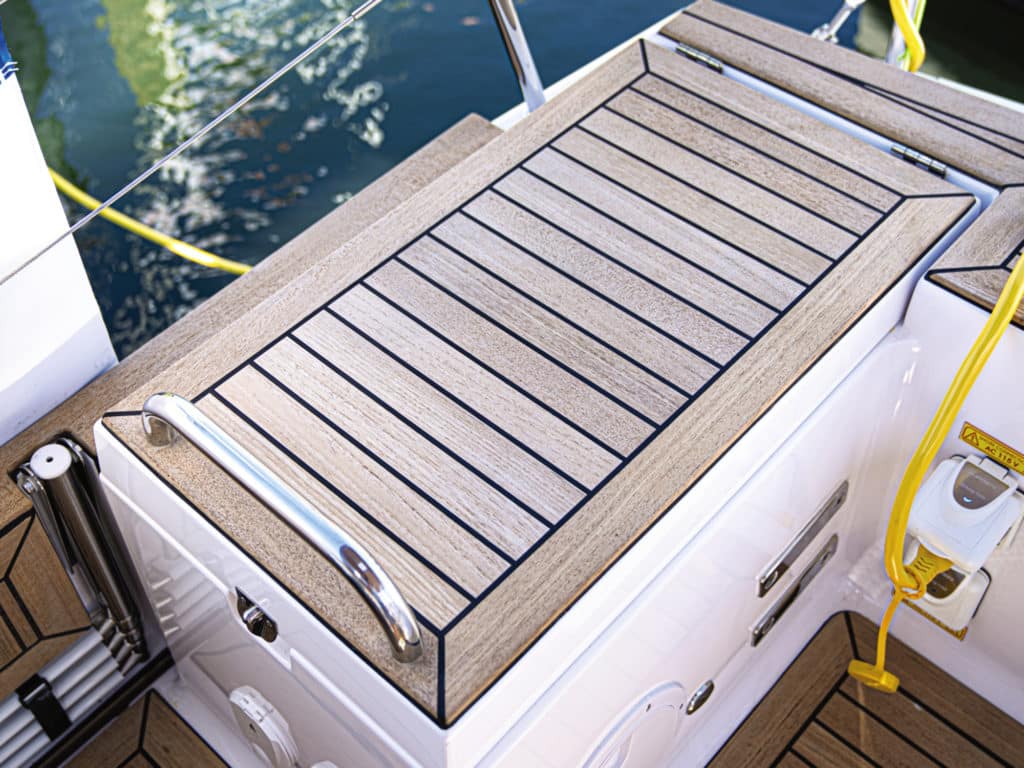
LPG tanks no longer have to be strapped to a stanchion or mounted in a deck box because decks now often incorporate molded lockers specifically designed for one or two tanks of a given size. To meet ABYC standards, they drain overboard. In tandem with these lockers, some boats also have placements or mounts for barbecues that are located out of the wind, obviating the common and exposed stern-rail mount.
Low-voltage LED lights are replacing incandescent bulbs in nearly all applications; improvements in technology have increased brightness (lumens), so some even meet requirements for the range of navigation lights. Advances in battery technology translate to longer life, and depending on type, faster charging. And networked digital switching systems for DC-power distribution also are becoming more common.
Last, I was surprised at how many expensive yachts exhibited at Annapolis had nearly the least-expensive toilets one can buy. Considering the grief caused by small joker valves and poorly sealed hand pumps, one would think builders might install systems that incorporate higher-quality parts or vacuum flushing, and eliminate the minimal hosing that famously permeate odors.
Dan Spurr is an author, editor and cruising sailor who has served on the staffs of Cruising World, Practical Sailor and Professional Boatbuilder. His many books include Heart of Glass , a history of fiberglass boatbuilding and boatbuilders .
Other Design Observations
Here are a few other (surprising) items gleaned from several days of walking the docks and sailing the latest models:
- Multihulls have gained acceptance, though many production models are aimed more at the charter trade than private ownership for solitary cruising. You’d have to have been into boats back in the ’60s and ’70s to remember how skeptical and alarmist the sailing establishment was of two- and three-hull boats: “They’ll capsize and then you’ll drown.” That myth has been roundly debunked. Back then, the only fiberglass-production multihulls were from Europe, many from Prout, which exported a few to the US. There are still plenty of European builders, particularly from France, but South Africa is now a major player in the catamaran market.
- The French builders now own the world market, which of course includes the US. Other than Catalina, few US builders are making a similar impact. In terms of volume, Groupe Beneteau is the largest builder in the world, and they’ve expanded way beyond sailboats into powerboats, runabouts and trawlers.
- Prices seem to have outpaced inflation, perhaps because, like with automobiles, where everyone wants air conditioning, electric windows and automatic transmissions, today’s boats incorporate as standard equipment items that used to be optional. Think hot- and cold-pressure water, pedestal-wheel steering, and full suites of sailing instruments and autopilots.
- More: design , print may 2020 , Sailboats
- More Sailboats

Pre-Owned: 1988 Hylas 47

Catalina Introduces the 6 Series

Sailboat Preview: Elan GT6 Explorer

For Sale: 1984 Camper & Nicholsons 58

Galápagos: A Paradise Worth the Paperwork

Around Alone

Grease the Wheels of Your Boat: A Guide to Proper Lubrication

A Bowsprit Reborn: A DIY Renovation Story
- Digital Edition
- Customer Service
- Privacy Policy
- Terms of Use
- Email Newsletters
- Cruising World
- Sailing World
- Salt Water Sportsman
- Sport Fishing
- Wakeboarding
- New Sailboats
- Sailboats 21-30ft
- Sailboats 31-35ft
- Sailboats 36-40ft
- Sailboats Over 40ft
- Sailboats Under 21feet
- used_sailboats
- Apps and Computer Programs
- Communications
- Fishfinders
- Handheld Electronics
- Plotters MFDS Rradar
- Wind, Speed & Depth Instruments
- Anchoring Mooring
- Running Rigging
- Sails Canvas
- Standing Rigging
- Diesel Engines
- Off Grid Energy
- Cleaning Waxing
- DIY Projects
- Repair, Tools & Materials
- Spare Parts
- Tools & Gadgets
- Cabin Comfort
- Ventilation
- Footwear Apparel
- Foul Weather Gear
- Mailport & PS Advisor
- Inside Practical Sailor Blog
- Activate My Web Access
- Reset Password
- Customer Service

- Free Newsletter

Catalina 270 vs. The Beneteau First 265 Used Boat Match-Up

Ericson 41 Used Boat Review

Mason 33 Used Boat Review

Beneteau 311, Catalina 310 and Hunter 326 Used Boat Comparison

Tips From A First “Sail” on the ICW

Tillerpilot Tips and Safety Cautions

Best Crimpers and Strippers for Fixing Marine Electrical Connectors

Thinking Through a Solar Power Installation

Polyester vs. Nylon Rode

Getting the Most Out of Older Sails

How (Not) to Tie Your Boat to a Dock

Stopping Mainsheet Twist

Fuel Lift Pump: Easy DIY Diesel Fuel System Diagnostic and Repair

Ensuring Safe Shorepower

Sinking? Check Your Stuffing Box

The Rain Catcher’s Guide

What Do You Do With Old Fiberglass Boats?

Boat Repairs for the Technically Illiterate

Boat Maintenance for the Technically Illiterate: Part 1

Whats the Best Way to Restore Clear Plastic Windows?

Giving Bugs the Big Goodbye

Galley Gadgets for the Cruising Sailor

Those Extras you Don’t Need But Love to Have

What’s the Best Sunscreen?

UV Clothing: Is It Worth the Hype?

Preparing Yourself for Solo Sailing

How to Select Crew for a Passage or Delivery

R. Tucker Thompson Tall Ship Youth Voyage

On Watch: This 60-Year-Old Hinckley Pilot 35 is Also a Working…

On Watch: America’s Cup

On Watch: All Eyes on Europe Sail Racing

Dear Readers
- Sailboat Reviews
Practical Sailor Takes a Look at Trends in Modern Boat Design
Is the quest for speed and interior comfort trumping smart design in todays sailboats.
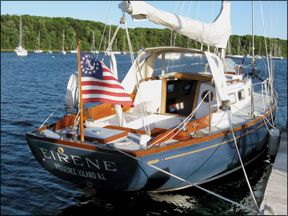
Practical Sailor editors have noticed the increasing tendency in newer-model sailboats to be ill-mannered in gusty conditions. Establishing balance between the sails and the hull is one of the main factors in quality boat design. For correct trim, many things must be considered: the ballast package location, the combined longitudinal center of gravity (LCG), and the longitudinal center of buoyancy. At the same time, to maintain a balanced helm, the keel must promote sufficient lead (the fore and aft distance between the center of effort and the center of lateral resistance). To highlight how these boat design principles play out, Practical Sailor looks at classic sailboats such as the Bill Shaw-designed Pearson 32, Ericson 41, Valiant 40, and Peterson 44, and compares their keel/sail ratios and lead values to more modern sailboat designs such as the Catalina, Hunter, Tartan, and Beneteau.
In the course of taking out boats for testing, Practical Sailor editors have observed an increased tendency for new-model sailboats to be ill-mannered in gusty conditions. We have been watching this trend for several years, and it seems to be becoming more usual than unusual.
In a typical situation, we will be sailing the test boat on the wind in 12 or so knots of breeze and everything is fine. Then, the breeze picks up to about 15 knots and the helm loads up. OK, thats to be expected, so we flatten the main, drop down the traveler, and that takes care of it.
Then we get a puff. Were already on the point of needing to reef, so in the puff, were overcanvassed. Instead of just heeling farther, the boat begins to round up. Fighting it with the helm is hard work, and easing the main so it luffs doesn’t help much.

Photo by Ralph Naranjo
We take in a reef, which usually means we roll in a bit of the jib or a bit of the main, or both, and the helm lightens up. We trim to the new wind and sail along, a bit slower now in the light spots, but then the next gust comes along, and the helm immediately loads up again.
In the worst case weve experienced, the boat rounded up so quickly that it tacked, even though the helm was hard over in the opposite direction. To prove that wasnt a fluke caused by a temporary diversion into a parallel universe, it did the same thing on the other tack.
Practical Sailor editors are old enough to remember a generation of cruising boats that didnt behave in this manner. For sure, there have always been twitchy boats, but most, when hit by a gust, would heel a little more, put some pressure on the wheel or tiller, and once the boat picked up speed, the pressure would come right off. A boat like that will sail for a long time with a loose lashing on the helm.
So, where does this bad habit come from? Several trends in modern cruising yacht design can share the blame. One of them is builders inclination to tilt their designs toward the performance end of the cruisers spectrum. Many recent and current cruising boats, if suitably fitted out with racing sails and the hardware and software to tweak them, could put up an impressive show on the race course.
The sensitivity to trim that accompanies such potential isn’t always suited to cruising shorthanded or with a family, when balance and good manners are key both to enjoyment and, to a degree, safety.
Establishing Balance
Many factors contribute to the balance of a sailboat. The obvious and principal pair are the sails and the hull. When working up a new design, the architect develops these in close association, but both are in turn influenced by other aspects of the boats design as it evolves.
In the standard approach, the designer works up preliminary drawings to express the basic requirements of the design brief, which normally include a desired length, displacement, cabin arrangement, and sailplan to provide the desired performance.
He then sketches out the hull lines (the matrix of contours that define its three-dimensional shape and its volume) to enclose the interior and meet expressed performance goals. The preliminary lines also serve as a basis on which to perform a number of calculations, one of them being the location of the center of buoyancy (CB).
With everything roughed out, the designer then “weighs” every item that will go into the complete boat, from the hull laminate to the toothbrush holder, but excluding the ballast. He combines these weights and their locations on the three axes, X, Y, and Z, to calculate the center of gravity (CG) of the whole package. Computer programs have helped to speed up this process and make volume calculations more accurate, but the process hasn’t changed much.
For the boat to float on its desired lines, the ballast package must then be designed and located to bring the combined longitudinal CG (LCG) of hull and ballast to the same fore-and-aft location as the CB (LCB). Once everything has been resolved satisfactorily, the designer can finalize the lines, carry out the necessary calculations, and establish shape and locations for the keel and the sailplan.
On most boats of current design, the ballast also constitutes the fin keel, and in that role, its location determines the center of lateral resistance (CLR), which in conjunction with the center of effort (CE) of the sailplan, influences how the boat balances under sail.
Even as boat design procedures have evolved from three-dimensional modeling using half hulls, through two-dimensional modeling using pen on vellum, to three-dimensional virtual modeling on computers, the fundamental principles have remained constant. One of the fundamental values used for predicting the proclivities of a boats helm is the dimension termed “lead.” Lead, pronounced “leed,” is the fore and aft distance between the CE and the CLR, expressed as a percentage of the waterline length (DWL).
“Skenes Elements of Yacht Design,” as revised by Francis S. Kinney, and other references for yacht design provide rules of thumb for calculating lead from the sailplan and the hull profile. (See illustration above).
Looking at the diagram, its easy to see how lead is an elusive quantity. First of all, no boat sails with the sailplan as shown-the sails are never flat and on centerline. The traditional range for lead places the CE forward of the CLR by 14 to 19 percent of DWL. This value is lifted from “Skenes,” for years the first reference for any designer. Since that book was written and updated, hull forms have changed, and with them, optimum values for lead.
On designs with fin keels, lead is often calculated with reference to the keel alone. One feature remains constant whatever the design. Moving the centers closer together-reducing lead-increases the tendency to weather helm. Moving them apart reduces that tendency. If the lead is too great, the result may be lee helm, which is generally considered undesirable-and is in fact, rare.
In Kinneys prime years, the 1960s to the 1980s, the basic working sailplan of a sloop included a 150-percent genoa, which would have the effect of moving the CE closer to the CLR. Many designs today have headsails with short or even no overlap and very often a full-battened mainsail with lots of roach. The different aerodynamic characteristics of such rigs might well affect optimum lead, something which designers can only determine through experience. (If a boatbuilder offers an in-mast furling mainsail as an option, its effect on lead will differ from that of the “classic” sailboat.)
The effective CLR can also be very different from that calculated. On a deep-bodied, full-keel hull, that difference simply might be the difference between the geometric center and the center of hydrodynamic pressure of the whole profile.
A sharp bow with a pronounced “chin” might well move the effective CLR forward. On a modern, fin-keeled boat with a shallow, broad canoe body like that of a dinghy, the keel makes a proportionately larger contribution to lateral resistance, so the location of the keel will strongly influence where that resistance operates.
Obviously the rudder, too, is part of the lateral plane, but if our objective is to sail with light to neutral pressure on the helm, under normal conditions, it should not be making a significant contribution to lateral resistance. Its role is to provide a means to change the boats direction and to compensate for the constant fluctuations in the forces applied to the boat in the normal course of sailing. A certain amount of pressure in the form of weather helm helps by providing positive feedback to the helmsman on the state of balance. That said, on many racing hulls, the rudder is designed to contribute lift and has an active role in driving the boat to windward. (It is worth noting that those wide-bodied race boats also tend to have twin rudders.)
Then and Now
Even in the age of computer modeling, yacht design remains a series of compromises. At the moment, it seems the pendulum has swung to a point where high-volume, wide-beam shapes dominate. With them come large rigs to overcome skin drag and its negative effect in light air. As a result, theres a need to sail the vessel as flat as possible or suffer the consequences.
The sailplan and outboard profiles of boats from different eras represent the shift in yacht design that has occurred during recent decades. The modern boats have longer proportional waterlines, indicating higher potential speed. It also means that the boats immersed volume, or displacement, has been distributed over a greater length.
Given two boats of similar displacement like the classic Pearson 32 and the modern Tartan 3400 (above), the Tartan winds up with a shallower canoe body. This also contributes to its being potentially faster and, if both boats had the same draft, would give the keel a slight advantage in span, and therefore effectiveness to windward.
So far so good, but a shallower canoe body forces the cabin sole upward, especially if the belowdecks accommodations are to take full advantage of the wide beam favored in the modern hull. To achieve comparable headroom with its older counterpart, the cabintop has to go up, too, and to ensure sitting headroom on the settees under the sidedeck, so does the freeboard.
Ultimately, the whole deck moves upward. To ensure the boom doesn’t sweep everybody out of the cockpit during an unplanned jibe, the boom too goes up. If sail area is not to be compromised, the entire mainsail goes up, and with it, its center of effort. The bigger the boat, the less pronounced these differences become as the proportions become more relaxed.
Differences are visible, too, between the boats keels; the modern Tartans is smaller in area. While it might be claimed that less wetted surface promises higher sailing speeds in light air, some builders accept a smaller keel to simplify the manufacture of the hull.
In a perfect world, the designer draws a keel to suit the boats sail area and other characteristics, places it to obtain the desired sailing performance, then massages the needed ballast to both fit the keel and trim the boat correctly. The volume of the ballast is usually less than that of the keel, and the builder has to do some intricate laminating work to mold a keel to receive ballast internally or a stub to which to bolt it externally.
On many production boats today, the keels are bolted directly to the bottom of a fair canoe body, a practice which eliminates much labor. The consequence is that the area of the keel is determined by the weight, and therefore the volume, of the ballast. To achieve the desired hydrodynamic properties and mechanical strength-it mustnt bend under the influence of normal sailing loads-a given volume of ballast can be formed into a limited range of shapes. Placing ballast in a bulb at the bottom aids the keels efficiency by creating an endplate effect and raises stiffness by placing ballast low, but it means that the keels lateral plane is sharply reduced.
For a more dramatic representation of how changes in keel design can affect helm balance, compare a Cruising Club of America (CCA) design like the Ericson 41 above, to a modern equivalent with comparable sail area like the Beneteau 46.
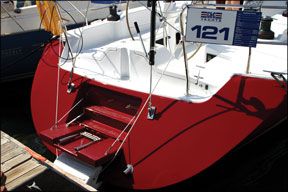
When sailing, two boats are subjected to similar forces on the sails. Resisting that side force are the immersed hull, the keel, and the rudder. If the hulls offer similar resistance, the remaining force is shared between the keel and rudder. If one keel is smaller than the other (as is clearly the case here), the effect is to increase the share taken by the rudder.
When the sails are trimmed properly and all is in balance, the rudder will carry a small load. If however, you hit a gust, the rudder must pick up a high proportion of the added side thrust until balance is restored, usually by some adjustment to sail trim.
Simply put, boats of the general modern type are not forgiving in changeable conditions, say, for example when the apparent wind is in the 12- to 18-knot range. At the higher end, youd want to be reefed; at the lower end, probably not.
On a day when you expect the wind to soften rather than harden, youd rather not put in the reef, so that you can maintain speed in the lulls. In the puffs, you want your hands free to ease the traveler and flatten the jib, which is hard to do if the helm is a handful. Compounding the problem on most boats, the mainsail controls are usually not within reach of the helm.
On racing boats, such sensitivity isn’t an issue. On the contrary, sufficient crew are on hand to make adjustments on the fly as quickly and often as needed to keep the boat sailing at her fastest.
Cruising boats are often sailed shorthanded and by crews who are not looking for a constant physical workout. An autopilot might be doing most of the steering, and good balance is helpful in protecting it from having to work too hard-or from being overpowered.
Another striking difference between the older and newer designs is visible in the plan (overhead) view. By 1980, cruising-boat hulls were already becoming beamy relative to boats of the 1960s and 1970s. The current trend is to carry the beam aft, so that in the region of the rudder, its as much as 85 percent of the maximum beam, far wider than the 55 percent to 60 percent once considered acceptable. The principal beneficiary of this extra breadth is the boats interior-builders often offer twin double cabins aft where a generation ago they might have squeezed in a quarter berth and a cockpit locker. The cockpit, too, becomes roomier, and the transom, scooped and sculpted, is transformed into a swim platform and dinghy dock.

Photo by Jarrod Scanlon
All this additional boat aft adds weight aft, in both construction materials and outfit. To compensate, the ballast-that is to say, the keel-has to be fitted farther forward.
The full beam aft does provide a significant boost to the boats ability to carry sail. As the boat heels, the center of buoyancy moves quickly outboard, away from the center of gravity. This lengthens the righting arm, giving a positive contribution toward stability, but it also moves the immersed centerline of the hull away from the static centerline along which both the keel and the rudder are attached. Depending on the hulls shape, this can create a distortion in the immersed volume, which can in turn affect the dynamics acting on it.
Effect of Keel Area
Another factor entering the equation is the area of the keel. This, too, is apparent when comparing the drawings of the older and newer generation boats. Many of the standard tracts on the design of sailing yachts are, lets say, vague on what keel area is adequate or even desirable, although many designers have come up with their own formulas.
Because the keel is reacting in the water to forces generated on the sails by the wind, it makes sense that the area of a fin keel should be related in some way to sail area.
When naval architect Dave Gerr took over as director of the Westlawn Institute of Marine Technology, he found the course materials for sailing yacht design had little detailed explanation on this topic, a gap he subsequently filled. Briefly, he recommends no fin keel should be less that 2.5 percent of the sail area (mainsail 100 percent foretriangle) and need be no more than 5 percent. The smaller value is appropriate for a racing boat with a full crew aboard to trim and tweak the sails to every change in the wind. The larger area is suited to cruising boats, which need to be more forgiving to shorthanded crews.
Current Design Trends
In the past, racing measurement rules have been criticized because the boats designed to compete under them have become type-formed, sometimes with unwelcome consequences in how they handle. We might just as easily level criticism at present-day marketing and manufacturing methods for doing the same to cruising boats.
Lets face it, but for a few differences in sailplans and keel shapes, modern cruising sailboats are quite generic below the sheerline. They are all beamy; they carry their beam aft; they have long waterlines; they have dinghy-like underbodies; and they have spade rudders. The forces that have created this shape have at least as much to do with how many people can sleep and shower in them comfortably as with how the boats will sail.
Dishing out the hull shape in this manner makes it fairly easy to push through the water, but arranging the keel, rudder, and sails so they work in concert has become a more complex problem, exacerbated by having to compensate for extra weight of accommodations aft, something thats less of an issue in raceboats.
The byproduct of these design parameters is zesty performance, a bonus for the marketing department, but speed for its own sake is not the first priority of cruising sailors. In the brochure for the Beneteau 37, the boats polar diagram shows a maximum theoretical sailing speed of over 12 knots in 30 knots of wind. When cruising sailors encounter 30-knot winds, they are more likely to hunker down in the expectation it will blow even harder than they are to set the chute to go surfing. What they want is a boat that will take readily to hunkering, and all the signs indicate those boats are getting fewer in number . . . and they are mostly older designs.
- The Balancing Act
- Pearson 32 vs. Tartan 3400
- Ericson 41 vs. Beneteau 46
- Practical Sailor Design Guide
- The Modern Hull and Helm Balance
RELATED ARTICLES MORE FROM AUTHOR
Leave a reply cancel reply.
Log in to leave a comment
Latest Videos
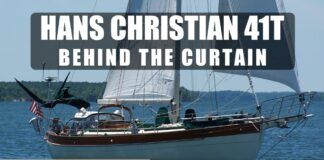
Hans Christian 41T – Boat Review

Seven dead after superyacht sinks off Sicily. Was the crew at...

What’s the Best Sailboats for Beginners?

Why Does A Sailboat Keel Fall Off?
Latest sailboat review.
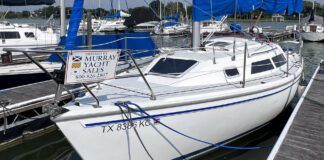
- Privacy Policy
- Do Not Sell My Personal Information
- Online Account Activation
- Privacy Manager
Attainable Adventure Cruising
The Offshore Voyaging Reference Site

- Sailboat Deck Layouts
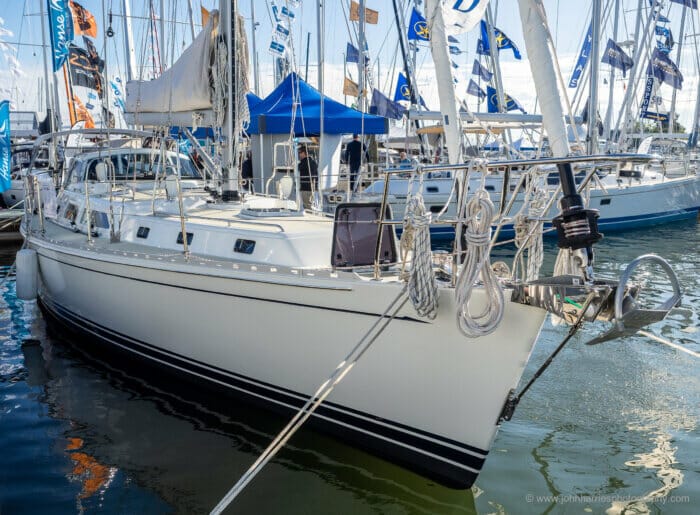
I’m going to use the Outbound 46 as a base to write about optimal deck layouts for sailboats. Information that will help anyone to either select a good deck layout when buying a boat, or fix a screwed-up one on a boat they already have.
Good Deck Layouts Are Rare
That last sentence may surprise many since it would be logical to expect cruising sailboats to have good and functional deck layouts, but as an ex-sailmaker and longterm racer, the thing that never ceases to amaze me is that most boats, particularly those marketed as cruisers, come out of the yard with the rig and deck gear set up so poorly that actually sailing them is nothing but a huge chore, and it takes years for even a knowledgeable owner to sort things out—just read Colin’s trials and tribulations with the rig on his Ovni 435 to see what I mean.
This is so bad that I’m pretty sure that the popularity of in-mast and in-boom mainsail furling systems is in large part because most boats are so poorly set up for reefing that owners have been scared off simple and robust systems and toward complex, fragile, and expensive ones.
I will also write, once more, about speed. I know, we are cruisers, so why do we care? Well, up to you, but to me if we are going to really cruise under sail, rather than just motor around with an oversized flag pole and occasionally unroll a sail attached to it as we see so often these days, we might as well do it properly.
Seriously, a well set-up boat, efficiently reeling off the miles under wind power alone, is one of life’s sublime pleasures, and knowing that we can control the rig and shorten sail quickly and efficiently without automation or brute strength is the cherry on top.
Let’s look at how to do that:
Login to continue reading (scroll down)
Please Share a Link:
More Articles From Online Book: Sail Handling and Rigging Made Easy:
- Six Reasons To Leave The Cockpit Often
- Don’t Forget About The Sails
- Your Mainsail Is Your Friend
- Hoisting the Mainsail Made Easy—Simplicity in Action
- Reefs: How Many and How Deep
- Reefing Made Easy
- Reefing From The Cockpit 2.0—Thinking Things Through
- Reefing Questions and Answers
- A Dangerous Myth about Reefing
- Mainsail Handling Made Easy with Lazyjacks
- Topping Lift Tips and a Hack
- 12 Reasons The Cutter Is A Great Offshore Voyaging Rig
- Cutter Rig—Should You Buy or Convert?
- Cutter Rig—Optimizing and/or Converting
- Cruising Rigs—Sloop, Cutter, or Solent?
- The Case For Roller-Furling Headsails
- The Case For Hank On Headsails
- UV Protection For Roller Furling Sails
- In-Mast, In-Boom, or Slab Reefing—Convenience and Reliability
- In-Mast, In-Boom, or Slab Reefing —Performance, Cost and Safety
- Making Life Easier—Roller Reefing/Furling
- Making Life Easier—Storm Jib
- Swept-Back Spreaders—We Just Don’t Get It!
- Q&A: Staysail Stay: Roller Furling And Fixed Vs Hanks And Removable
- Rigid Vangs
- Building A Safe Boom Preventer, Part 1—Forces and Angles
- Downwind Sailing, Tips and Tricks
- Downwind Sailing—Poling Out The Jib
- Setting and Striking a Spinnaker Made Easy and Safe
- Ten Tips To Fix Weather Helm
- Running Rigging Recommendations—Part 1
- Running Rigging Recommendations—Part 2
- Two Dangerous Rigging Mistakes
- Rig Tuning, Part 1—Preparation
- Rig Tuning, Part 2—Understanding Rake and Bend
- Rig Tuning, Part 3—6 Steps to a Great Tune
- Rig Tuning, Part 4—Mast Blocking, Stay Tension, and Spreaders
- Rig Tuning, Part 5—Sailing Tune
- 12 Great Rigging Hacks
- 9 Tips To Make Unstepping a Sailboat Mast Easier
- Cruising Sailboat Spar Inspection
- Cruising Sailboat Standing Rigging Inspection
- Cruising Sailboat Running Rigging Inspection
- Cruising Sailboat Rig Wiring and Lighting Inspection
- Cruising Sailboat Roller Furler and Track Inspection
- Download Cruising Sailboat Rig Checklist
Hi John I could not agree with you more about how frequently boats with conventional mains are poorly set up for easy reefing and eventual dousing. It is another area where the maritime media/boatbuilders etc. have dropped the ball at educating owners how best to have their boat set up. Too many sailors (and their crew) get put off by a poor and difficult reefing set-up which likely means they have put off reefing and been over-canvased needlessly: always a lousy thing. Enough of that and they are buying a cabin in New Hampshire. I urge those looking at in-mast or in-boom furling to consider that reefing and dousing the main can be easy and fairly fast and with a minimum of effort on a boat that is well set up for it. I then enumerate the myriad down-sides of particularly, in-mast reefing/furling and the benefits of a conventionally rigged main. I am in no way a speed demon, but I like to sail and I like to sail well. You mention sublime pleasure in cranking out miles: my sublime pleasure often comes at watching superbly shaped sails at work; especially when in challenging weather, the third reef is in and working and that small sail is perfectly shaped to do its job and as bulletproof in functioning as can be devised. My best, Dick Stevenson, s/v Alchemy
I agree completely, particularly on the pleasure of looking at really good mainsail shape when reefed.
Hi John, I totally get your “simplicity” approach and at mast mainsail handling preference. It just wouldn’t work for us and I suspect for many other cruising couples. I think I can see at least one hatch in the Outbound 46 hard-dodger top, which means adjusting the halyard / reefing lines and setting the mainsail / twist, should be simple enough from the cockpit, if (big “IF” I know) the reefing lines are well set-up. And I personally like this set-up for short-handing. Our safety process requires a second crew to be in support, if someone leaves the cockpit (day or night, coastal or offshore). I would guess we could reef / shakeout a reef on the Outbound 46, without calling the off-watch crew – a real-plus in our book as we mostly sail two-up. Our first mate would not cruise with me if I left the cockpit every time we needed to take a reef in rough conditions. It’s that simple. And if something happened to me, there is no way she would go forward to the mast and handle the sail on her own. Whereas she can, and does, reef single handedly on our boat, and I would guess she could on the Outbound 46 set-up, which is almost identical to our boat – the difference is we have in-boom furling which simplifies operations further. Likewise, the outbound 46 set-up would be easy and safe to hoist / lower / reef the mainsail when single-handing. I see so many single-handing yachts sailing just with their headsails, I suspect because on-mast mainsail handling leaves no one in the cockpit, if something happens. I often single hand our yacht with no loss of efficiency and really enjoy it. Br. Rob
I just can’t see that twisting ones head to look up out of a small hatch to see the mainsail while simultaneously grinding a winch and operating clutches is ever going to provide the visibility and situation awareness of looking directly at the part of the sail you are tensioning while standing at the mast while right next to the luff where any hang ups can be quickly seen and dealt with. So yes, for sail trim the hatches may help a bit, but not for reefing. Also at night on the Outbound a headlamp will reflect off the hatch glass making visibility of the main effectively zero.
I agree that being able to reef and shake out without calling the off watch is vital, but we do that fine at the mast too. Phyllis and I are also not fans of the idea of calling the off watch every time someone leaves the cockpit since we feel that the disruption of rest outweighs and added benefit of so doing.
I guess that relates to our basic thinking that the deck, particularly as far as the mast is not an intrinsically hazardous place to be avoided, but simply part of the working area of the boat, just as the cockpit is. We feel that regularly visiting the mast in all weathers is vital since it will be required anyway for functions like setting a proper preventer, setting the pole, and moving the runners forward, not to speak of clearing any kind of SNAFU.
We also differ in that we evaluated in boom furling/reefing and rejected it as too fragile, difficult to fix at sea, and expensive for our needs. That was based on experience in that the boat I did was on for six weeks as guide on a trip to Greenland had one.
So, in summary, I guess we just see things in a fundamentally different way.
Like you I mostly sail singlehanded or effectively singlehanded and I don’t really regard going forward in a rising wind as a pleasurable experience, especially in the dark. I’d like to add granny bars at the mast but worry that they would be extra deck clutter and spoil “the look”. But I’ve got to say I’m with John on this one. There’s quite enough string in the cockpit already without adding seven more bits. And, while in boom furling does look attractive, for me its too reminiscent of the appalling old rotating boom mainsail furling system I had on my first yacht, a Folkboat. The sail shape one got on that in any but perfect conditions was sad to see.
The sailor who puts in an early reef is a happy sailor. And probably longer living. How often is one surprised at the improved performance that results from under-pressing the rig ? And, while there is a lot that can lengthen the time at the mast putting in a reef, shaking an unnecessary one out really is a matter of seconds.
In defence of modern in boom furling, the set is way better than it was in the bad old days of roller reefing mainsails. That said, my big problem with them is complexity and fragility. Probably fine for inshore sailing where if they break you can just take the main down and head for somewhere to wait for parts and with smooth water where you can fix it, but I would never take one offshore, and particularly not to the high latitudes. All this based on taking a yacht to Greenland with one.
I own a Outbound 46 hull#50. Would add the following. The hydraulic backstay is quite helpful reefing the Genoa. Put tension on that stay and she rolls up more easily. Unless you tune the rig with more tension on the solent stay then the Genoa stay when the backstay is untensioned you get headstay sag on the solent. You lose nothing upwind using the solent instead of the Genoa going upwind so the need to roll up the Genoa before tacking is a non issue as it ends up being a reaching or running sail. We stand single watches. I love having both the primaries (powered) and the headsail reefing lines an arms length away from the wheel. I can reef under control, by myself with no engine nor AP. Then go forward and deal with reefing the main. I can do it under Hydrovane. Not needing to bring anybody up from below is wonderful. I hate single line reefing on any boat. It better than in boom or in mast but not by much. If done get a Dutchman as well. That makes it easier to inch the main down and have both ends of the sail tension correctly as you can see what’s going on and the sail has no choice but to fold correctly. Outbound come single for first two and double for the third. Would think to get just two very deep reefs and make both double. I have the survey being done on Tuesday. Then she’s gone as we transition to a Norhavn. The Outbound is the best mom and pop blue water cruising boat there is imho.
I too am not a fan of single line reefing so I think your recommendation to go with two deef reefs each with two separate reefing lines would be a good one.
That’s how we went, but then as a comparatively heavy motorsailer, we tend to leave the full main up a little longer than some just to make the boat go. We have separate reefing lines, as well and have all halyards and related lines at the mast. We have preventers, staysail sheets, yankee jib sheets and occasionally, spinnaker sheets back to the winches (three pairs) in the aft cockpit position, where there is also end-boom mainsheeting (6:1) and a strong Garhauer traveller (3:1). Works for us to date. I have over the years become a touch suspicious about “convenience” unless the sea first makes its case.
I agree was many of your points and know by your article I am not going to convince you, but we love being able to put in and take out reefs in from the cockpit. We can easily put a reef in or shake a reef out in less than a minute on our 37 foot cruising boat. I have read Colin’s article and I think a single line for each reef is way too much friction. We use a second line to pull the tack into the right position at the goose neck. These lines on our boat are only 5/16. Each one is led from the reefing hook, through the reef tack crinkle to a carefully placed bullseye on the mast, through a pulley at the mast base and then back to a harken cam cleat next to my jammers. You never need to put this on a winch – the idea is to get the bullseye position such that you end up with the reef crinkle pulled into the goose neck at just the right position when the halyard is re-tensioned. The clew end is conventional – from a bowline positioned about 6 inches aft of where you could stretch out the foot of the sail at the reef point up through the reef clew cringle to pulleys at each end of the boom through a good block at the base of the mast and then to a jammer and winch at the cockpit. When putting in a reef we pull down on the tack line while easing the halyard. Don’t allow slack in the halyard – the jammer is cast off but the halyard is restrained by hand with a single turn around the winch. 2 or 3 times we will pause in this operation by locking the halyard jammer and pulling the slack out of all the other tack and clew reefing lines by hand. We have found that this is the secret to being able to complete the whole operation from the cockpit since minimizing slack loops prevents them getting caught up anywhere. We continue until the halyard is just past a mark on the halyard line and then put the tack line in the cam cleat. At night we shine a flashlight on the tack to make sure it is neatly pulled into the gooseneck and then tension the halyard on the winch. Once again take the time to take all the slack out of the other reef lines by hand. Put the clew reefing line on a winch and crank until you are happy with the foot and leach tension – you need to check this with a flashlight at night.
Our reefs can be put in in way less time than it takes to write about it quickly and safely from the cockpit without even having to put your jacket on. Because we can put in or shake out reefs in the main easily we do not procrastinate for a moment about reducing or increasing mainsail. Our record is 11 changes in a single 3 hour shift as a series or 20 minute squalls rolled through at night close to the equator on a passage from San Francisco to the Marquesas and the lone watchkeeper was busier than a one armed paper hanger reacting as the wind went up and down from 8 to 30 knots!
Sounds like a good system. And I agree that taking the slack out of the non-loaded reefing lines as you reef is important. We do the same at the mast.
Really glad to see you giving the Outbound a thorough look, John!
Having cruised full-time aboard an Outbound 46 from 2017–2019 (we no longer own the boat), I can report that the main halyard and reefing setup works exceptionally well. The only annoyance was, as you pointed out, somewhat poor ergonomics crouching under the dodger (I’m 6’3″). The dodger hatches are perfectly positioned (like everything else on the Outbound) so you can actually see the main while hoisting, reefing, and trimming.
I saw your response to Rob about working at the mast. I agree that the side decks and mast are “part of the working area of the boat”. On balance, considering all the factors, reefing from the cockpit gave us (my wife and me) more flexibility and more peace-of-mind than reefing at the mast, which we did on our previous boat (a Sabre 38).
Aside: I also appreciated how cockpit reefing lowered the behavioral “friction” of making the decision to reef. Leaving the cockpit (with all associated precautions) just feels… harder than staying in the cockpit. Reducing sail at the right time is one of the most critical components of safe and comfortable cruising, and I was glad I never had to “think twice” because I didn’t want to deal with leaving the cockpit. Perhaps that’s irrational, but so are we all 🙂 I think of it as behavioral systems engineering.
Interesting point on “behavioural” friction. It’s not a problem we have ever suffered from, probably because I actually like “ deck sports ” and as a ex-racer and sailmaker I can’t stand being under or over canvased, but I can certainly see that it could be an issue, particularly for people who have been subjected to poor deck layouts and therefore regard reefing as a huge chore, no matter how they do it.
That said, I think that this “behavioural friction” is something we should all work on overcoming and not give into or modify our boats to pander to it. In my experience, not getting out on deck regularly can lead to all kinds of problems, particularly being lazy about rigging proper preventers and generally checking things over from bow to stern at least twice a day, more often in heavy weather.
Don’t get me wrong, if you find in cockpit reefing works for you, that’s fine, it’s your boat, but if that leads to rarely leaving the cockpit for other vital functions, then I think it’s a mistake.
Perfect timing John.
After six weeks of hard work my right now my deck is a perfectly clear expanse of white. Almost literally a clean sheet of paper. (So far 60 litres of Jotun epoxies with another 16L of Hardtop AX to go.)
Up until this point I my general for the deck layout was heavily influenced by the majority opinion I kept encountering locally which was to run all the mainsail controls back to the cockpit. But because there is a major step in our coachroof which forces two 30 deg turns in all the lines, I was always a little apprehensive on friction. So after reading this article (and a similar one from Peter Smith) I’m inclined to follow your advice.
All my halyards can readily stay at the mast, but moving all the other mainsail lines, the reefs, topping lift, outhaul, cunningham and vang back to the mast creates quite a traffic jam around the base of the mast. Any hints on how best to organise particular brew of spaghetti?
The key to keeping that spaghetti organized is to keep all the reefing and outhaul lines on the boom, rather than lead them down to the deck. We have an article on that with photos here: https://www.morganscloud.com/2010/11/19/reefing-a-sailboat/
Note that since I wrote that, we changed from jammers to clutches.
The vang control is the exception to my rule, and should be lead aft to the cockpit. Or, on boats over about 30,000 lbs a hydraulic vang with control in the cockpit is a good solution.
Hi John and all, I was not going to wade in on this, but wish to underline a couple of points and make a suggestion. In my estimation, getting rid of friction is a safety issue and not merely convenience, in part because friction (among other things) causes skippers to hesitate doing the right thing. This is the case for a racing boat with strong crew, but far more the case for a cruising couple. Also, friction might mean that a job does not get done well: say a sloppy reef that hurts the sail and degrades sail shape and sailing efficiency. Finally, to often I suspect the push for electric winches etc. is a result of poor design and unnecessary friction in the system. An example is the retrofit of an electric main halyard winch before one installs slippery mainsail track (as well as adding low friction blocks that may be in the system). Getting rid of friction has a good start with slippery mainsail track and low friction blocks and wise design. Few boats are offshore ready as built/designed which is a shame as it is a subsequent expense in $$ and time that is not necessary. And we all like to think our boat is good-to-go from the get-go so it is hard to immediately replace new items. It would not be hard for manufacturers to get it right from the get-go at little additional expense. Slippery track allows one to raise the main almost the whole way from the mast if design allows for full body stretch to get your whole weight into play. This changes a few minutes winching “ordeal” into a few seconds exertion followed by a few turns by winch handle to tension: easily done whether at the mast or under the dodger. This is convenient and fast, but not necessarily a safety issue. The safety aspect comes when reefing is done easily and without hang-up, when reefing/dousing is accomplished going downwind in a breeze, and when dropping the main and it comes down like an express train. My boat came with in-cockpit reefing (1st 2 reefs with the third reef downhaul done at the mast) and we have made it work and like it: in part because either of us can quickly and efficiently do the first 2 reefs alone from the cockpit whereas going on deck at night in boisterous conditions, we wake the off-watch. (We do “deck tour” inspections at change of watch when both of us are awake and kitted up.) Reefing from the cockpit, for us, takes a good deal of prior preparation at the onset of the season: mainly ensuring that line markers are in the correct place on all reef lines and halyard for each reef. This gets us very close to a good reef, but sometimes takes a bit of fine-tuning as things settle down and stretch out as the sail fills. This is easily seen from the cockpit and is accomplished by tweaking the reef/halyard lines from the cockpit. As to the spaghetti that is so often mentioned as the major downside of in-cockpit reefing, our solution is to snake all “tails” down the companionway. This is only done when reefed down and accumulating lines. On Alchemy, this could be (when deeply reefed and using all lines for adjustment) up to nine lines: 2 reef downhauls, 3 reef outhauls, 1 halyard, 1 main sheet, and 2 traveler lines. (Sounds terrible, doesn’t it!) These tails then reside comfortably on our engine box ½ way down to the floor or, at times, on the floor next to the bottom step. Lines, stored in this manner, are always good to go without tangles or the need to uncoil and ensure they run free. The lines, being lead next to and held to the sides of the ladder, never interfere with safe access to the steps. There are times, of course, where we wish to close up and when that occurs, we can do so with the washboards in and the hatch mostly closed. Those fortunately rare times where we wish to be fully closed up, securing the tails in the cockpit so they are not in the way, but ready to be worked takes a bit of work, but is no big deal. I suspect not all companionway designs lend themselves to this solution, but it has worked a peach for us for decades, and may help with the “spaghetti” mess for some boats where cockpit reefing is chosen. My best, Dick Stevenson, s/v Alchemy Ps. It has not been mentioned, I believe, but I would guess that the size of one’s boat may play a part in the choice/comfort level of going on deck in boisterous conditions. Bigger boats are just a lot more stable and predictable in their motion, smaller boats livelier and quicker to react to a wave slap or wind burp.
I totally agree on adding a slippery mainsail luff track. Adding ours a few years after we bought the boat is definitely the change we have made with the largest benefit.
Great. I’ll implement that. I hadn’t thought of double ending the reefing lines so that you can work from both sides.
I’ve also had a good yarn with a local with a very similar boat and 30 years of continuous live on the boat experience. He made an interesting observation on the lines led aft vs at the mast debate; his decision point is ‘if you an offshore sailor then reef at the mast’. His reasoning is that the longer passage the more likely something will go wrong, the more important it is you are well accustomed to leaving the cockpit in adverse conditions. And that applies to the whole crew. At the same time he acknowledges there is no absolute answer, that like everything else the decision is a compromise, and others will lead the lines aft for reasons that work for them.
He backs this up with good lifelines and a solid mast pulpit. Both of which I’m going to implement as well as per your articles in the past.
Thats an interesting way to look at the decision. But the more I think about it the more I worry that the trend to aft lines combined with cockpit enclosures is producing a generation of sailors who regard the deck as a scary place to be avoided, which I think is a very worrying trend. I have an article brewing on that.
That said, I’m sure there are sailors who are comfortable on deck and have the lines lead aft, which is all good.
Point being that I’m pretty sure that not going out on deck regularly is actually more dangerous than doing so.
Hi John, You write: “Point being that I’m pretty sure that not going out on deck regularly is actually more dangerous…” Good point. Take, for example, the learning curve for working the boat with harnesses attached so as to not get tangled or so frustrated as to unclip. If this is not done with regularity, such as during regular deck tours, then it will be more difficult when it comes to needing to work the boat in boisterous conditions. Or using the deck tour time to find handholds when heeled over 15-20 degrees so that your hand knows instinctively where they are at night with spray in your face. My best, Dick Stevenson, s/v Alchemy
The cockpit enclosures bother me. Particularly in our tight, high-traffic waters, I think they take away too much visibility and too much situational awareness. Three times out of four, if I have to take evasive action despite being the stand-on vessel, I’ll notice a full cockpit enclosure on the boat (power or sail) that didn’t see me.
We actually took our soft dodger down entirely last week and are finding that, in our local conditions (where waves do *not* break over the deck), the extra visibility is way more valuable than the shelter.
All lines led aft often makes for a real mess of spaghetti (read: tripping hazard) around the companionway. Trip-and-fall is, IMHO, likely a bigger risk than slipping overboard from the deck. I’m surprised by how many designers & builders think that a line just ends at the winch, and forget about the 50 feet hanging off beyond that. (It’s an issue at the mast, too; a lot of boats seem to have no good place to put coils of excess halyard, reefing line, etc. once the lines are tensioned.) I also see a lot of boats with no good places to clip a harness tether or rig a jackline, and am starting to think that this particular issue needs to be addressed at the “textbooks and engineering design standards” level.
I agree on the dangers of cockpit enclosures. The boat that nearly hit me last summer was being run from a totally buttoned up cockpit enclosure: https://www.morganscloud.com/2019/08/24/dont-alter-course-to-port/
That said, I think that cockpit enclosures can be used safely, like most things, as long as we keep them open when we should so we can see and hear.
Bottom line, buttoned up cockpit enclosures are just another manifestation of the fundamental problem: putting comfort ahead of safety.
I wonder if it’s partly related to the boat’s seakindliness. A large, long-for-its-displacement yacht like MC has a much gentler action at sea than a lightweight, beamy, modern, race-inspired, accomodation-maximised-for-LOA “cruiser.” Leaving the cockpit in a small light boat is a lot scarier than doing it on a large heavy one.
You might be right, but the Outbound 46 would not fall into that class.
Also, my thinking would be don’t own a boat, at least for offshore sailing, that scares you so much that you don’t want to leave the cockpit.
Regarding backstay tensioners – I am pondering my head how to handle twin (not split) backstays. For split backstays you might use a tensioner car as you had linked to, but this will not be possible for twins. I notice that MC has twin backstays, how did you set it up to allow symmetric tensioning/slacking them?
The best solution is two hydraulic rams plumbed to the same pump. Set up this way, they automatically equalize tension between the two stays.
John, thank you for teaching us North Americans a new phrase today “poor diddums”,I like that.
As a retired rigger, if is even possible to be one, I could not agree with you more on not leading everything back to the cockpit. Very expensive and all that hardware sends friction through the roof. Just leave it on the mast where it belongs. My customers would say, but it’s not safe to go out of the cockpit at night or when the wind starts kicking up. If it’s not safe to leave the cockpit, you need to make it safe to leave the cockpit. You need a good Jack line system such as the one you described. You need a good hand holds so no matter where you are on deck there is something to hold onto. Solid hand rails rather than stanchions and wire. Best if you don’t have to bend over to find them. Handrails that when you stick your hand out that’s where they are. At the very minimum some kind of a deck edge so you don’t go sliding off the deck, bulwarks are even better. Mast bars that allow you to wrap a leg around to free up both hands are a great addition.
When it comes to hoisting the mainsail, or reefing it. A low friction system is the only way to go.. Finally broke down put a Harken bat car system on including bearings on the intermediate slides. Easy to raise the main, very easy to reef. Does not matter what the wind direction it is when reefing. Mark the reef points on the halyard with whippings so that you can feel them in the dark. It’s always a chore when you drop the sail a lot farther than you needed to. Only to have to winch it back up when it’s full of wind.
The photo of the mast base turning blocks illustrates one of my little pet peeves. The shackles are not safety wired. After having the main sheet blocks, come adrift from the traveler one day, thankfully in light air. I safety wire every shackle not taken on and off on a regular basis. Including roller furling headsail shackles.
I could not agree more!
And I agree on shackles too. That said, for roller furlers and the like I have had good luck with the self locking shackles that have little flats on the non-threaded side of the pin hole that stop the pin backing out.
Hi David and John, And I have had good luck with a little dab of silicone on the threads. I don’t like sharp wire ends about near sails or where line can be dragged over them like at the base of the mast. It is arguable that my skill at tucking them out of trouble could use improvement. Dick Stevenson, s/v Alchemy
Hello John! I have enjoyed reading your many articles over the past few years. This deck layout one is an excellent discussion and observations. I went through the same process several years ago before purchasing a new boat. I settled on an X-Yacht Xc38 with a John Mast. It has an outstanding deck layout whereby we sail short handed all the time and I have sailed in several long distance single handed races with some horrible weather. I have added inboard jacklines which increases safety when going to the mast (very infrequently) or the foredeck when hoisting the asymmetrical spinnaker or Code 0. I installed a rope clutch on the mast for single handed hoisting of the spinnaker and Code 0 sails. We did put an electric winch for the mainsail halyard! It is a well made offshore cruiser/racer.
Hi Stanley,
I have long been a fan of X-Yacht. Looks like a really fun boat.
I do like lines and halyards at the mast for many reasons explained here. My vintage Tartan 40 has everything except jib halyard led to cockpit. A tides marine track allows me to hoist main to nearly masthead from cockpit. And better yet, a clam cleat installed on mast a few feet below the main halyard exit allows me to even more easily hoist main from the mast, place halyard in clam cleat, and then pull in slack and tension from cockpit. Clam cleat releases and stays well clear once line is led through sheaves. For my use this is enough of a “best of both worlds“ compromise that I won’t go through trouble of moving winches and lines. And I do like being able to drop main from behind dodger in a squall into the cradle cover. I recommend everyone with aft led main halyard at minimum install the clam cleat as it greatly improves ease of raising main particularly with lazy jacks.
Hi Michael,
That sounds like a good idea.
The debate of cockpit versus mast based reefing is an interesting one. In the compromises of boats, our boat came with everything done from the cockpit and it would be very difficult to retrofit to mast based reefing so I have never really considered it. This works okay for us as the loads are relatively light due to being a smaller boat and we do not have a big enclosure so vision is not overly impaired (the boat came with a full cockpit enclosure that didn’t even feel safe for motoring so it has never been used). Like Dick mentions above, we send reef line tails down the companionway in most conditions and it works well. To me, the best part about this setup is that it is safe and easy to reef with a single person on deck when there are lobster pots around preventing long absences from the autopilot controls. I suppose that you could get an autopilot remote and bring it to the mast but in the cockpit, it is easy to hit a course change on the autopilot in the middle of reefing. One other thing that I like is that I can get the jib down (hank-on) into a position where it is secure enough for a little bit while steering simply using a downhaul that is led aft, this is super helpful coming into harbors.
If we had our boat setup as a primarily offshore boat, I suspect that I would prefer to do everything at the mast and of boats that I have sailed on, generally the ones done at the mast are better. The issue with pot buoys would go away and the clutter in the cockpit would be a bigger deal. Similarly, the position of the primaries may well be dictated by what the boat is being used for. Offshore, most people don’t hand steer and there tend to be very few people on the boat making forward in the cockpit a good option. Coastal, many more people will be hand steering and there are often people sitting in the way of winches that are further forward. Our boat actually has the winches further forward and when sailing solo, I would strongly prefer having them aft. It is especially the case when short tacking somewhere when I end up steering with 1 foot so that I can reach both the wheel and the winch, otherwise I would need to use the autopilot which is not my preference (I know that I am weird on this one, even offshore I hand-steer whenever we are sailing and there aren’t other things requiring attention, I suspect this comes from growing up on boats without windvanes or autopilots).
One thing I didn’t see discussed with lines led aft is what it does to winch ergonomics. I find that I have no problem hand hauling up the main most of the way on up to mid 40’ers with lines led aft assuming that you can stand back behind the dodger and not be hunched over. The problem comes once the winch gets involved. The ergonomics under a dodger tend to be terrible and in many cases where the dodger was not part of the original design, you can’t even get a full rotation on the winch handle. If you were able to raise the sail most of the way by hand, then this isn’t a huge deal. After one of the discussions on this site in the last year, we procured a ratcheting winch handle and it makes this much better, thanks for pointing those out. Where it gets really bad is sending someone up the mast. I have sailed on boats where cranking a 125lb person to the top of the mast completely wears out a big grinder type due to the poor ergonomics. On our own boat, if my wife is going up, I use the halyard winch as a turn of direction and crank her up with a primary. If I am going up, jumaring is the name of the game provided that we are in a calm enough spot. With halyards at the mast, I find all of this a ton easier.
And I agree with all of the other parts of the article too.
A good analysis, as usual. By the way, I did mention the problem of winch ergonomics in the post, although not as clearly as you did:
Worse still, on the Outbound we will be forced to bend down by the hard dodger—this is an ergonomic nightmare. The result of all this inefficiency is that the main must be ground most of the way up on a winch, which makes an electric halyard winch near-mandatory.
As to winch position, as you say it depends on how often you steer. That said the Outbound does not make sense to me since when steering the mainsheet is way too far to reach (under the dodger), and when not steering the jib winches are a ways from both the mainsheet and the dodger. To me an idea short handed set up is so that one can reach both main and jib sheet winches from whatever our preferred position is. Been thinking about this a lot for our next boat which we will be sailed inshore a lot, steering more, and quite often single handed.
Hi John, Sorry, I had missed that your statement included winch ergonomics the first time around.
If you are short tacking up a channel, then having the main winch less accessible is fine but for other changes, you are right that having the mainsheet nearby is helpful. What we do which isn’t perfect is to play the traveler which I can control from behind the helm thanks to long tails but this requires a long traveler with low loads and even then, once you get to broad reaching, you need to use the sheet and you need to use the sheet if you want to change twist. The other thing to keep in mind that I can think of is what you are doing during a chicken gybe where having a single person handling all sheets can sometimes be problematic. On smaller boats, I often find myself standing at the wheel, mainsheet in hand with 1-2 turns on the winch. Once you practice a bit, you can get really reliable at flicking a turn off from 10′ away provided there isn’t too much load on the line, putting another on is also doable but I find it sometimes takes multiple tries.
I could not agree more about having two sets of tracks for headsails. We have inboard and reaching tracks for our working jib, staysail and storm jib. The one thing that has always had me see the dollar’s flying off the sails was when changing from one track to the other or when adjusting our pin cars.
While building our steel boat, I really wanted to use the adjustable cars, but they were too expensive at the time. All of this while working full time and raising a family. Then there was the epiphany one day a month ago. I took a piece of 6mm spectra cored double braid 2 m long. Stripped off 60 cm of cover off. Spliced in a 6 cm eye in. Whip the other end and that’s all you need. To use, pass the eye around something good and strong that is within a short distance from the loaded car. Examples, stantions welded to the deck, perforated toe rails, other sheeting cars even if the are in use. Pass the end through the eye. Take the other end to the loaded sheet forward of the car and tie it to the sheet using a rolling hitch. Snug it up, ease the sheet to get the load off the car. Adjust the car, move from one track to another, whatever you need to do. Sheet her home. You might have a bit of leech flutter, but absolutely no flogging! It’s only been a few weeks since I put this together. And have found many uses well beyond my original application. To store it while keeping it handy. I fold it in half twice then luggage tag it to a cabin top handrail. Just makes you wonder sometimes why did it take me 18 years to figure something so simple and cost effective to make and use.
Good way to save the sails. As you say, flogging is terrible for them.
We used to do something very like it back in the day when changing headsails while racing. Called it a “changing sheet”.
It seems to me that it is much more important how the lines are lead and how friction is minimized than whether the lines are lead aft. That means good hardware – blocks and sailtracks, and having only one 90 degree-bend at the mast-foot. A 30 or 45 degree redirection well executed doesn’t add that much friction. That also means avoiding single-line reefing and having a winch setup that is ergonomically sound.
TP 60ies that go around the world non-stop have everything led aft and it clearly works single-handed in very rough conditions. So do Class 40ies, though these “only” do 20 to 30 days non-stop. So do the (Volvo) Ocean race boats and the line-handling works like a charm (taking advantage of multi-person grinders, though).
Even so, I would go forward twice a day and check everything thoroughly, but I would do so during the day when I chose the time, not when I have to – possibly in the worst of times.
Hi John, Great article as always.
Curious about your take on the mainsheet routing on certain Amel Ketches where the traveler is forward of the dodger and the sheet is run aft over the dodger and enclosure to the mizen mast. (links/image below)
Also, are the effects of a traveler greatly affected when raised? Say, if the Boreal in your example had a flat dodger with traveler or like the arch mounted traveler seen on certain Hunters.
https://2.bp.blogspot.com/-BhQCF6mH238/W_8EN5MTOPI/AAAAAAABZqw/KSNjlEqzaQUVeBfzAbHCsLkTBMn65-lIwCLcBGAs/s1600/2017.10%2BGrenade%2BMartinique%2B%25289%2529.JPG
https://itboat.com/uploads/ae64/f5e25fdb8353.jpg
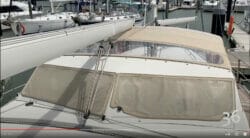
It seems a pity to have a nice safe traveler position like that and then lead the mainsheet in such a way as it can garrotte a crew member. If it were me designing the system I would go with a “German Mainsheet system” with the track where it is and the mainsheet double ended and lead back from blocks below the gooseneck to winches either side of the cockpit.
And yes, raising the mainsheet traveler closer to the boom enables windward sheeting with a shorter track.
Hey John, New to AAC, loving it so far, trying to soak up as much as I can. I am looking to re-rig my 1980 Ingrid 38 ketch, following the simple is best approach you teach here. We are preparing to sail her from San Diego to Japan (where we live) across the south pacific. Do you know any good riggers in the Southern California area? Boat is in San Diego.
Early this year I did a major refit of my Islander 36 with the excellent support of the Ventura Harbor Boatyard. Work completed included a rebuilt mast step, new cap/intermediate shroud chain plates, and new standing rigging. The boatyard recommended a local rigger, Kim Weir, and I was extremely pleased with his work. Without hesitation, I recommend the services of VHBY and Kim Weir.
Thanks for coming up on that.
Sorry, I have never sailed on the west coast, so don’t have any experience with riggers there. That said, Brian Toss’s old shop is still in business run by guys Brian taught, so that might be an option, although a ways from you: http://briontoss.com
Also see Steve’s comment.
No one has mentioned self-tacking jibs. Having owned two boats with them the thought of going back to winching every time you tack -particularly when singlehanded- fills me with horror. Huge genoas are, in any case, only a relic from ancient rating rules. Whether a jib boom ( particularly the internal boom as used on Freedom sloops) or jib traveller is used, short tacking becomes an effortless exercise. A small jib on a traveller can be trimmed more easily and efficiently than a Genoa. The mainsail is always the prime driver; the performance gain from oversized headsails is less than you think, and in these days of easily deployed offwind headsails is not a consideration off the wind.
I agree with most all you say, except I have never been a fan of jib booms, probably something to do with being naturally clumsy so I don’t need anything else to trip over on the foredeck!
Anyway, just loving sailing our J/109 with her big mainsail and blade jib.
On an otherwise good boat would you recommend moving the lines from the cockpit to the mast if you were going to have an e-wincher anyway, which would presumably overcome the extra friction while still giving the operator enough feel to know if something was going wrong?
Way too many variables to answer that: boat, usage, crew, how well the boat is set up with lines aft, and on it goes. That said, my 109 is lines aft and the wincher makes all the difference to practicality so I have no plans to change. That reminds me, I should do a tip on why.
- OC Wally Cento
- 84 Mini Maxi
- IMOCA Open 60
- Consultancy Services
- 30m Blue Water Cruiser
- 25m Explorer Yacht
- 24m Fast Cruising Catamaran
- 23m Performance Cruiser
- 20m Explorer Yacht
- 20m High Performance Cruiser
- 18m Blue Water Cruiser
- 15m Performance Cruiser
- 15m Explorer Yacht
- 12m Explorer Yacht
- Multihull Design
- 18m Explorer Yacht
- 40m Blue Water Cruiser
- 40m Cruiser Racer
- 33m Performance Cruiser
- 30m Wally Cento
- 24m ORCsy Racer Cruiser
- 24m Day Sailer
- Carbon Component Design
- Yacht Performance Development
- CFD and Model Testing
- Twin Rudder Steering Systems
- Custom Deck Hardware
- Modifications and Refit
- VPP Routing and Sail Analysis
- Classic Yacht Refit & Optimisation
- Naval Architecture
- Engineering
- Rudder Design
- Brokerage Services
- 'Seahorse Magazine' #192
- 'Divoc' #190
- Lucent #180
- Influence #171
- 'Eora' #169
- 'The Three Brothers' #168
- 'Edenred' #165
- 'BHB3' #163
- 'Teata' #148
- 'Kite' #144
- ‘Sensei’ #131
- 'Gryphon' #106
- 'Horizon' #104
- 'Sabre II' #93
- 'Letto Di Pletto' #47
- 'Mowgli' #41
- 'Graybeard' #39
- 23.8m Ultime Trimaran
- 20.7m Orma Trimaran
- 18.28m Orma Trimaran
- 16.75m Cruising Catamaran
- 16.1m Cruising Catamaran
- 12.8m Crowther Shockwave Catamaran
- 9.1m Seacart 30 Trimaran
- 26.3m Aluminium Sloop
- 21.0m Steel Schooner
- 21.0m Aluminium Cruising Ketch
- 20.0m Aluminium Explorer Yacht
- 20.0m Luca Brenta Racer Cruiser
- 19.6m Aluminium Bluewater Cruiser
- 19.2m Aluminium Lifting Keel Sloop
- 18.8m Custom Steel Sloop
- 16.0m Sly Cruiser Racer
- 14.5m Aluminium Cruising yacht
- 13.87m Wooden Motor Sailer
- 25.25m Reichel Pugh Maxi
- 18.28m IMOCA 60 Nexans WeWise
- 18.28m IMOCA 60 'Canada Ocean Racing'
- 18.28m IMOCA 60 Gentoo
- 18.28m IMOCA 60 One Planet
- 15.85m TP52 Georgia
- 15.84m TP52 Racing Yacht 'Alizee'
- 15.25m Pegasus Open 50
- 12.8m Fast 40
- 10.89m Figaro 3
- 10.11m Sun Fast 3300
- 19.2m Lifting Keel Sloop
- 14.5m Aluminium Cruising Yacht
| Owen Clarke Design, yacht designers and naval architects, exist to continually advance yacht design, fulfilling sailors' requirements for fast, beautiful sailboats. OC believe in innovative thinking and pushing technological frontiers achieving excellence in racing, cruising, and explorer yacht design. Sailing is our business and our passion. We are one of the world's leading companies of yacht designers and naval architects. OC specialise in custom sailing designs and naval architecture of racing boats and performance cruising, expedition and explorer yachts. Our studio has designed sailboats ranging from a 6.5m Mini Transat to a 76m superyacht, are specialists in the use of high-tech composite materials as well as experienced in more mainstream construction methods. Take your time to review the areas of our site that are relevant to you, after which we hope you’ll contact us at and/or: For an explanation of the technology behind the design process go to: For an insight into our engineering and detailed design work go to: |
Please use a modern browser to view this website. Some elements might not work as expected when using Internet Explorer.
- Landing Page
- Luxury Yacht Vacation Types
- Corporate Yacht Charter
- Tailor Made Vacations
- Luxury Exploration Vacations
- View All 3700
- Motor Yachts
- Sailing Yachts
- Classic Yachts
- Catamaran Yachts
- Filter By Destination
- More Filters
- Latest Reviews
- Charter Special Offers
- Destination Guides
- Inspiration & Features
- Mediterranean Charter Yachts
- France Charter Yachts
- Italy Charter Yachts
- Croatia Charter Yachts
- Greece Charter Yachts
- Turkey Charter Yachts
- Bahamas Charter Yachts
- Caribbean Charter Yachts
- Australia Charter Yachts
- Thailand Charter Yachts
- Dubai Charter Yachts
- Destination News
- New To Fleet
- Charter Fleet Updates
- Special Offers
- Industry News
- Yacht Shows
- Corporate Charter
- Finding a Yacht Broker
- Charter Preferences
- Questions & Answers
- Add my yacht
BAYESIAN Yacht Layout & GA Plans
56m / 183'9 | perini navi | 2008 / 2020.
- Amenities & Toys
Use two fingers to move the deck plan
Use ctrl + scroll to zoom the deck plan
Use ⌘ + scroll to zoom the deck plan
Zoomable Deck Plans Instructions To view the yacht General Arrangement / Deck Plans in more detail use the Zoom Tools + / - buttons to 'zoom in' or ' zoom out'. To navigate around hold down you mouse and drag to look around or for touch use two fingers to pinch and drag. To zoom with the mousewheel hold CTRL/⌘ and use the mouse wheel or use two fingers to scroll on an Apple touch pad.
NOTE to U.S. Customs & Border Protection
SIMILAR LUXURY YACHTS FOR CHARTER
Here are a selection of superyachts which are similar to Bayesian yacht which are believed to be available for charter. To view all similar luxury charter yachts click on the button below.

Bahriyeli C
55m | Custom
from $20,000 p/week ♦︎
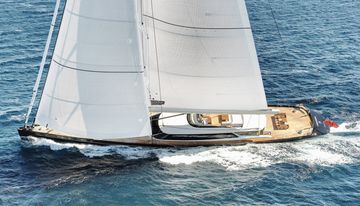
58m | Alloy Yachts
from $235,000 p/week
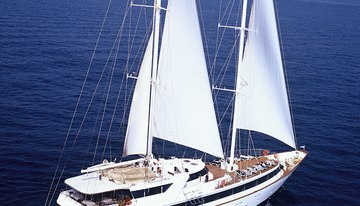
Pan Orama II
50m | Elthom
POA ♦︎

52m | Alloy Yachts
from $263,000 p/week ♦︎
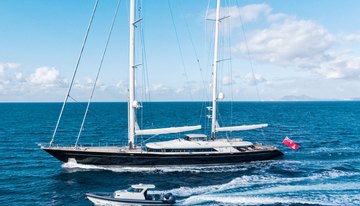
56m | Perini Navi
from $230,000 p/week

Baracuda Valletta
50m | Perini Navi
from $198,000 p/week ♦︎
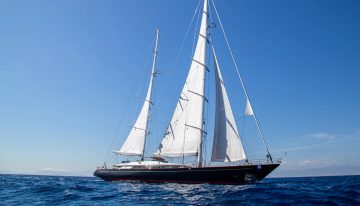
from $239,000 p/week ♦︎
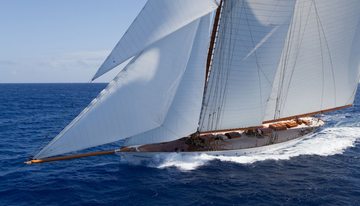
55m | Marin LuxurYachts
from $111,000 p/week ♦︎
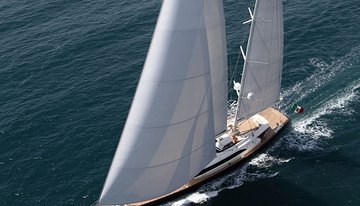
from $249,000 p/week ♦︎

55m | Vitters
from $184,000 p/week ♦︎
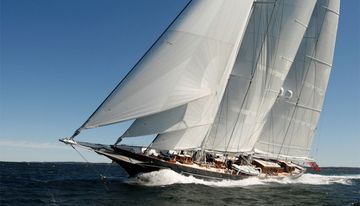
52m | Royal Huisman
from $126,000 p/week
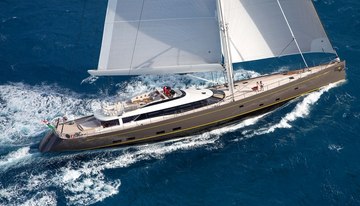
50m | Fitzroy
from $206,000 p/week ♦︎
As Featured In
The YachtCharterFleet Difference
YachtCharterFleet makes it easy to find the yacht charter vacation that is right for you. We combine thousands of yacht listings with local destination information, sample itineraries and experiences to deliver the world's most comprehensive yacht charter website.
San Francisco
- Like us on Facebook
- Follow us on Twitter
- Follow us on Instagram
- Find us on LinkedIn
- Add My Yacht
- Affiliates & Partners
Popular Destinations & Events
- St Tropez Yacht Charter
- Monaco Yacht Charter
- St Barts Yacht Charter
- Greece Yacht Charter
- Mykonos Yacht Charter
- Caribbean Yacht Charter
Featured Charter Yachts
- Maltese Falcon Yacht Charter
- Wheels Yacht Charter
- Victorious Yacht Charter
- Andrea Yacht Charter
- Titania Yacht Charter
- Ahpo Yacht Charter
Receive our latest offers, trends and stories direct to your inbox.
Please enter a valid e-mail.
Thanks for subscribing.
Search for Yachts, Destinations, Events, News... everything related to Luxury Yachts for Charter.
Yachts in your shortlist
Messing about in boats since 1975. Online Since 1997.
Home | Intro | Our Design Process | Stock Design Info | Motor Yacht Designs | Sailing Yacht Designs | Prototype Designs Plans List | Articles | Our CAD Design Stream | Maxsurf | News..! | SITE MAP..! | Site Search | Design Team | Contact Us Please see the AVAILABLE BOAT PLANS web page
Sailing Yacht Designs by Kasten Marine Design, Inc. Copyright 2016 Michael Kasten Updated June 2016 The sailing yacht designs listed below are arranged in order of their size, from the largest at over 164 feet (a traditional plank on frame wooden ketch) to the smallest at 8 feet (an aluminum sailing pram). New boat designs are added as they are developed (marked with the symbol) so you may want to bookmark this page and check in periodically... Please also have a look at our Prototypes page to see a number of new designs that are currently being developed or imagined. Ordering Study Drawings; Estimating Plans; Building Plans The majority of the designs listed below are available as Stock Designs, or are offered at a substantial discount versus the cost of developing a new Custom Design. For each design listed below, there is a link to a web page describing the design in detail. If more information is desired in order to start planning for construction, an Estimating Plans Set is available which includes a Structural Profile and Arrangement plus a complete Vessel Specification and a comprehensive Equipment List, all of which are essential aids for planning. The intent of the Estimating Plans Set is to provide enough information for any builder to give a firm estimate for construction of the vessel. Building Plans contain all the information actually needed to complete construction of the vessel. If you would like to order Study Drawings, Estimating Plans, or a complete set of Building Plans for any of these designs, please see the Plans List Page for additional detail, a summary of plans prices, and complete ordering information. See our Stock Design Page for a thorough description of what is included in a typical plans package. If you want to know what's involved in creating a Custom Design to suit your specific requirements, you'll find excellent detail on our Custom Design Page . Large Sailing Yachts As yachts, these larger vessels provide the height of luxury on the water, with ample space for an extended family or for chartering. These yachts are second to none... The 38m Pinisi AMANDIRA pictured above has been featured in many yachting magazines as well as Architectural Digest. Our 36m Pinisi Silolona has has won accolades in SE Asia Yachting as the best newly built sailing yacht in Asia in 2004, the year of her launch; and has achieved cameo appearances in Vogue magazine, the New York Times; La Figueroa, Time magazine, plus many yachting magazines.
50m Indonesian Sailing Pinisi - The 36m Silolona was the inspiration for this much larger Charter Pinisi.. At 50m (164 feet) there is ample room for luxury chartering throughout Indonesia with occasional forays to Malaysia, Thailand, the Andaman Islands and the Maldives. Designed to the structural standards of Germanischer Lloyds, this vessel will offer superior security, luxury and comfort. For more information about this design or other traditional wooden vessels, please inquire .
38m Sailing Pinisi, AMANDIRA - A 38 meter (125 foot) luxury wooden sailing yacht for occasional chartering, having deluxe accommodations for the owner, private staterooms for 8 additional guests, plus accommodation for 14 crew including dive master and guide. Designed to the standards of Germanischer Lloyd's for maximum safety and longevity. To be built in Kalimantan Timur (East Borneo). For more information about this design or other traditional wooden vessels, please inquire . Please also see our Plans List Page for a summary of Plan prices.
36m KLM, DUNIA BARU - A 36 meter (120 foot) luxury wooden yacht. This design is inspired by the present-day traditional Indonesian KLM types (motor sailors). The result is a luxury private yacht for occasional chartering, having deluxe accommodations for the owners, private staterooms for 10 guests, plus accommodation for 12 crew. Designed to the standards of Germanischer Lloyd's for maximum safety and longevity, and built in Kalimantan Timur (East Borneo). For more information about this design or other traditional wooden vessels, please inquire . Please also see our Plans List Page for a summary of Plan prices.
36m Pinisi, SILOLONA - Pictured above, the traditionally built Silolona , a wooden Indonesian Pinisi , measuring 36 meters (118 feet) on deck, was built in Kalimantan Selatan (South Borneo) for chartering throughout Indonesia. The intent of this design has been to provide a taste of traveling aboard a traditional sailing Bugis Pinisi, complete with Indonesian crew. Designed and built to the structural standards of the German Lloyd's rule, there is a generous measure of security, luxury and comfort for eight to sixteen charter guests (depending on which interior layout is preferred). For more information about this design or other traditional wooden vessels, please inquire . Please also see our Plans List Page for a summary of Plan prices.
36m Tern Schooner - A 36 meter (118') deluxe wooden sailing yacht. The interior is very open, yet will accommodate two owners, eight guests or family members, and four crew. This design has been inspired by the fast Privateer sailing vessels of yore. As such, the Tern Schooner is designed to perform well under sail. Twin engines provide top performance under power. Structure is according to Germanischer Lloyds throughout. For more information about this design or other traditional wooden vessels, please inquire . Please also see our Plans List Page for a summary of Plan prices.
33m Indonesian KLM - A 33m (108 foot) charter yacht in wood, sister to the 36m KLM listed above and the 30m KLM listed below. A luxury private yacht that can also be used for charters. Designed to the German Lloyd's rule for wooden ships for maximum structural integrity and long life. For more information about this design or other traditional wooden vessels, please inquire . Please also see our Plans List Page for a summary of Plan prices.
30m Pinisi, SI DATU BUA - Our original 36m Pinisi design has been an inspiration for a series of design studies, each of which share the same traditional aesthetic of the wooden Indonesian Sailing Pinisi. This smaller 30m (98 foot) version is intended for private use and occasional chartering throughout Indonesia. Designed to the structural standards of the Germanischer Lloyds, this vessel will offer superior security, luxury and comfort. For more information about this design or other traditional wooden vessels, please inquire . Please also see our Plans List Page for a summary of Plan prices.
30m Indonesian KLM - This 30 meter (98 foot) luxury wooden yacht is modeled after the present-day traditional Indonesian Kapal Layar Mesin . Literally translated, this means "boat-sail-machine." Although we would call this a "Motor Sailor" these craft are simply referred to in Indonesia as " KLM ." The concept here has been to create a private yacht that can also be chartered, and which has deluxe accommodations for the owner and guests, plus generous cabins for crew. For more information about this design or our other traditional wooden vessels, please inquire . Please also see our Plans List Page for a summary of Plan prices.
Zebulun 96 - Zebulun is a modern sailing yacht in all respects. Intended for fast all-ocean sailing. All aluminum construction; twin fin keels with ballast bulbs; twin rudders; three masts; fully battened sails; etc. The ultimate charter vessel, having nine private staterooms, for a capacity of 18 to 20 all together. Equally capable as a motor sailor or pure sailing vessel. Very impressive! Please see the Plans List Page for a summary of Plan prices.
Mermaid 61 - A classic Brigantine styled after the 1700's privateers. Planned for commercial use, there is a flexible-use space just forward of amidships that can be used as a 5 ton cargo hold, or a large workshop, as a twin cabin for charters, or as a general use cabin or dining hall for day charters or boutique cuisine evening cruises. Mermaid combines modern materials and a modern hull form with a traditional Brigantine styling that is true to its heritage even down to the carvings. For example, all aluminum or all steel hull construction with all aluminum spars and modern rigging materials. Please see our Plans List Page for a summary of Plan prices. For more information, please inquire .
Shiraz 56 - A a fast aluminum sailing yacht with classic styling in the Herreshoff tradition. Fully detailed for construction in aluminum complete with NC cutting files. Conceived as a motor sailor , with the emphasis on sailing performance. Two separate staterooms, large saloon and galley, even a bath tub! From the shelter of the 'midship cockpit one can watch other vessels fall astern as though they were tied to a coral head... Aluminum spars; ketch rig. If re-designed, wood or fiberglass are also possible (with substantial revisions to the plans). Please see the Plans List Page for a summary of Plan prices.
Lucille 50 - This vessel is in my view a proper motor sailor ! Lucille has a true pilot house, a real walk-in engine room, and private cabins for four. There are two versions, one having the wheel house aft, the other with the house amidships. Lucille has a rounded hull and very clean lines suited to steel or aluminum. If re-designed, wood or fiberglass are also possible (with substantial revisions to the plans). Aluminum spars, schooner rig. Please see the Plans List Page for a summary of Plan prices.
Many more sailing yacht concept designs can be found on our Prototypes web page.
Mid-Size Sailing Yachts
Jasmine 48 - An all aluminum junk rigged schooner - and a highly capable motor sailor as well! The request here was to design a blue water schooner with an easy to handle rig, a spacious interior and classic styling, then apply modern technology to all of that...! In this case all aluminum structure, free standing rig, electric motor propulsion, and a very comfortable interior. A rounded hull for construction in aluminum. Recently updated to include the concept of having a pilot house aft. If re-designed, wood or fiberglass are also possible (with substantial revisions to the plans). Please see the Plans List Page for a summary of Plan prices.
Redpath 44 - I designed Redpath for myself. Enough said. In my view she is simply beautiful. The idea was to create a simple and comfortable live aboard schooner for two. When left to my own devices, herein lies much of my preferred design approach. Though designed as an auxiliary sail boat, Redpath is also a true motor sailor . Aluminum spars, schooner rig. Hull construction in steel. If re-designed, wood or fiberglass are also possible (with substantial revisions to the plans). Please see the Plans List Page for a summary of Plan prices.
Redpath 44 - Okay, why is Redpath listed twice here...? We recently completed a conversion of the Redpath design to aluminum construction, including aluminum spars. We also completed new NC cutting files for aluminum construction (imperial dimensions). If re-designed, wood or fiberglass are also possible (with substantial revisions to the plans). Please see the Plans List Page for a summary of Plan prices.
Highland Lass 42 - Grace's big sister. A classic rig on the finest of single chine hull forms intended for steel or aluminum construction. Designed for performance cruising. Comfort for four. Luxury for two. Aluminum spars, schooner rig. If re-designed, wood or fiberglass are also possible (with substantial revisions to the plans). Please see the Plans List Page for a summary of Plan prices.
Benrogin 40 - A transom-stern rounded hull and clean lines ideally suited to steel, aluminum, fiberglass or plank on frame wood construction. Intended for family cruising. Two versions: one with a wooden deck for luxury, the other having a metal deck for simplicity and ultimate strength. If re-designed, wood or fiberglass are also possible (with substantial revisions to the plans). Please see the Plans List Page for a summary of Plan prices.
Greybeard 38 - A variation on Fantom. More displacement with a different interior and a slightly different look. Every bit the boat to live up to her name. With a rounded hull and easy lines Greybeard is ideally suited to steel or aluminum. If re-designed, wood or fiberglass are also possible (with substantial revisions to the plans). Aluminum spars, cutter rig. Please see the Plans List Page for a summary of Plan prices.
Fantom 36 - A round bottom double ended cutter in the Archer tradition. With a rounded hull and easy lines Fantom is ideally suited to steel or aluminum. This boat was designed for ultimate conditions with the intent to make the Northwest Passage. Aluminum spars, cutter rig. If re-designed, wood or fiberglass are also possible (with substantial revisions to the plans). Please see the Plans List Page for a summary of Plan prices.
Grace 36 - Can a metal boat have grace? Absolutely yes! One of the prettiest metal boats afloat, and a very easy shape to build. Designed for ocean voyaging in style. Aluminum spars, ketch rig. Hull construction in steel or aluminum. If re-designed, wood or fiberglass are also possible (with substantial revisions to the plans). Please see the Plans List Page for a summary of Plan prices.
Many more sailing yacht concept designs can be found on our Prototypes web page.
Pocket Size Sailing Yachts
Bedouin 28 - An excellent bilge keel yacht, the big sister to Sarah Cat. Trailerable and ocean worthy. Aluminum spars, cutter rig. Hull construction in aluminum. If re-designed, wood or fiberglass are also possible (with substantial revisions to the plans). Preliminary drawing available; please inquire .
Sarah Cat 23 - A centerboard boat with a classic fantail stern. Tabernacle mast for easy trailering. The most economical of cruising boats. Aluminum spars, cutter rig. Hull construction in aluminum. If re-designed, wood or fiberglass are also possible (with substantial revisions to the plans). Please see the Plans List Page for a summary of Plan prices.
Larger and smaller preliminary designs in this size range can be found on our Prototypes web page.
Yacht Tenders
The Pram - The pram hull form has the most carrying ability within the least length. Being flat bottom, these sailing prams take the beach gracefully, and they are easily stowed. Sizes range from 8' to 14' with construction in aluminum, plywood or fiberglass. Please see the Plans List Page for a summary of Plan prices.
Please see the AVAILABLE BOAT PLANS web page. Home | Intro | Our Design Process | Stock Design Info | Motor Yacht Designs | Sailing Yacht Designs | Prototype Designs Plans List | Articles | Our CAD Design Stream | Maxsurf | News..! | SITE MAP..! | Site Search | Design Team | Contact Us
- All Web Site Graphics, Layout, and Written Content at this Domain Created by Michael Kasten.
- All Graphic and Written Materials at this Domain Copyright © 1989 - 2023 Michael Kasten.
- All Content Registered with US Library of Congress and US Copyright Office.
- Copyright Violations will be Prosecuted. All Rights Reserved.
- Yachting World
- Digital Edition

Video: See inside 9 of the most amazing modern sailing superyachts
- September 10, 2020
Sailing superyacht technology has come on in leaps and bounds in recent years - we take a closer look at nine of the most stunning examples...
1. Aquarius
The brief for Aquarius included that she should be, ‘an elegant, muscular sailing yacht with a classic profile for family enjoyment.’ But that barely scratches the surface of the main requirements for this giant ketch. The owners also wanted a yacht that would combine good seakeeping characteristics with performance, reliability and quality.
Essential features included relative simplicity, robustness of systems and a contemporary interpretation of elegant, classic lines, with a clean and uncomplicated appearance. Aquarius ’s graceful lines and timeless shape belie a rugged world cruiser configured to be self-sufficient for extended periods when voyaging well beyond the popular Med and Caribbean circuits. In addition, the yacht is welcoming for family and friends, while providing sufficient performance to compete in superyacht regattas.
Specifications
LOA: 56.18m (184ft 4in) LWL: 41.17m (135ft 1in) Beam: 9.51m (31ft 2in) Draught: 4.80m (15ft 9in) Displacement: 264 tonnes (591,360lbs) Mainsail: 520m2 (5,597ft2) Mizzen: 440m2 (4,736ft2) Blade: 430m2 (4,628ft2) Air draught: 58.50m (192ft 11in) Spars: Rondal carbon with Rondal/Carbo-Link continuous standing rigging Builder: Royal Huisman Launched: 2017

Photo: Baltic Yachts
2. Pink Gin VI
The Baltic 175 Pink Gin may have captured most of the headlines for her sheer size and cleverly engineered topside balconies, but below decks a collection of Cuban art and some phenomenal styling demand equal attention.
Mark Tucker’s team at Design Unlimited in the UK worked closely with the yacht’s owner, Professor Hans Georg Näder, with whom they had co-operated on his previous Pink Gin , to produce an unusual exercise in interior styling.
LOA: 53.90m (176ft 10in) LWL: 45.27 m (148ft 6in) Beam: 9.55 m (31ft 4in) Draft: 4.50-7.00 m (14ft 9in – 22ft 12in) Displacement: 250 tons (560,000lbs) Ballast: 79 tons (176,960lbs) Naval architect: Judel/Vrolijk & co Interior: Design Unlimited Builder: Baltic Launched: 2017
Article continues below…

Liara: The Baltic 112 superyacht designed to cruise the world in supreme comfort
Over the past decade we’ve been treated to the rise of the custom built cruiser-racer. Arguably inspired by the success…

Aquarius: Modern classic masterpiece makes for a surprisingly sensible superyacht
A demanding brief for Aquarius from experienced sailors has produced a masterpiece from some of the most experienced and talented…

The Baltic 142 Canova may not be using the hydrofoils popularised by the America’s Cup , but her 29ft 6in long (9m) horizontal sliding foil employs the same principle of lift to reduce heel and boost speed. The designers of the Dynamic Stability System (DSS) say it could improve the performance of this super-cruiser by 20 per cent, delivering a sustained 25 knots – not bad for a superyacht that displaces 146 tonnes. This is the first time the DSS has been used in superyachting, but its benefits will be used for comfortable, fast long-distance cruising rather than gaining an edge on the racecourse.
With styling and interior design by Lucio Micheletti as well as the in-house team, Canova sports a sleek, low deck saloon with a hard, fixed bimini extending over the forward cockpit area. Below, her vast deck saloon, providing panoramic views, forms the focal point of her luxury accommodation.
Unusually, the owner’s suite is located almost amidships, where motion is at its least, with further accommodation for six guests in three cabins. Other features include a Rondal rig with electric in-boom furling, a lifting keel and a propeller leg rotating through 180 degrees.
LOA: 43.3m (142ft 1in) LWL: 41.6m (136ft 6in) Beam: 9.m (29ft 6in) Draft: 3.8-6.5m (12ft 6in-21ft 4in) Displacement: 146.5 tons (328,160lbs) Naval architect: Farr Yacht Design Interior design: Baltic Yachts / Lucio Micheletti Exterior design: Lucio Micheletti Builder: Baltic Launched: 2019

Photo: Perini Navi
Part of the world’s largest sailing yacht series by length, Seven is hull number 3 in Perini Navi’s 60m ketch series, after Seahawk and Perseus 3 . Launched in 2017, she was feted for her groundbreaking interior lighting design throughout all five guest cabins. A powerful motor-sailer, her twin MTU engines and 47,000-litre fuel capacity mean a globe-trotting range of 3,600nm when motoring at 12 knots.
LOA: 60m (197ft) LWL: 50.4m (165ft 4in) Beam: 11.4m (37ft 4in) Draft: 4.3m-12.3m (14ft 1in – 40ft 4in) Mast height: 62.2m (204ft) Total sail area: 2,097 m2 (22,572ft2) Displacement: 575 tonnes (1,288,000 lbs) Naval architect: Ron Holland / Perini Navi Builder: Perini Navi Launched: 2017

Photo: Gilles Martin-Raget / Wally
This may be the fourth 100ft yacht designed to the Wallycento box rule, but it’s one that raises the bar with regard to combining form and functionality with outrageously cool aesthetics. Considering that Wally is yachting’s deity of style, that’s saying something.
Tango is at the very forefront of modern fast monohull design and advanced technology. Its stealthy black livery and long, low lines combine with a bold reverse sheerline to create a potent, powerful look. The ruthlessly clean deck is signature Wally. The image of the single helmsman on deck, with all that power and beauty controlled simply by the touch of a network of buttons on the pedestals, has become an icon for the Italian brand.
LOA: 30.48m (100ft) Beam: 7.20m (23ft 7in) Draught: 4.4-6.2m (14ft 5in-20ft 4in) Displacement (light): 47,500kg (104,720lb) Upwind sail area: 640m2 (6,889ft2) Downwind sail area: 1,398m2 (15,048ft2) Naval architecture: Mills Design Exterior design: Wally / Mills Design Interior design: Pininfarina Builder: Persico Marine Launched: 2017

Photo: Breed Media
The owner’s brief for Ngoni would be challenging for any size of yacht: “Build me a beast. Don’t build me a sheep in wolf’s clothing. This has to be an edgy and innovative weapon; fast and furious.” When the boat in question is a giant 58m (190ft) sloop with a displacement of nearly 400 tonnes this project was always going to push hard against existing boundaries of design, deck hardware and materials technology.
“The owner wanted me to take a fresh look at large yacht design,” Dubois recalled before his untimely death four years ago. “He wanted me to go back to my roots in the late 1970s and ’80s when we were designing race boats, but he also knew we had designed a number of high-performance yachts that were nevertheless seaworthy and comfortable cruisers. So I had to reset my internal computer, if you like, and look hard at how we could save weight and add strength.
“That’s how the reverse sheer came about. I was worried he might not like it. The next time we met in London I showed him the design and he loved it – in fact he gave me a big bear hug!”
LOA: 58.15m 190ft 9in LWL: 51.20m 167ft 12in Beam: 9.54m 31ft 4in Draught: 5.3m-81m (17ft 5in-26ft 7in) Displacement: 353 tons (778,224lb) Upwind sail area: 1,950m2 (20,989ft2) Downwind sail area: 3,093m2 (33,293ft2) Air draught: 75m (247ft) Naval architect: Ed Dubois Interior design: Paul Morgan / Rick Baker Builder: Royal Huisman Launched: 2017

Photo: Vitters Shipyard
Ahimsa is a 216ft sloop-rigged aluminum yacht, designed by the late Ed Dubois. Built with a combination of innovation and advanced technical craftsmanship, Ahimsa boasts a low superstructure and deck clean. Key features include the ability to hoist her mainsail in less than two minutes and tack the boat within 30 seconds.
The 83m carbonfibre mast is the largest ever produced by Southern Spars and had to be transported to The Netherlands in two pieces. As if that wasn’t impressive enough, Ahimsa ‘s Code 1 sail is the world’s largest artwork on canvas, designed by the Norwegian artist Magne Furuholmen.
LOA: 66m (216ft 6in) Mast height: 83m (272ft 4in) Naval architect: Ed Dubois Builder: Vitters Launched: 2012
Svea , the newest addition to the now nine-strong J Class fleet, is one of the most outstanding new yachts of modern times – a harmonious meeting of historic and modern design; a blend of J Class lines and maxi grand prix yacht technology.
All Js dazzle on the water, but Svea simply stops you in your tracks. Her lines and deck are kept spectacularly clean, thanks to the compact wheelhouse, sunken wheel and wonderfully low boom.
Her dark metallic grey hull and black and red sail wardrobe lend her timeless lines a slightly menacing appearance – a purposeful racing look that belies the luxurious interior below decks. The aggressive aesthetics are in keeping with her name, a Viking word (it means Swede).
LOA: 43.6m (143ft 1in) Interior design: Pieter Beeldsnijder / deVos deVries design Builder: Vitters/Bloemsma Launched: 2017

Not only is Liara a masterpiece of style, thanks to UK-based super designers Malcolm McKeon and Adam Lay combining to stunning effect, but she clearly represents a formidable amount of experience. And that all stems from the boss.
This is the fourth Liara for British serial yacht owner Tony Todd, who is now in his seventies. His initial brief was for a safe, comfortable family cruising yacht for circumnavigating the globe , hence the deep and well-protected cockpit. However, Todd has been racing yachts all his life, and once his competitive side kicked in and the odd regatta was mentioned, the speed, weight and deck layout to make this possible became critical features. The result is Liara , the definitive multi-role superyacht.
Specification
LOA: 112ft 0in (34.14m) LWL: 105ft 0in (32.00m) Beam: 25ft 11in (7.90m) Draught: 13ft 0in-20ft 2in (3.95m-6.15m) Displacement (light): 88 tonnes (194,000 lbs) Design: Malcolm McKeon / Adam Lay Builder: Baltic Launched: 2019
Sign-Up for News & Stories
Stephens Waring Yacht Design
Spirit of Tradition Yachts Designed In Maine
Home » News » SWD News & Stories » 7 Trends in Sailing Yacht Interior Design
7 Trends in Sailing Yacht Interior Design
Posted on March 14, 2023 and filed under SWD News & Stories
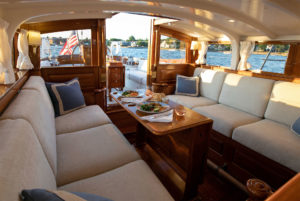
Interior designer Martha Coolidge, working with Stephens Waring Design, fine-tuned the style of the woodwork detail, panel layouts, light fixtures, and other elements of 65-ft ANNA’s appearance. Photo credit: Alison Langley
There’s some irony when it comes to looking at the hottest interior design trends for custom sailing yachts: much of the inspiration for today’s designs draw from the past – combined with modern innovation.
Interior designs that emphasize simplicity, balance, and natural materials are hardly revolutionary. Quite the opposite. But there is a new take and balance between old and new, iconic and innovative, that seems to provide the perfect balance for creating incredible interior spaces.
We’re exploring the top 7 trends in custom yacht design for 2023.
Natural Light and Connection Between Interior and Exterior Spaces
The use of larger windows is a trend that has been gaining popularity in yacht design in recent years, as yacht owners increasingly want to maximize their views of the surrounding environment and bring more natural light into their living spaces.
One way that yacht designers are incorporating larger windows is by using high-strength glass materials that can withstand the harsh marine environment. For example, tempered glass or laminated glass with multiple layers can provide the necessary strength and durability to withstand the wind, waves, and impact from flying debris.
In addition to using strong glass materials, yacht designers are also using innovative engineering techniques to maximize the size and placement of windows. Lightweight structural materials such as carbon fiber and titanium in the yacht’s construction, allow for larger windows without compromising the yacht’s structural integrity. In the photo of ANNA, above, the white-painted transverse structural knees are part of a carbon fabrication that strengthens the cabin and carries the mainsheet loads while blending into the classic joinery.
M ulti Functionality and Flex Spaces
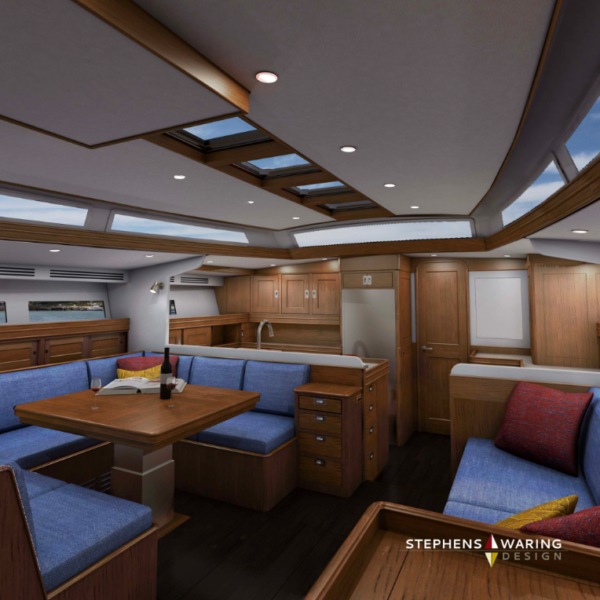
The design for 68-ft CIRRUS comes from blending 40’s & 50’s era style. The large saloon is designed to provide long-term comfort and versatility with innovative vertical storage and a vaulted ceiling that includes panoramic angled glass as well as overhead skylights. Design by Stephens Waring under construction at Jim Betts Enterprises.
Owners are spending more time aboard their vessels and are adding to the list demands and programmatic needs. These include home-office, fitness centers, gourmet kitchens, and gathering places for family and friends to spend longer durations of time together.
Because space is at a premium on a yacht, designers are creating multi-functional spaces that can serve multiple purposes. For example, a seating area that can be converted into a bed or a dining table that can be lowered to create additional seating. Clever storage solutions are also being incorporated into yacht design to make the most of available space.
Old World Charm Meets Modern Sensibilities: Spirit of Tradition
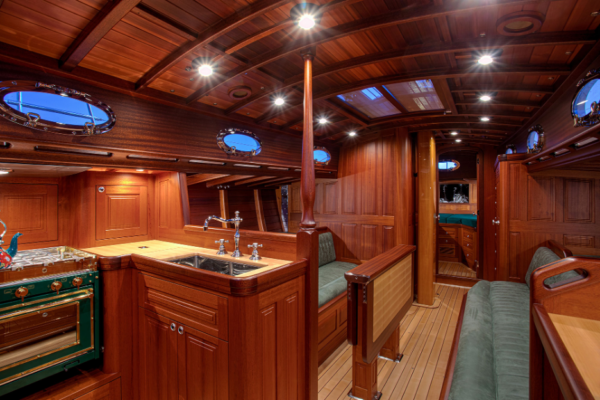
44-ft ITALMUS blends a 1940’s vernacular into the stylistic details and overall aesthetic of the yacht. The interior styling and design is aimed to mirror the era with a theme of highly crafted raised paneling and elegant joinery detail of select quarter sawn mahogany and finished in satin varnis. Design by Stephens Waring, built by Van Dam Classic Boats. Photo credit: Billy Black
Yacht designers have always had a particular reverence for heritage and history. The notion of heading out to sea conjures images of bygone eras past. Capturing that essence requires a balance that avoids becoming kitsch or contrived. While mid-century design may be considered the hot design trend of 2023, as designers steeped in a Spirit of Tradition design philosophy, we feel we’ve never left the genre.
Spirit of Tradition designs embody some historically identifiable link, particularly expressed in the shape and aesthetic exhibited in the design form of the hull and superstructure. Equally important, a Spirit of Tradition vessel must embrace modern development in materials, construction methods, mechanical systems and naval architecture science. Without the Spirit in development, we’re left with only Tradition.
Natural Materials
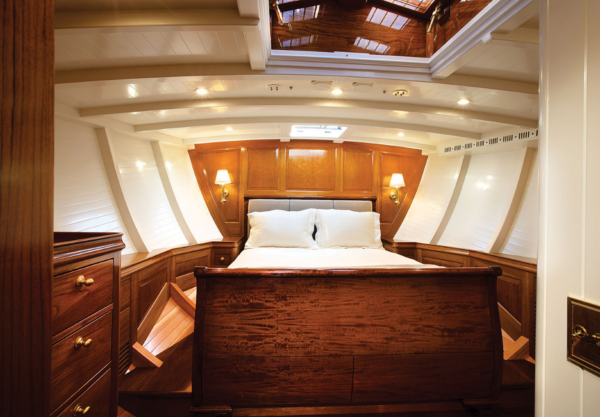
Douglas fir deck beams, traditional raised and v-groove paneling, bright varnish and white painted surfaces make it a light, airy enclave. Interior design by Martha Coolidge and Stephens Waring Design. Boat construction by Lyman-Morse. Photo credit: Alison Langley
Yacht owners by their very nature are drawn to water and the natural world, so it makes sense to incorporate natural elements such as wood, stone, and other organic materials in design. These materials create a sense of warmth and connect the interior spaces to the natural surroundings.
As experts in wooden boat design, we have long touted the benefits of timber for structural elements. However, incorporation of hardwoods, as well as a growing trend in sustainable timbers, have become increasingly popular with owners looking to achieve aesthetic, durability, and sustainability objectives in interior design.
Other natural materials such as leather and wool are also being incorporated to add texture and comfort. These finishes not only look beautiful, but they are also durable to withstand the harsh marine environment.
Renovation and Restomods
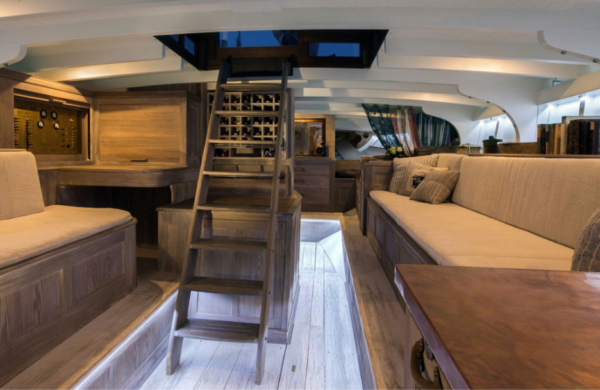
The owner of Marilee (built in 1926) had the bold vision to create an interior that reflected the yacht’s century-long provenance while creating an open space below. The team worked with Paul Waring of Stephens Waring Yacht Design, to create a traditional and properly constructed interior with an updated layout for relaxed, modern day use. Photo credit: Alison Langley
The popularity of restomods has been well established in the world of classic cars, but it has only recently grown in popularity in the world of yachting. Fortunately, this is changing with plenty of success stories to point to. Restomods are ideal for owners looking for cost-effective transformations that maintain sentimental connections to vessels and deliver stunning customized spaces that can be more cost effective than new custom builds. They are also popular with owners who inherit family boats, but need more utility and comfort for future generations.
Historical interiors often lack the ergonomics and amenities most owners seek today. Good restoration projects embrace as much of the original charm and character of the original design as possible while improving comfort and livability. Upgrades to electrical systems, electronics and navigation, plumbing and propulsion systems are low hanging fruit. The interior design aesthetics requires a careful and complementary approach which honors the original character while updating comfort, utility, and aesthetics.
Flexible Spaces for a Crew Cabin
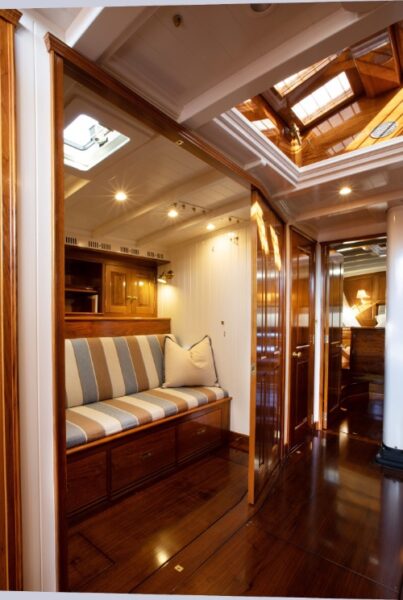
65-ft ANNA’s design includes a unique pocket door system. The design provides an easy way to expand square footage when the cabin is not needed or to private a comfortable extra cabin or crew quarters when extra hands or guests are aboard. Design by Stephens Waring. Construction by Lyman Morse Photo credit: Alison Langley
Owners often struggle with the balance between the desire for a larger vessel with larger interior spaces and the challenge of maintaining a total vessel size (and cost) which is manageable.
As we get older the idea of managing and skippering our own vessel can come at the expense of enjoyment. Hiring crew alleviates some of the operational challenges and burdens, but it also means sharing interior space with others.
Flexible crew cabins provide a cost effective way to optimize space for when crew is and isn’t aboard. One solution is the installation of pocket doors on sleeping quarters. This converts square footage from private berths (crew quarters) to main salon gathering space when doors are opened and transforms the space to private rooms for guests and crew when needed.
Smart technology
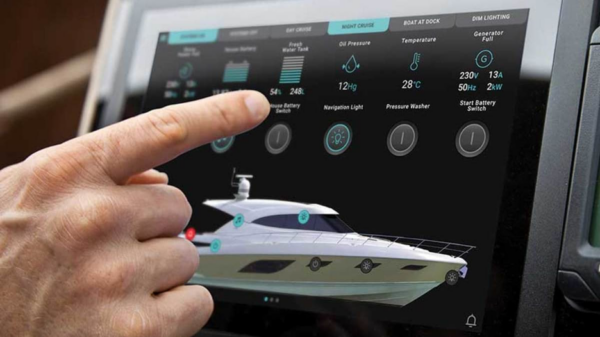
Yacht owners are increasingly interested in incorporating smart technology into their vessels. This includes lighting, climate control, entertainment systems, and security features that can be controlled remotely. Smart technology allows yacht owners to control the environment on board and manage energy consumption more efficiently. It also adds an extra layer of security by allowing the owner to monitor their yacht from afar.
Related Articles:
A Clients Dream Crystalized in Spirit of Tradition Style
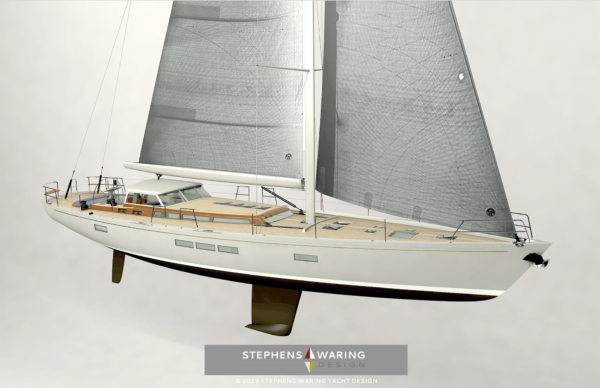
Pushing the Edge of Accommodations Design
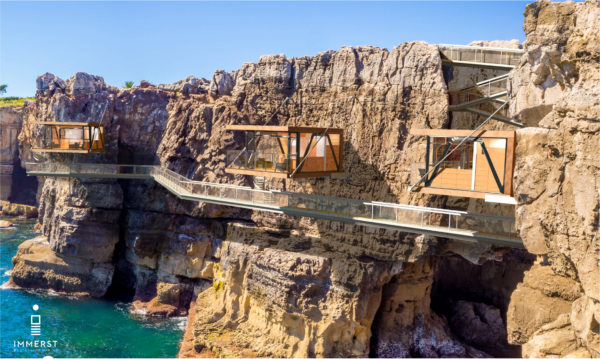
Boat Renovations and Restorations 101
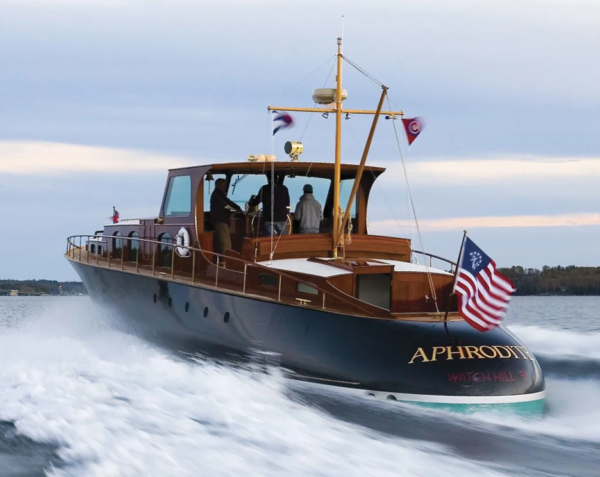
Yacht Philosophy: How to Make Small Spaces Feel Big

site by: slickfish studios
- Tourist Attractions
- Tourist Attractions in Russia
- Novgorod Oblast Tourist Attractions
Veliky Novgorod
The whole city of Veliky Novgorod is a big museum; there are many well-preserved monuments dating back to the 11th century and later centuries.

Veliky Novgorod attractions
Novgorod kremlin, trade side and yaroslav’s courtyard, st. george's monastery, vitoslavlitsy museum of wooden architecture.

Request a private tour, tailor-made for individuals and small groups to meet your needs and preferences.

Discover historical attractions of Veliky Novgorod
- Private trip from St. Petersburg
- Visit Novgorod Kremlin and the Cathedral of St. Sophia
- Explore Yaroslav’s Court with its medieval churches
- Pick-up and drop-off at your hotel
Group of 2: 16000 Rubles/person
- Ask a question

IMAGES
VIDEO
COMMENTS
The sail shape is a fundamental aspect of sail boat design, directly impacting its speed, windward performance, and maneuverability. There are several types of sail shapes, including: 1. Bermuda Rig: The Bermuda rig is a widely used sail shape known for its versatility and performance. It features a triangular mainsail and a jib, offering ...
43 of the best bluewater sailboat designs of all time
A well-designed keel adds stability but also increases draft, limiting where the boat can sail. Rudder design must account for both responsiveness and the risk of stalling at high speeds. 4) Sail & Rig Design. Sail and rig design play a pivotal role in harnessing wind power. Sail choice, size, and shape are tailored to the boat's intended use ...
In front of the main mast is called a foremast. The 5 most common two-masted rigs are: Lugger - two masts (mizzen), with lugsail (cross between gaff rig and lateen rig) on both masts. Yawl - two masts (mizzen), fore-and-aft rigged on both masts. Main mast much taller than mizzen. Mizzen without mainsail.
Cockpit design and layout drives many boat-handling tasks, ranging from steering and sail trimming to what goes on when its time to reef. Angles of view can even affect watchkeeping. For example, a high center cockpit and a large overlapping genoa create a 90-degree-plus no see zone, and thats a big deal when it comes to collision avoidance.
Assent 's performance in the 1979 Fastnet Race makes the Contessa 32 a worth entry in the 25 best small sailing boat designs list. Credit: Nic Compton. Designed by David Sadler as a bigger alternative to the popular Contessa 26, the Contessa 32 was built by Jeremy Rogers in Lymington from 1970. The yacht's credentials were established when ...
The first is the displacement to length ratio. The formula to calculate it is D / (0.01L)^3, where D is displacement in tons and L is waterline length in feet. But most sailboat specifications, like those found on sailboatdata.com, list the D/L Ratio. This ratio helps understand how heavy a boat is for its length.
Sailboat Design: Stability, Buoyancy and Performance. Simply stated, the first requirement of sailboat design is that the yacht designer's creation is seaworthy; particularly in that it stays afloat and is highly resistant to capsize - but of course we expect rather more than that... Good sailing performance, particularly to windward, will be ...
Boat design and boatbuilding projects, plans, concepts, reviews, and resources. Sailboat, multihull, powerboat, and yacht manufacturers and custom builders. Directory of yacht designers and naval architects, gallery of design work, and active boat design and boat building discussion forums.
After a 30 year absence, a veteran marine journalist returns to the US Sailboat Show and discovers the many changes in cruising boat design and construction. By Dan Spurr. Updated: June 10, 2020. The X-Yachts 46 displays the wide beam, twin wheels and open transom that define many 2020 models. Jon Whittle.
To highlight how these boat design principles play out, Practical Sailor looks at classic sailboats such as the Bill Shaw-designed Pearson 32, Ericson 41, Valiant 40, and Peterson 44, and compares their keel/sail ratios and lead values to more modern sailboat designs such as the Catalina, Hunter, Tartan, and Beneteau. ****.
Sailboat Deck Layouts. John Harries. Aug 28, 2020. 49 Comments Reading Time: 10 minutes. I'm going to use the Outbound 46 as a base to write about optimal deck layouts for sailboats. Information that will help anyone to either select a good deck layout when buying a boat, or fix a screwed-up one on a boat they already have.
We are one of the world's leading companies of yacht designers and naval architects. OC specialise in custom sailing designs and naval architecture of racing boats and performance cruising, expedition and explorer yachts. Our studio has designed sailboats ranging from a 6.5m Mini Transat to a 76m superyacht, are specialists in the use of high-tech composite materials as well as experienced in ...
Classic boat design both for the experienced amateur and the professional boatbuilder - rowing/sailing dinghies, powerboats, cruising yachts, sailboats, schooners. Skiffs, Trawlers, and a beautiful collection of twin-keel, monohull, and multihull sailboats. Site also features a collection of technical articles covering such things as stability ...
Here are a selection of superyachts which are similar to Bayesian yacht which are believed to be available for charter. To view all similar luxury charter yachts click on the button below. View all Similar Yachts. Interactive, detailed layout / general arrangement of BAYESIAN, the 56m Perini Navi Yachts super yacht with naval architecture by ...
36m Tern Schooner - A 36 meter (118') deluxe wooden sailing yacht. The interior is very open, yet will accommodate two owners, eight guests or family members, and four crew. This design has been inspired by the fast Privateer sailing vessels of yore. As such, the Tern Schooner is designed to perform well under sail.
8. Svea. Svea, the newest addition to the now nine-strong J Class fleet, is one of the most outstanding new yachts of modern times - a harmonious meeting of historic and modern design; a blend ...
The open layout concept comes directly from residences that have merged kitchens and living rooms. According to Tim Gosling, "Space and sound is always at the forefront of yacht design. In a media room for example the sound must be calibrated to ensure the guest and crews can sleep and the privacy respected." Changes in Layout
7 Trends in Sailing Yacht Interior Design
Answer 1 of 2: Planning to visit Novgorod from St Pet by car in Mid June 2014, reaching at @ 11.30 am. On way to Moscow. One option is to take same day night train at 9.15 pm to Moscow. Other option is to take next day same train at night. Then we get next day...
Veliky Novgorod - Wikipedia ... Veliky Novgorod
Novgorod Kremlin (Detinets): Novgorod "the great" ... well named! - See 1,418 traveler reviews, 2,455 candid photos, and great deals for Veliky Novgorod, Russia, at Tripadvisor.
The main exhibitions of Novgorod Museum are located in a two-storied building of Public Offices Chambers on the territory of the Kremlin. The most interesting parts of the exhibition are the collection of Russian icons of the 11th - 19th centuries, birch bark manuscripts, handicrafts, military equipment and other artefacts from ancient times till the end of the 17th century.